Website: tropicalnorthqueensland.org.au/listing/itinerary/creb-track/ [↗️]
Map: Hema Cape York Atlas & Guide (hemamaps.com [↗️])
Pub: Lions Den Hotel (lionsdenhotel.net.au/ [↗️])
It recently announced that it is dropping petrol-only variants of popular cars – like Corolla and Camry, as well as popular SUVs like RAV4 and Kluger – and replacing them with hybrid motivated versions.
This is not surprising when you consider that Toyota has been at the forefront of hybrid technology with vehicles such as Prius and other models for more than 20 years now, and these have paved the way for current and future model hybrids with more evolved petrol/electric systems.
Most of those 4×4 vehicles are powered by the 1GD-FTV 2.8-litre four-cylinder diesel engine, and earlier this year Toyota introduced a 48-volt starting and charging system on some of the HiLux variants that use this engine. But Toyota doesn’t call this ‘mild-hybrid’ a hybrid at all, instead opting for the term ‘V-Active’ technology’.
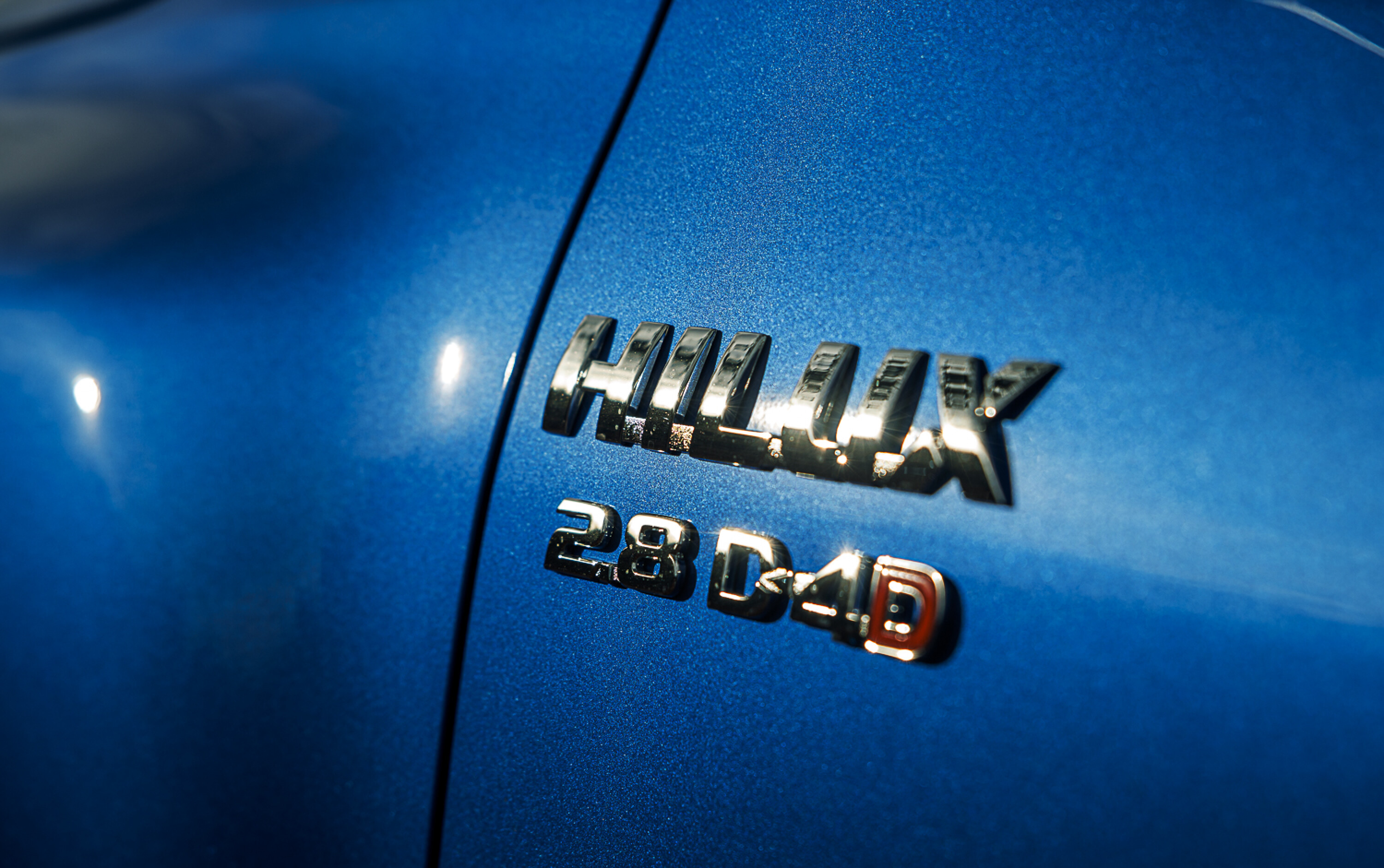
Expect V-Active to filter through to other Toyota vehicles that use the 1GD-FTV diesel engine; Toyota has already confirmed the new J250 Series Prado will be powered exclusively by this engine when it arrives to market later this year.
We grabbed some wheel time in a HiLux SR5 double-cab 4×4 that features the V-Active system. The popular SR5 starts at $63,260 (+ORC) and this particular vehicle also included the Premium interior pack and premium paint which add $2500 and $675 respectively.
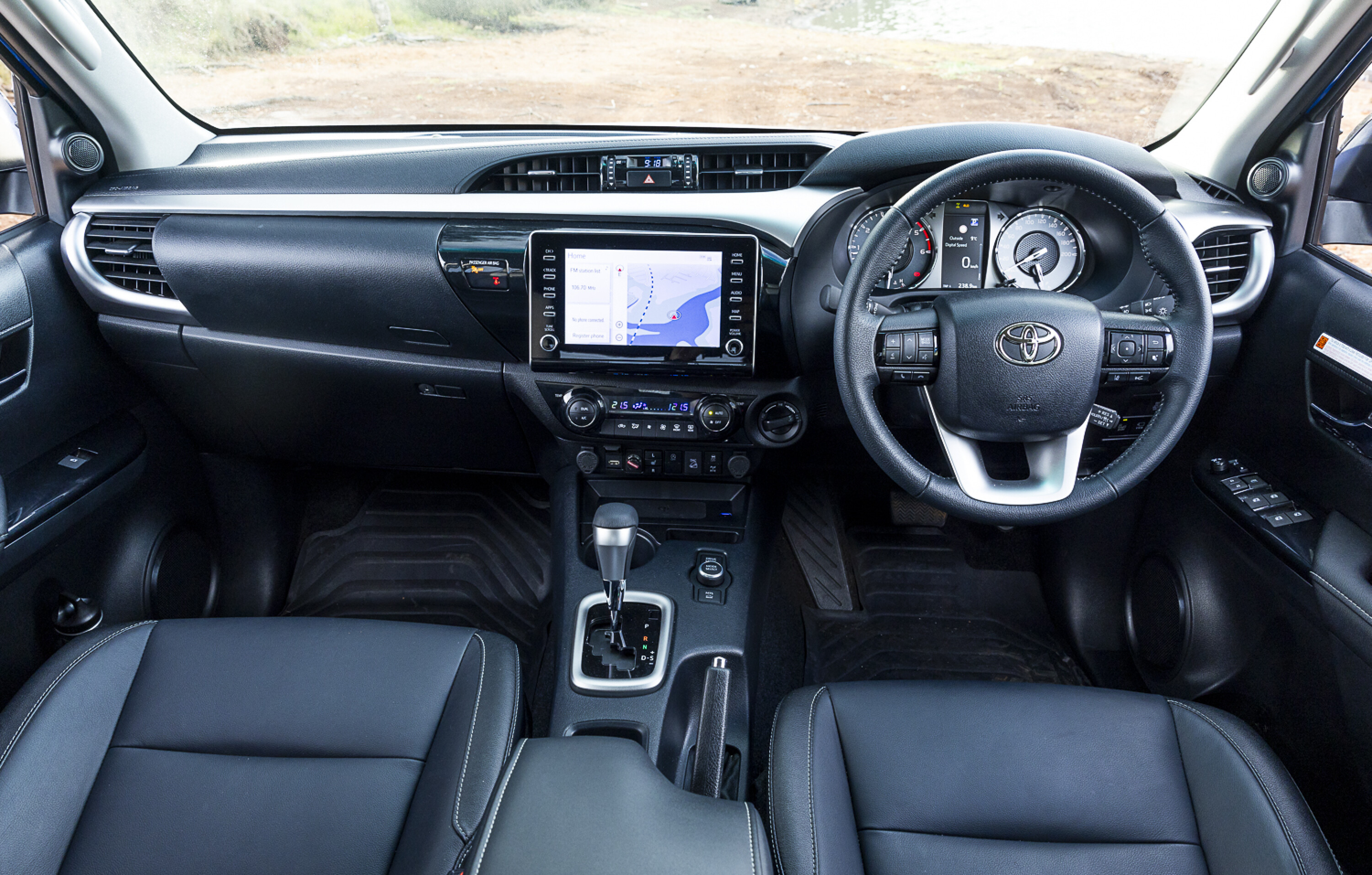
V-Active uses a belt from the engine to drive a compact motor generator that charges the 48v lithium battery which is situated under the rear seats. The battery comprises 13 cells with a capacity of 4.3Ah and it weighs just 7.6kg. Power from this battery runs through a DC-DC converter to power the vehicle’s regular 12V electrics.
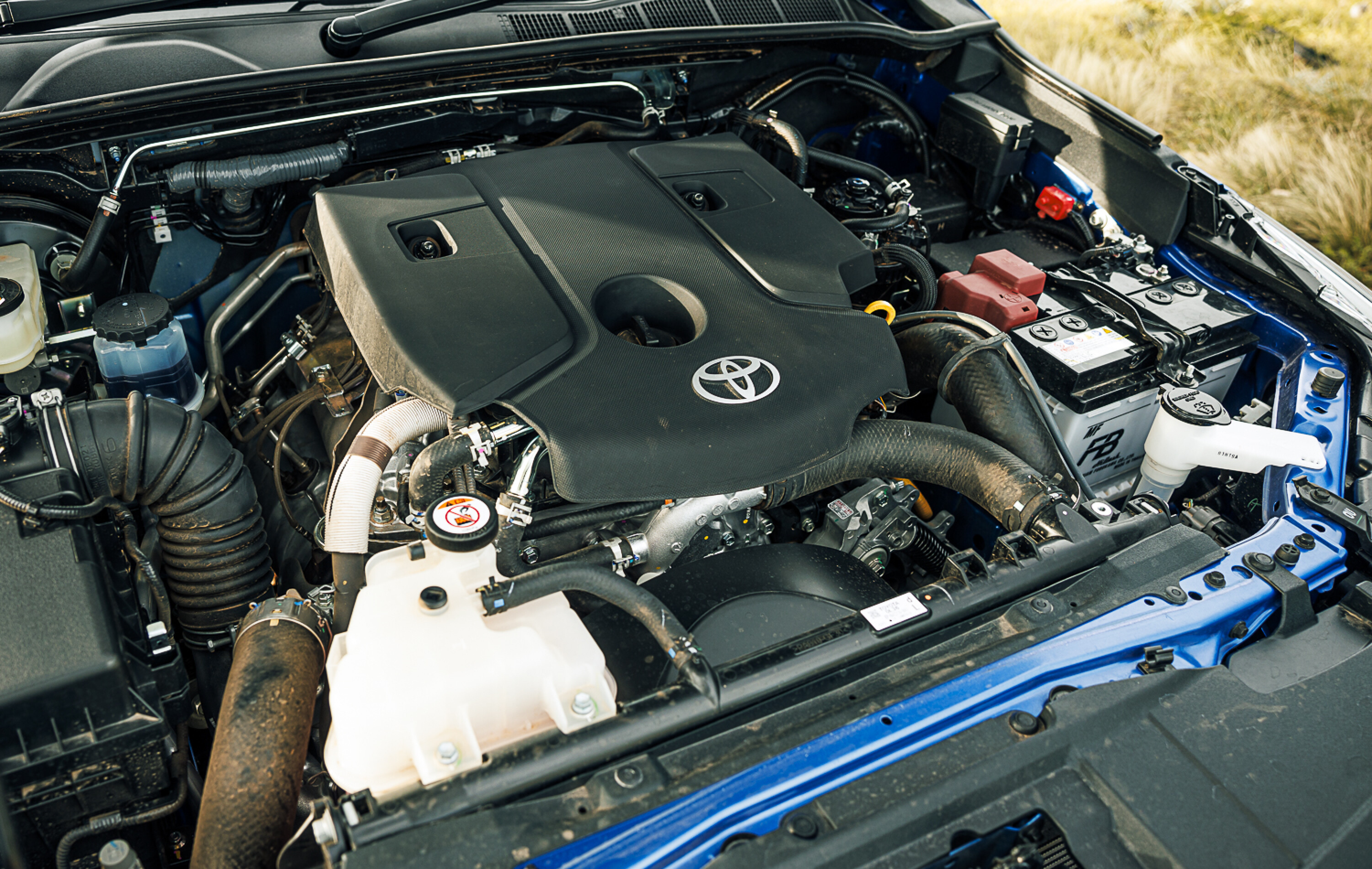
Without the opportunity to drive a V-Active-equipped HiLux back to back with a standard diesel variant, it’s difficult to feel any difference in performance; the 150kW/500Nm diesel engine feels as peppy as ever. Interestingly, Toyota doesn’t quote different power and torque figures for the engine with V-Active.
Of greater benefit is the way V-Active smooths out idle stop/start systems, and Toyota has now included such a system in the 2024 HiLux. Thankfully you can switch it off via a dash button, but you will need to remember to do that after each restart.
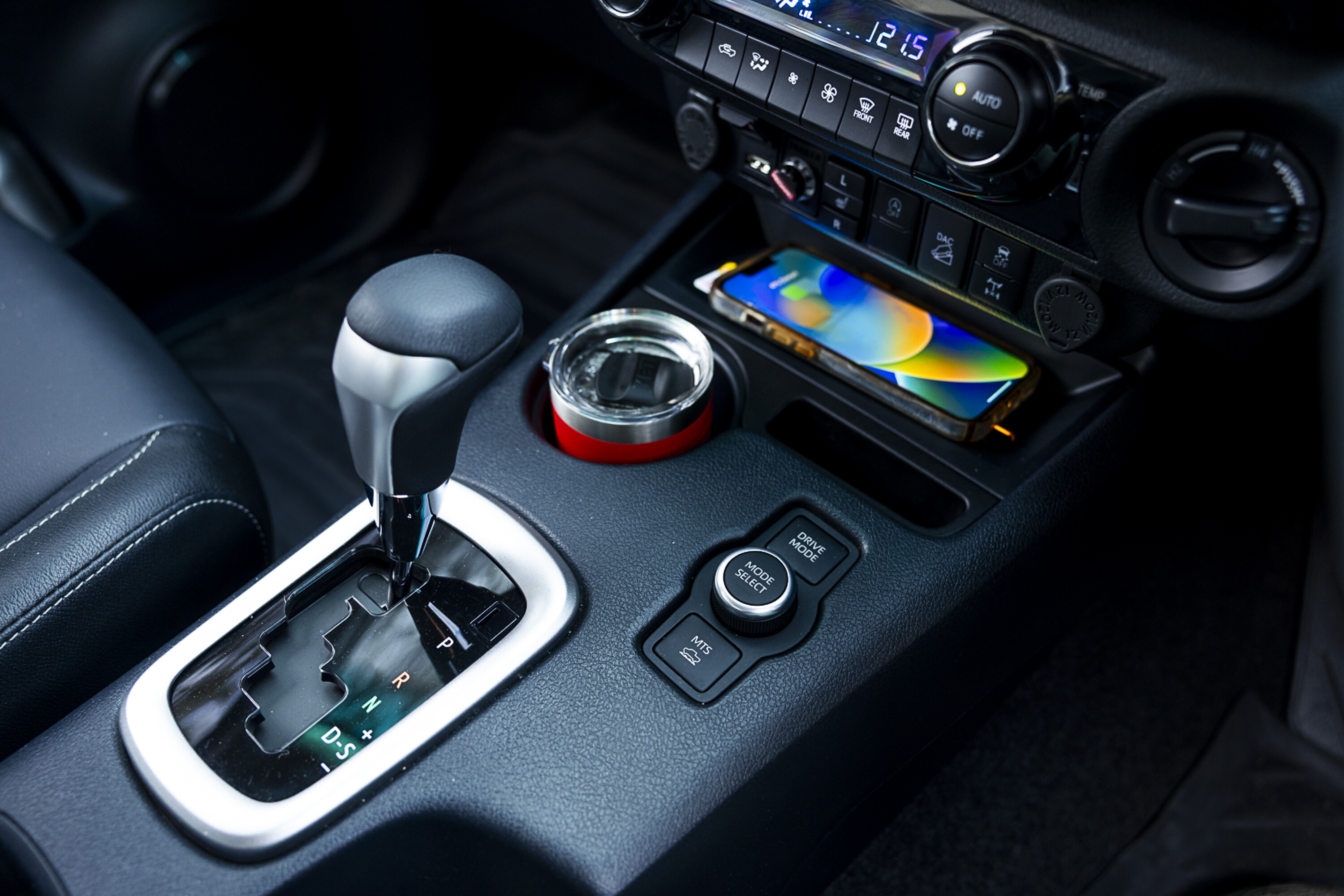
In many ways, it feels its age when compared to newer models but it still feels like the most solid and well built of the midsize 4×4 utes when driven across rough terrain. While that feeling is difficult to quantify, it comes from spending plenty of time in HiLux’s major competitors over the last 20 years.
The HiLux might not have a V6 diesel engine or the latest tech features but it always feels like it will get the job done day after day in the toughest conditions.
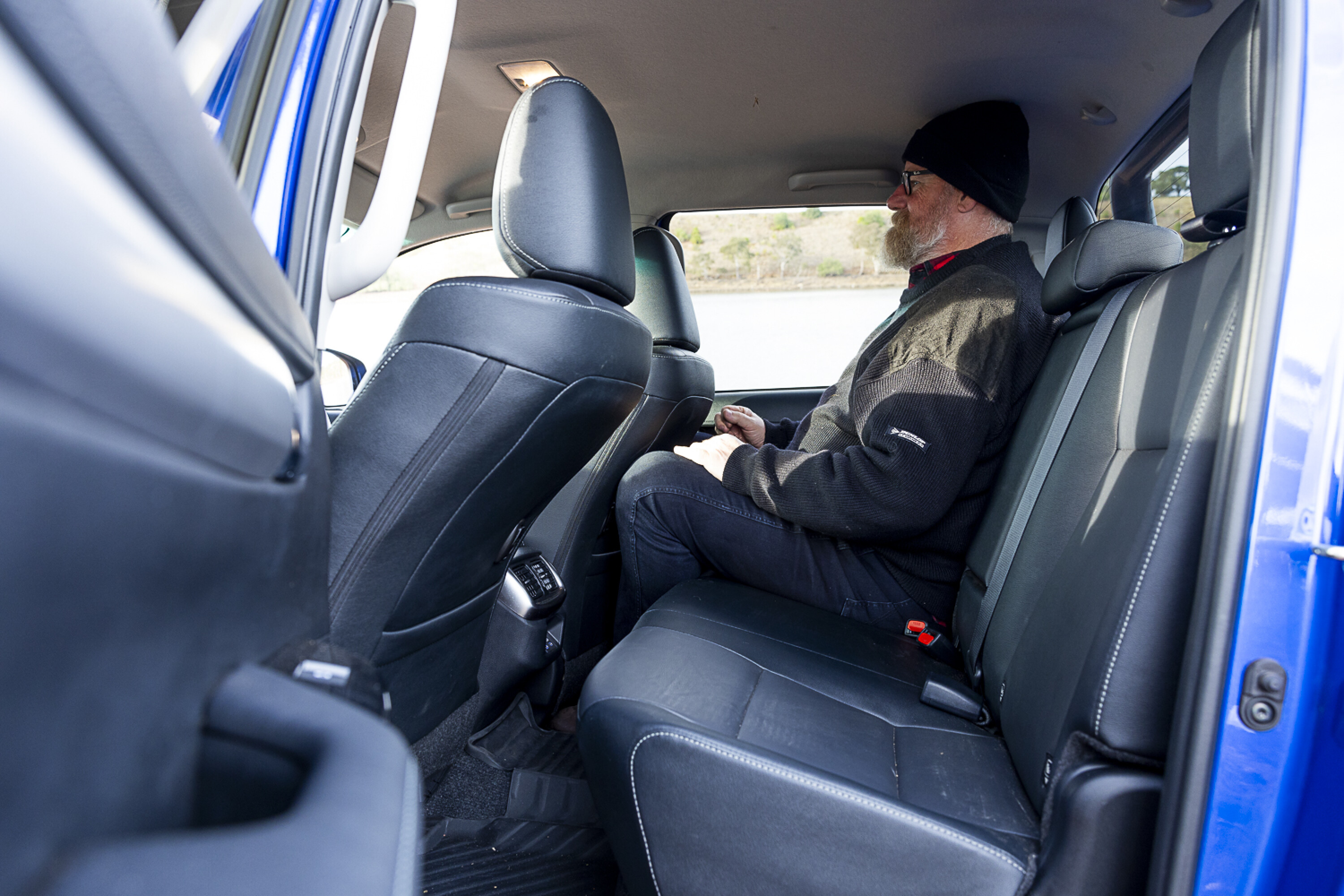
The SR5 gets a well appointed dash with a tablet-style multimedia screen placed high on the dash that includes Apple CarPlay and Android Auto, as well as inbuilt mapping. A wireless phone charger is also there for compatible devices and there’s a pair of USB-C outlets at the back of the console for rear-seat passengers, along with a standard USB outlet in the dash.
Also new in the console is a drive-mode switch allowing the driver to select settings for Sand and Mud (low and high range), Deep snow and dirt (high range), and Rock (low-range), and there’s an Auto setting for most uses.
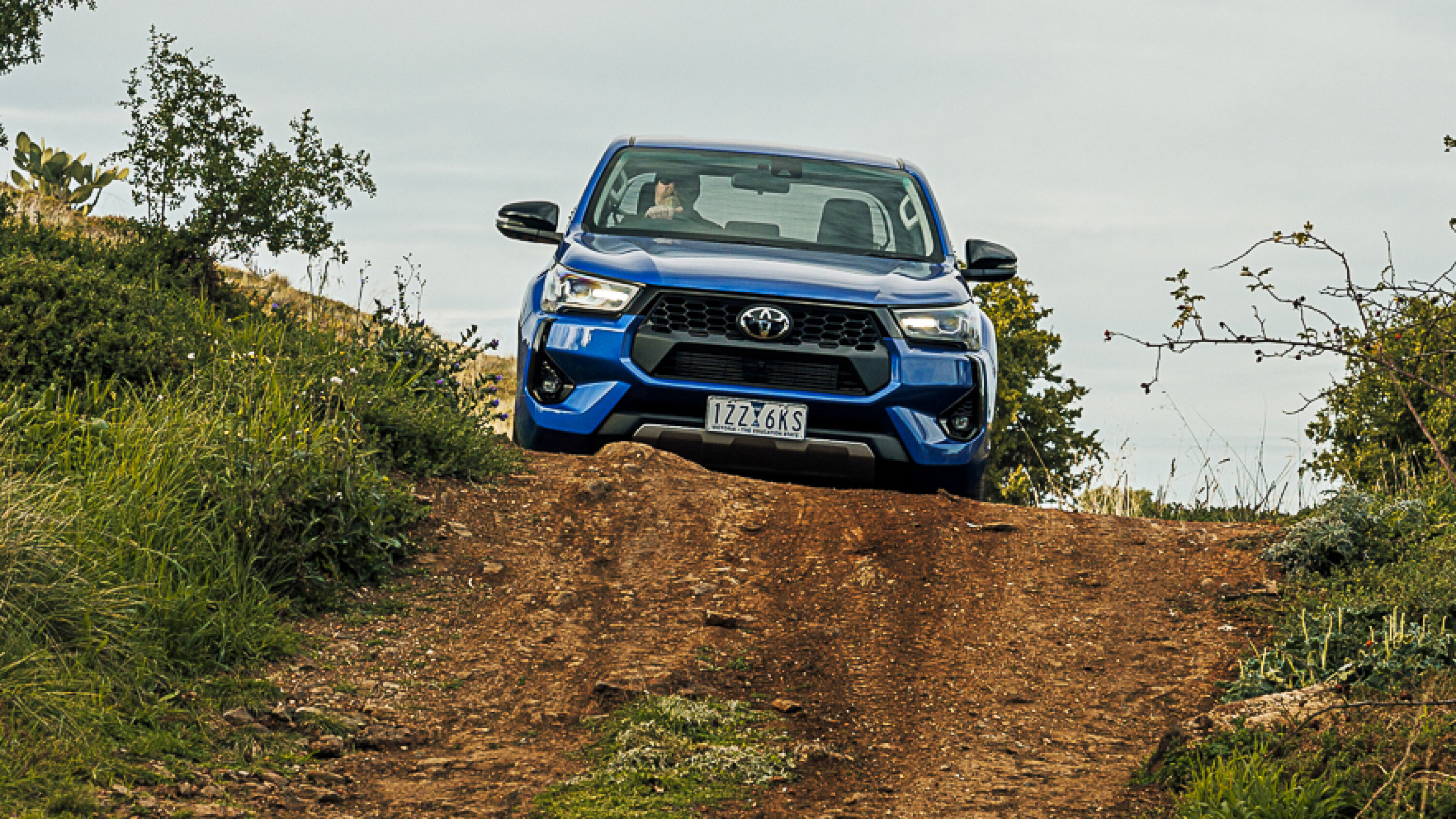
The rear seat is where you feel the pinch with a narrower cabin and less legroom than in some of the newer, bigger utes.
The HiLux comes with Toyota’s Safety Sense, which includes a pre-collision warning with autonomous emergency braking ,lane-departure warning with steering input, ABS, ESC and trailer sway control.
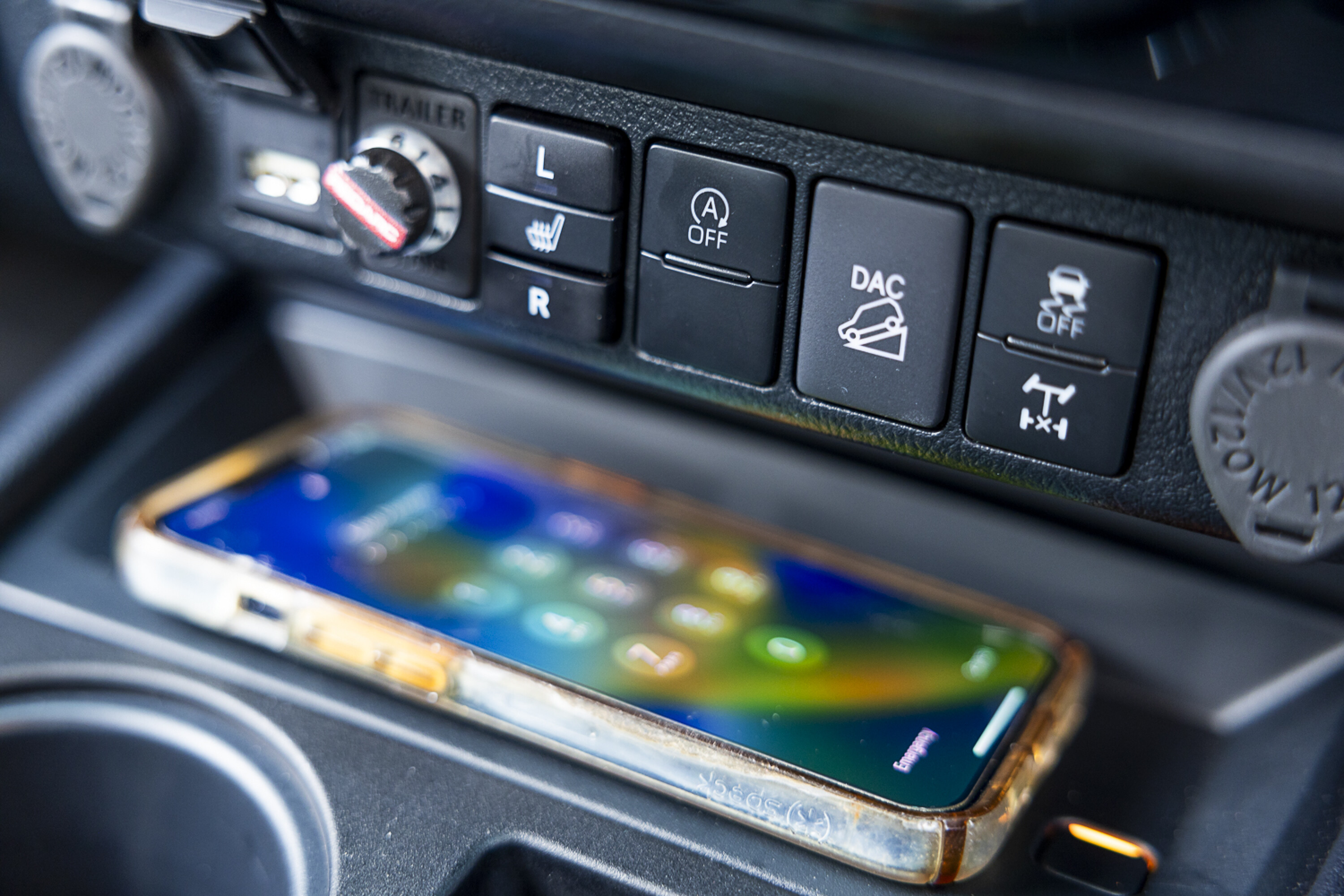
It’s more of an old school light-commercial vehicle (LCV) engine compared to some of the newer ones in the segment, especially the V6.
The six-speed automatic transmission and part-time dual-range four-wheel drive transfer case is pretty basic stuff but it just gets on with the job, giving nothing to complain about. While the HiLux has a rear differential lock for the toughest terrain, its class-leading electronic traction control (ETC) will get you through most conditions without having to worry about engaging it.
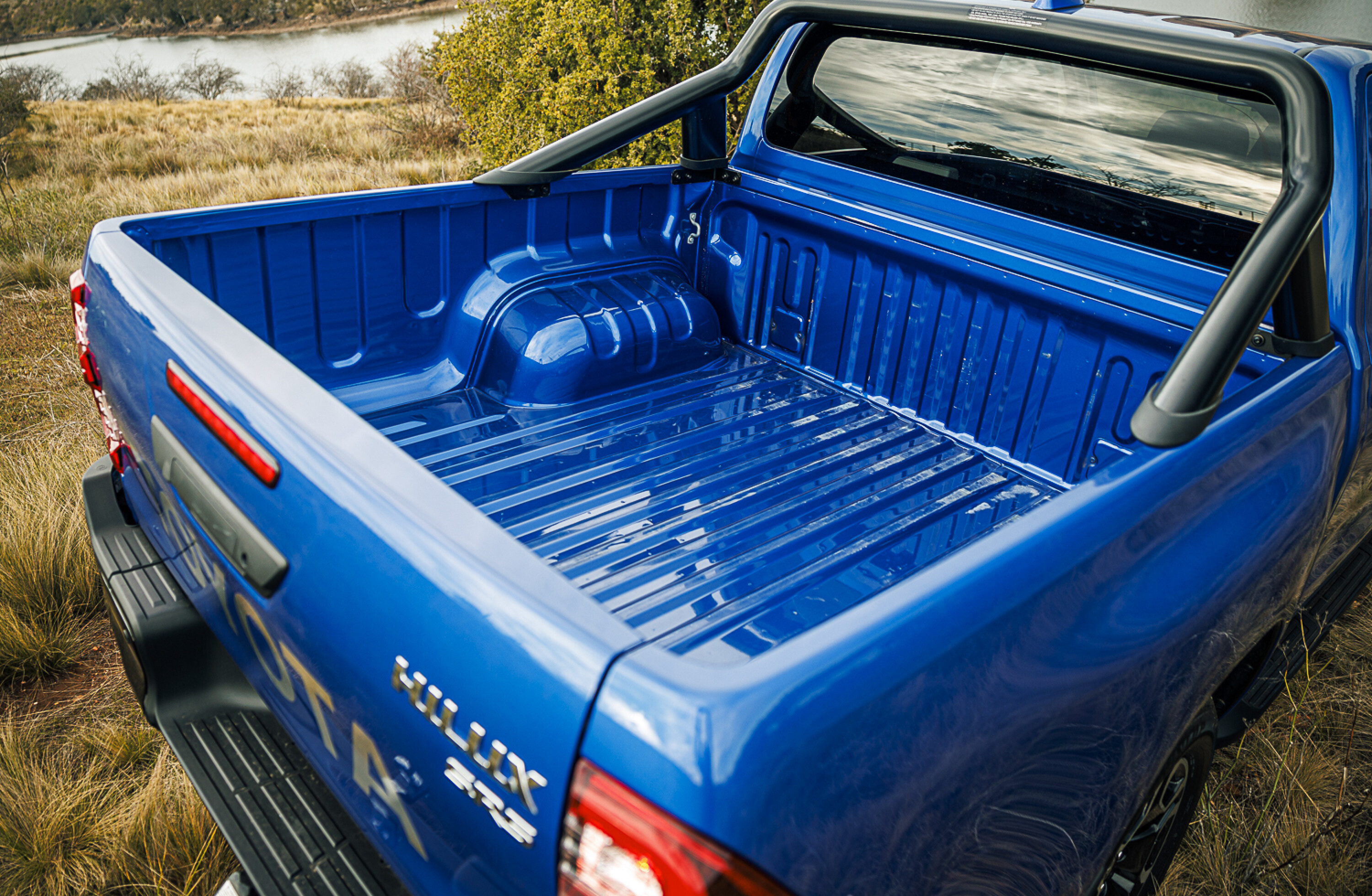
It was timely that we had the HiLux on test as it coincided with us moving the 4X4 Australia office, and we put it to work. Speaking of work, the HiLux SR5 has a 3500kg towing rating, 900kg payload and a 6550kg GCM.
The cargo tub is bare bones with just four tie down points and no lighting or power outlets, not even a protective tub liner, which is disappointing at this price and spec. The SR5 does get a spring assisted tailgate for those that might need it.
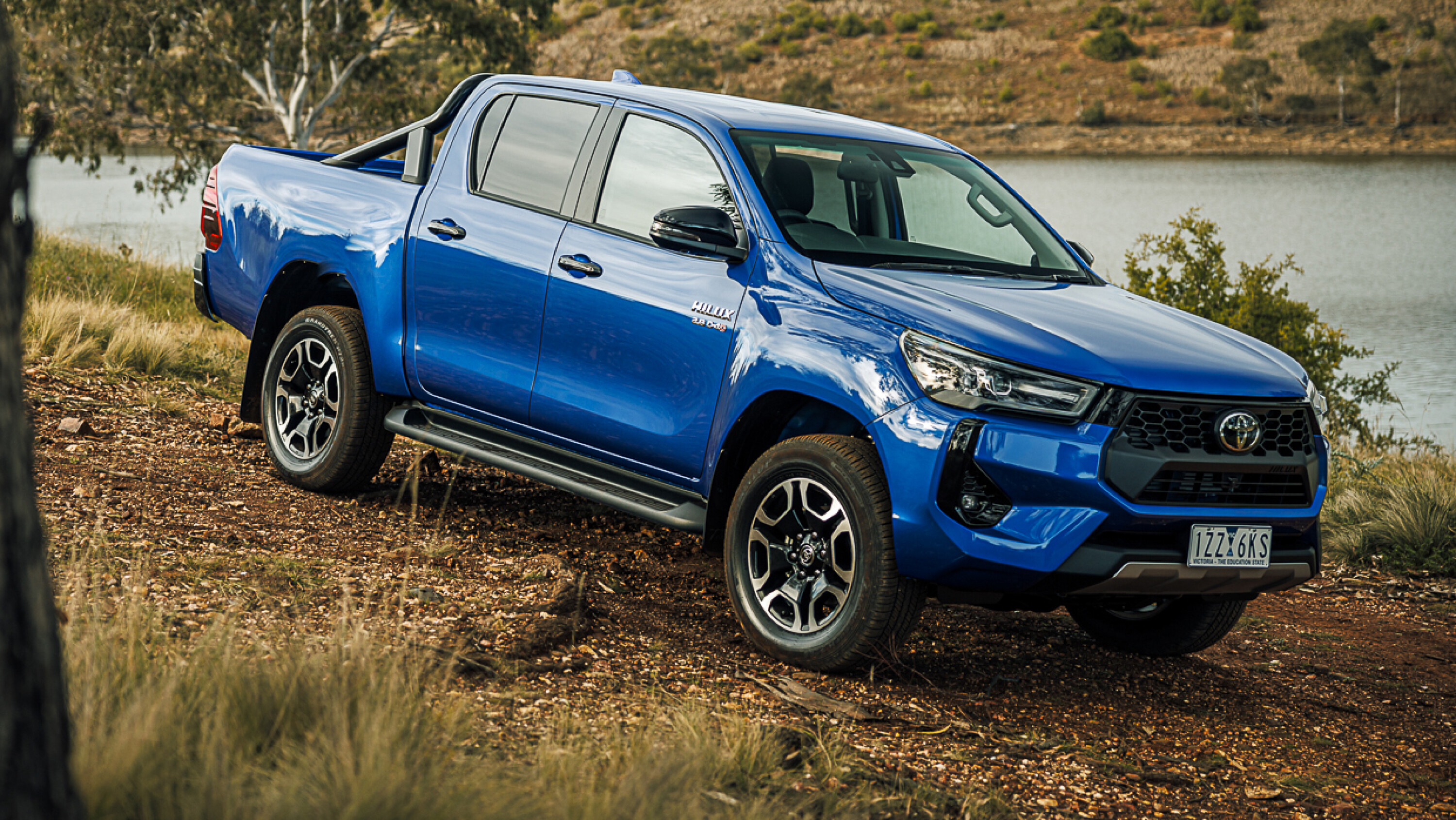
While it might not match for the newer utes in terms of features and cabin space, a few days behind the wheel of the HiLux reminded us why it was Australia’s best-selling ute for so long.
| 2024 Toyota HiLux SR5 specifications | |
|---|---|
| Price | $63,260 (+ORC) |
| Engine | Inline 4-cyl diesel, single turbocharger |
| Capacity | 2755cc |
| Max power | 150kW @3000-3400rpm |
| Max torque | 500Nm @ 1600-2800rpm |
| Transmission | 6-speed auto |
| 4×4 system | Part time, dual range 4×4 |
| Crawl ratio | 36.11:1 |
| Construction | 4-door ute body on separate chassis |
| Front suspension | IFS with wishbones and coils |
| Rear suspension | Live axle on leaf springs |
| Tyres | 265/60R18 on alloy wheels |
| Kerb weight | 2150kg |
| GVM | 3050kg |
| GCM | 6550kg |
| Towing capacity | 3500kg |
| Payload | 900kg |
| Seats | 5 |
| Fuel tank | 80L |
| ADR fuel consumption | 7.2L/100km combined |
| On test fuel consumption | 9.4L/100km |
| Approach angle | 30u00b0 |
| Ramp over angle | N/a |
| Departure angle | 27u00b0 |
| Ground clearance | 265mm |
| Wading depth | 700mm |
Before charging in I assess the depth, the water flow and the riverbed. A crossing with a firm gravel bottom is an entirely different challenge than one with bottomless mud. Any large boulders or deep holes are also nice to know about. The most straightforward way to be certain about all of this is simply to walk across the river before driving in; and if this was any ordinary river, that’s exactly what I would do.
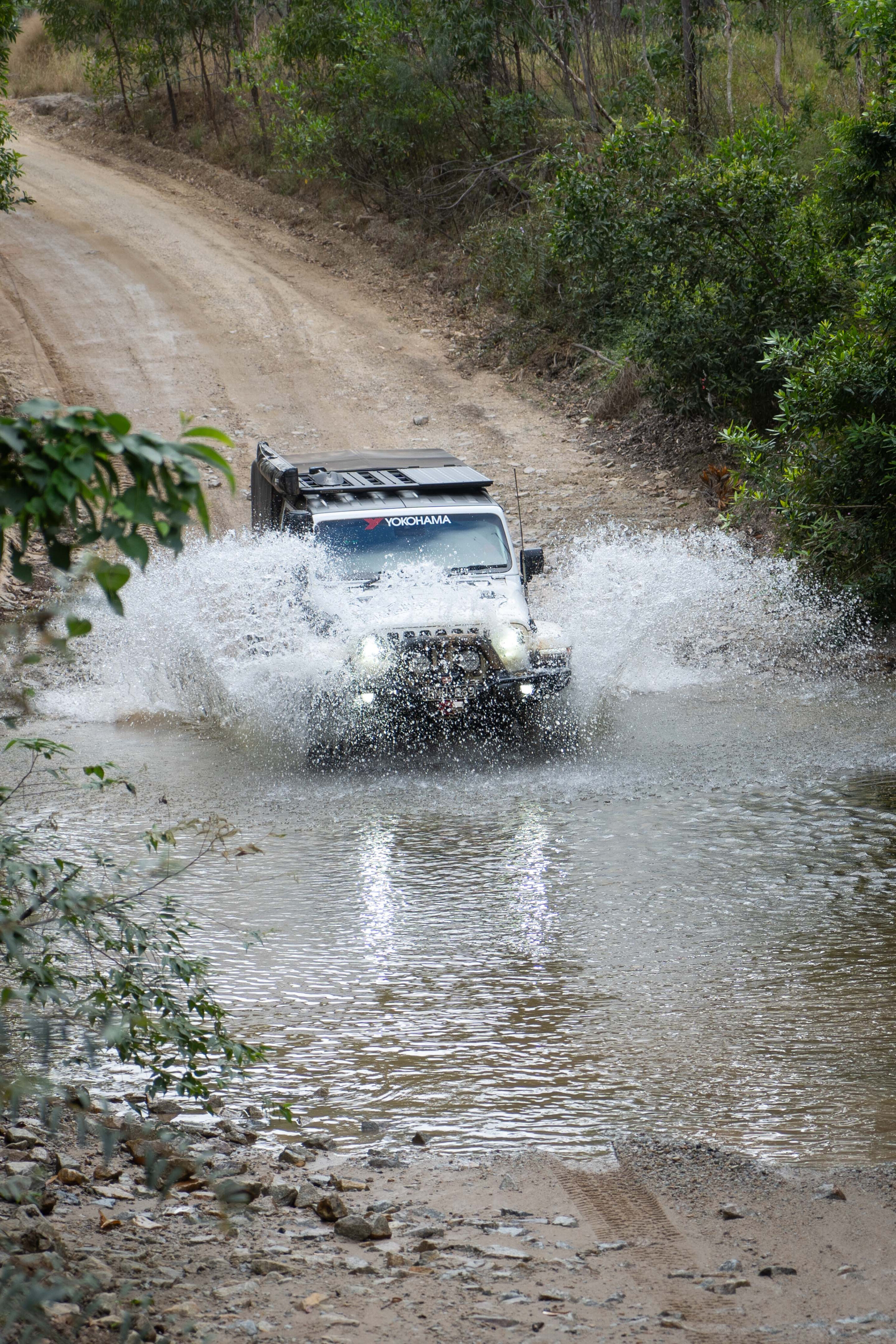
We’re in Far North Queensland, standing on the banks of the mighty Daintree River, infamous for its salty infestation. While I can’t actually see any crocodiles from where I’m standing, I feel certain they must be lurking just under the waterline, waiting for their next meal to wander into the water. Not only do we have to successfully cross this river, it would be nice not to get eaten by crocs while doing it.
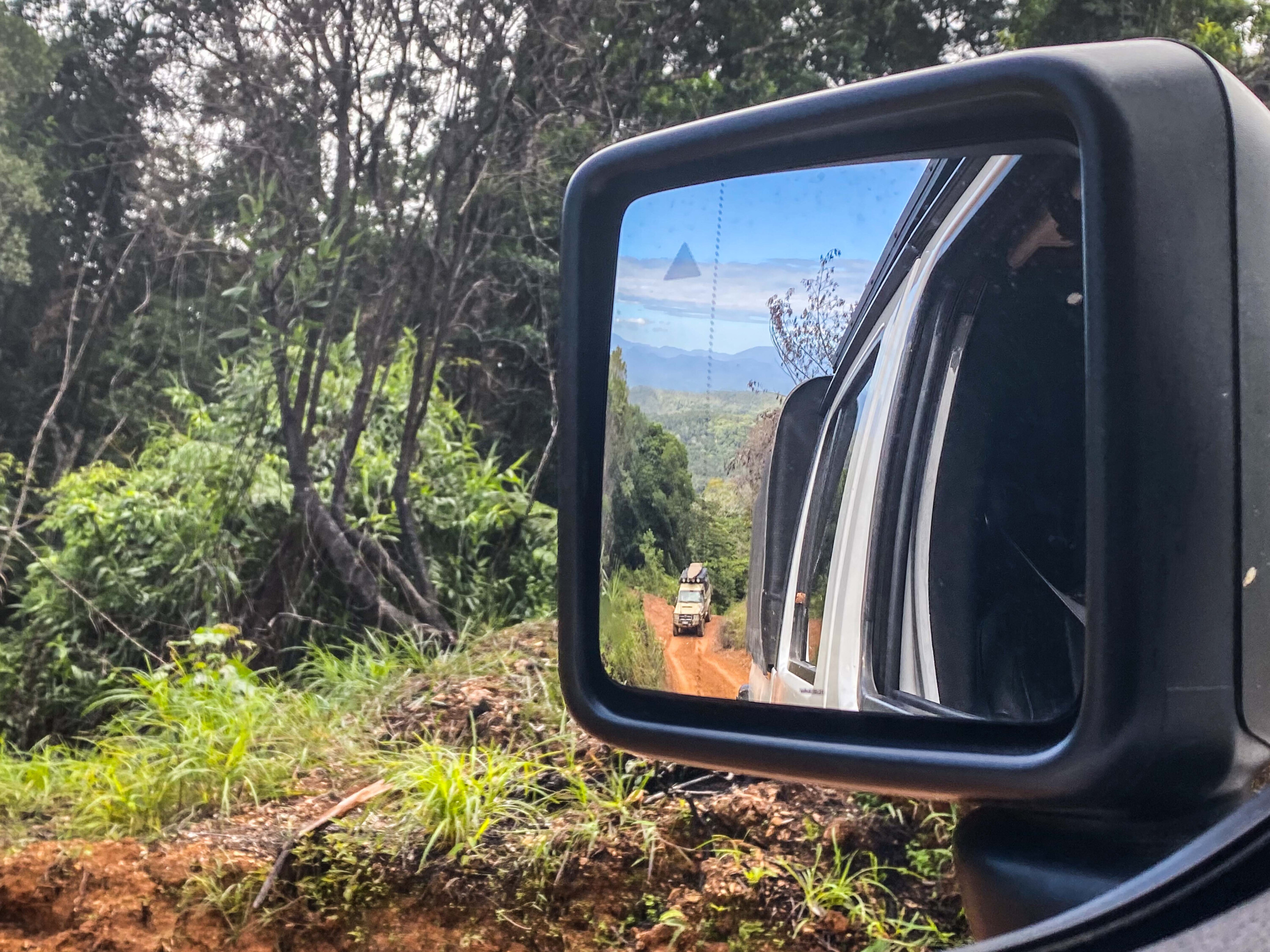
As well as providing spectacular scenery, the CREB is notorious as one of Australia’s most challenging four-wheel drive adventures. With rain the track becomes extremely slippery and dangerous, and in recent months multiple vehicles have rolled on the slick clay and were left in the thick jungle for days. During that incident even a Unimog sent to help was no match for the steep climbs and became another victim.
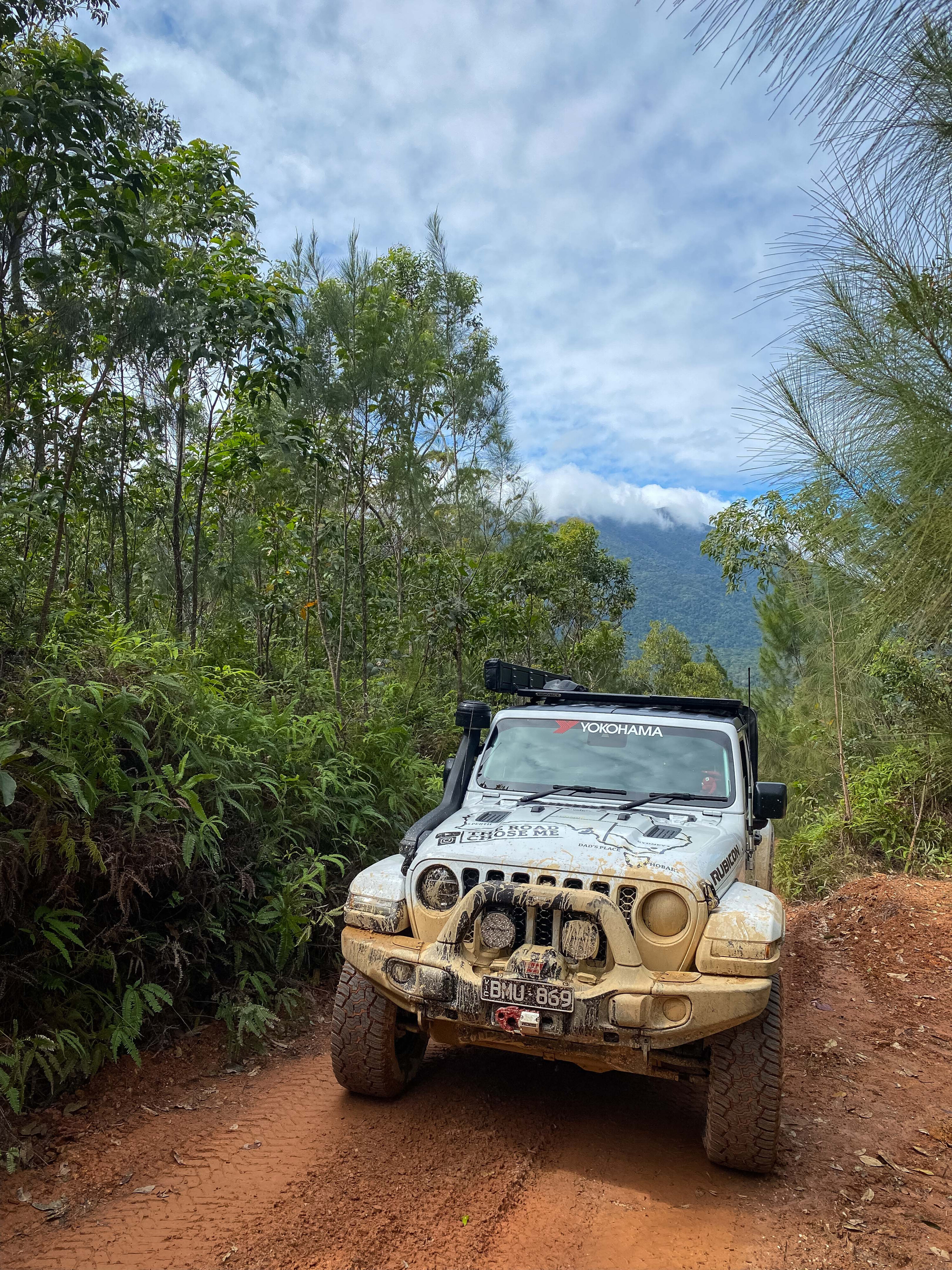
This track is not to be taken lightly, and so we team up with a group of friends we had previously tackled the Oodnadatta Track with. Since then we all somehow managed to explore in different directions around the country, and it’s great to fill in all the blanks and tales of adventure.
As is often the case when 4×4 touring in Australia, all four of the vehicles we team up with are V8 LandCruisers. With integrated pop-top roofs, elaborate interior build-outs, bull bars, winches, snorkels and a forest of radio antennas, the Cruisers are so nearly identical even the dogs have trouble figuring out which vehicle they should be getting into.
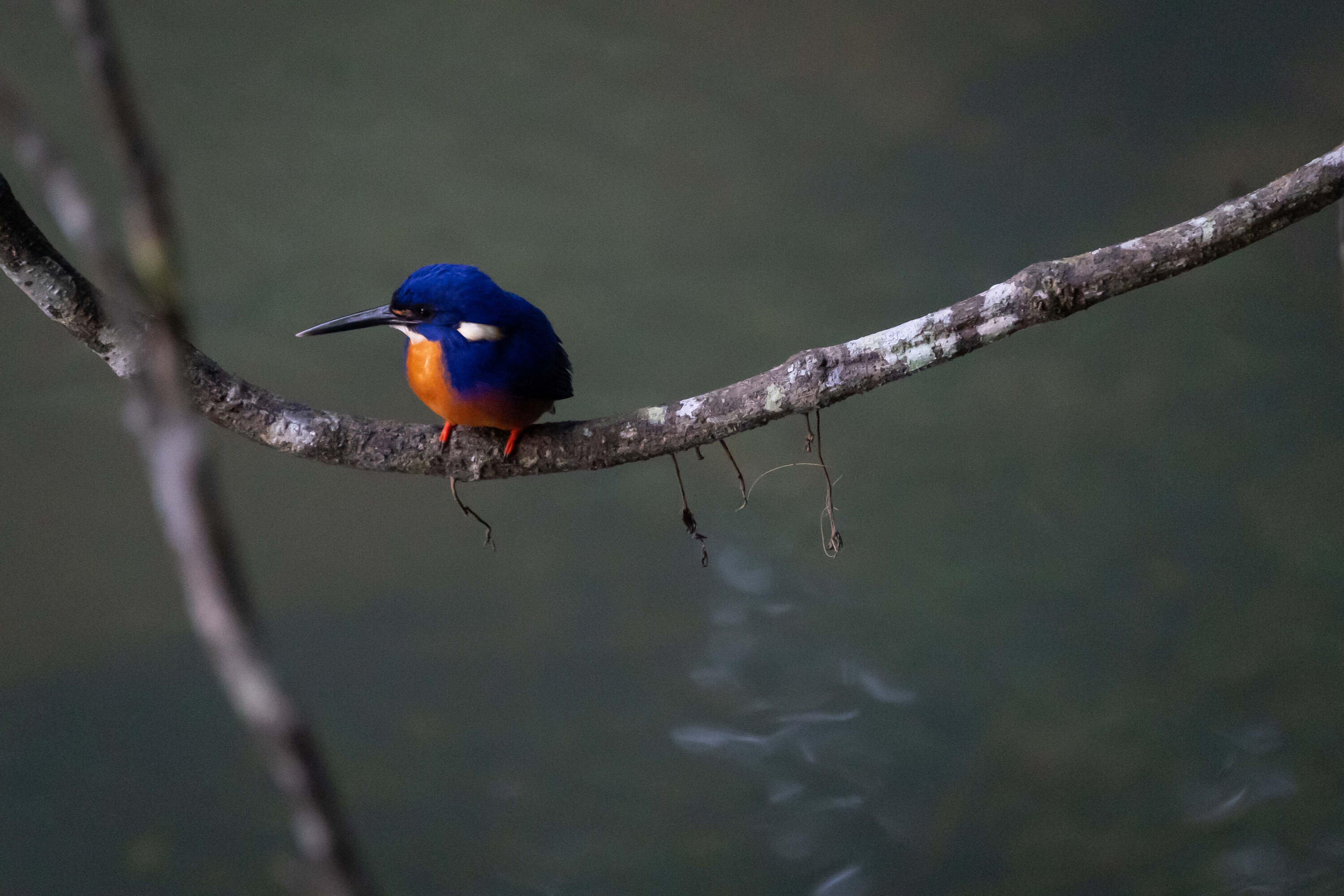
In less than 30 seconds we spot the resident alpha male sunning himself on the bank, and all get a huge laugh when Canadian Katie doesn’t see the massive reptile with mouth wide open until we can almost reach out of the boat and touch it.
While Katie has had plenty of practice spotting grizzly bears and mountain lions, we all agree she wouldn’t last long amongst Australian critters. Over the next hour we meander downstream and spot a handful of more large reptiles in and out of the water, the most eerie being a large female swimming silently under the boat without making so much as a ripple.

We’ve been watching the weather reports and talking to locals about the river height, and literally every report has given a different story. We’re told the water depth will most likely fall somewhere between the top of the tyres and the top of the windshield, which really doesn’t tell us much.
We walk to scout the crossing as much as possible, but we’re not sure how close to the water we can safely stand. While I still carry an Australian passport, I’m no Crocodile Dundee, and I have no intention of going hand to hand with a big salty.
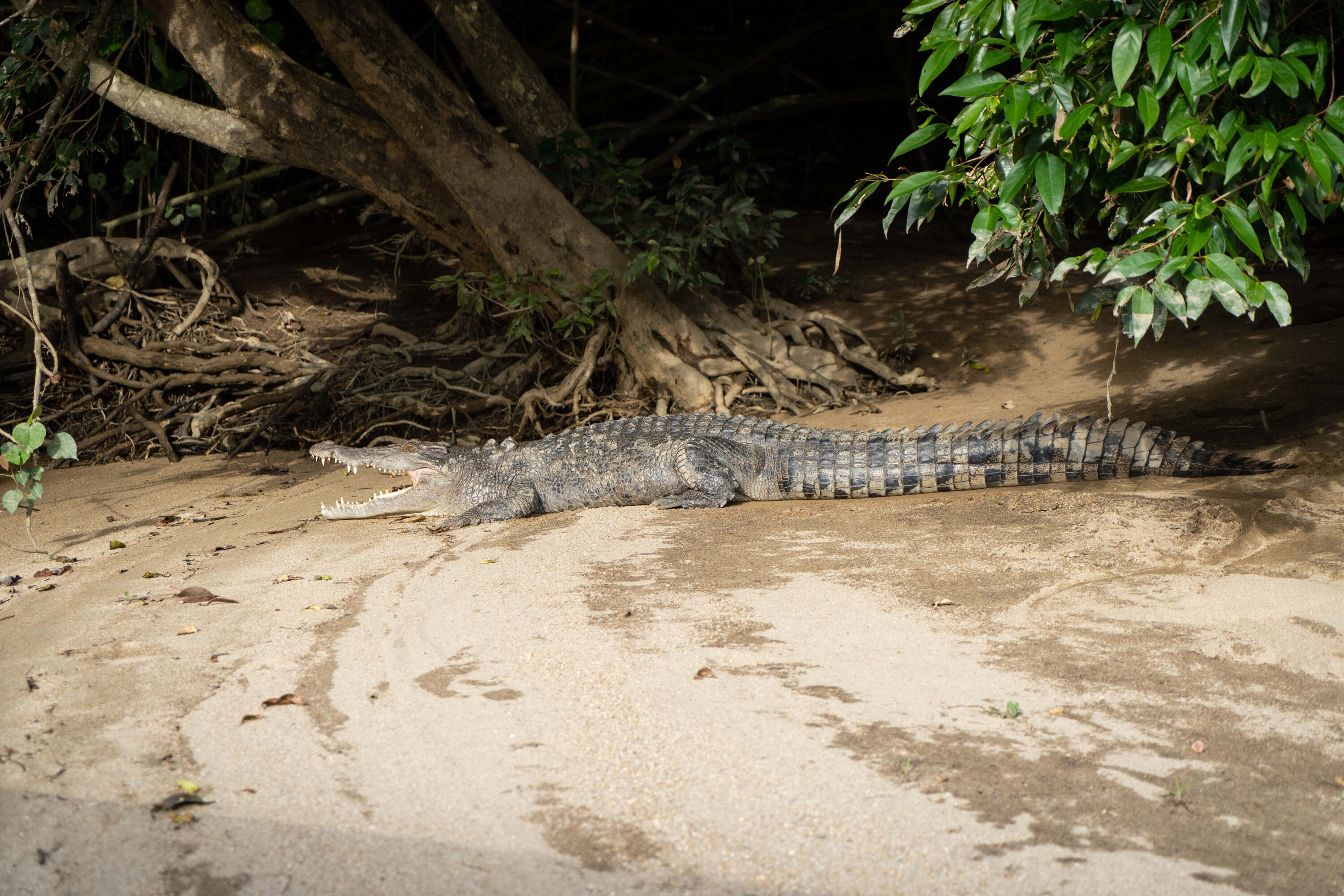
A couple of the LandCruisers are on 35s, and I’m perfectly happy when they volunteer to go first, showing the rest of us the best line through the river. One at a time we swing wide, actually driving downstream for a hundred yards before turning back across the current and climbing up the far bank, an easy gravel exit. While coming back across the current the water barely laps at the front of the bonnet, and the firm gravel bottom gives plenty of traction to keep me moving across.
Near the beginning of the track we navigate a series of small mud holes, washouts and soggy low-lying areas before we begin to climb in earnest. Simultaneously, the jungle closes in on all sides until we’re completely surrounded by the dense green foliage.
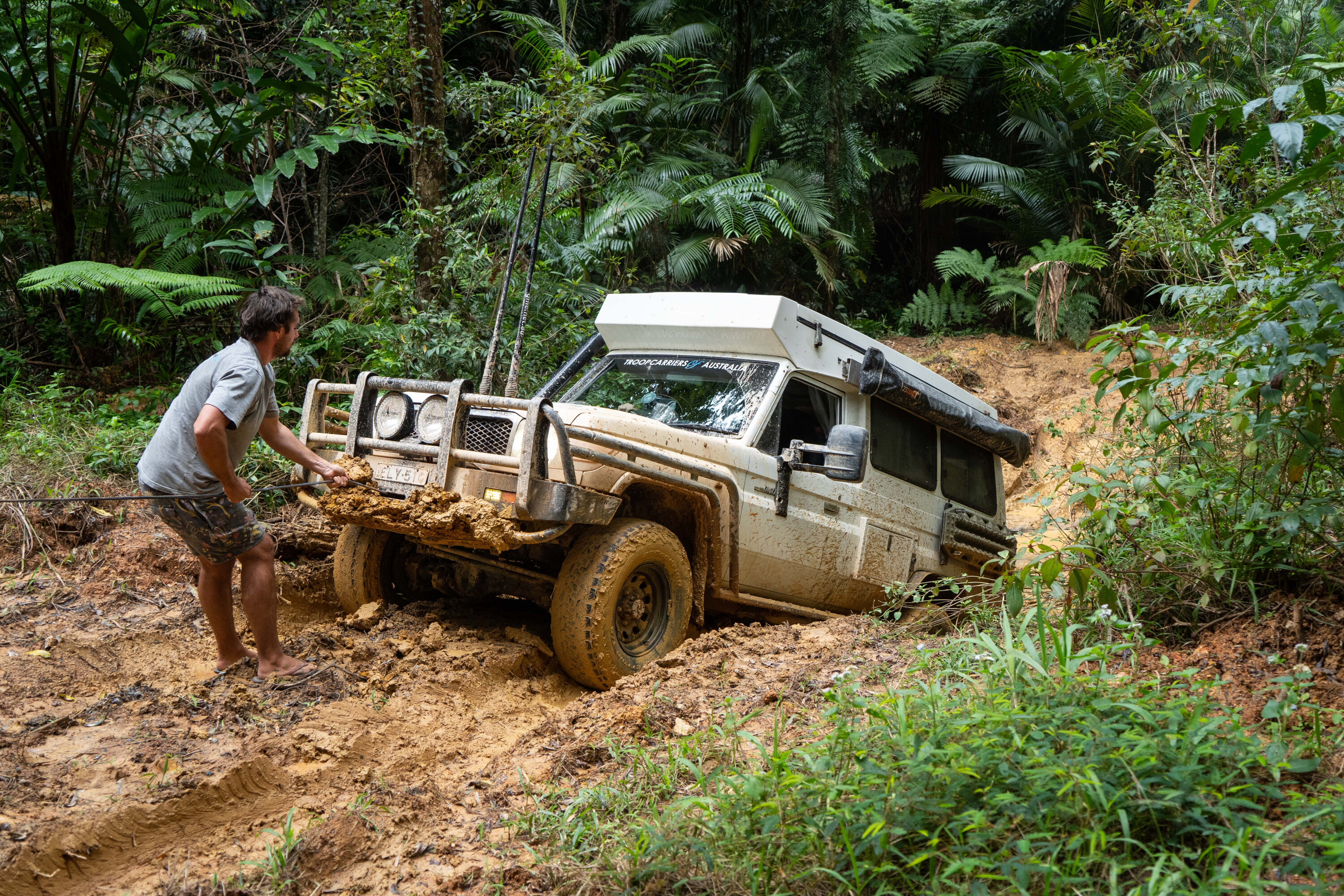
As far as we can tell it hasn’t rained in the last day or two, and while everything is a little damp and we encounter plenty of sticky mud pits, none of the climbs are seriously slick.
The CREB slices through Daintree National Park, which contains the oldest rainforest anywhere on earth. Because the rainforest here has existed continuously for more than 110 million years, many species of trees and plants are the ancient ancestors of more common species today. This flora dates back roughly 30-50 million years and gives scientists a direct window into the past, and what the planet looked like long ago.
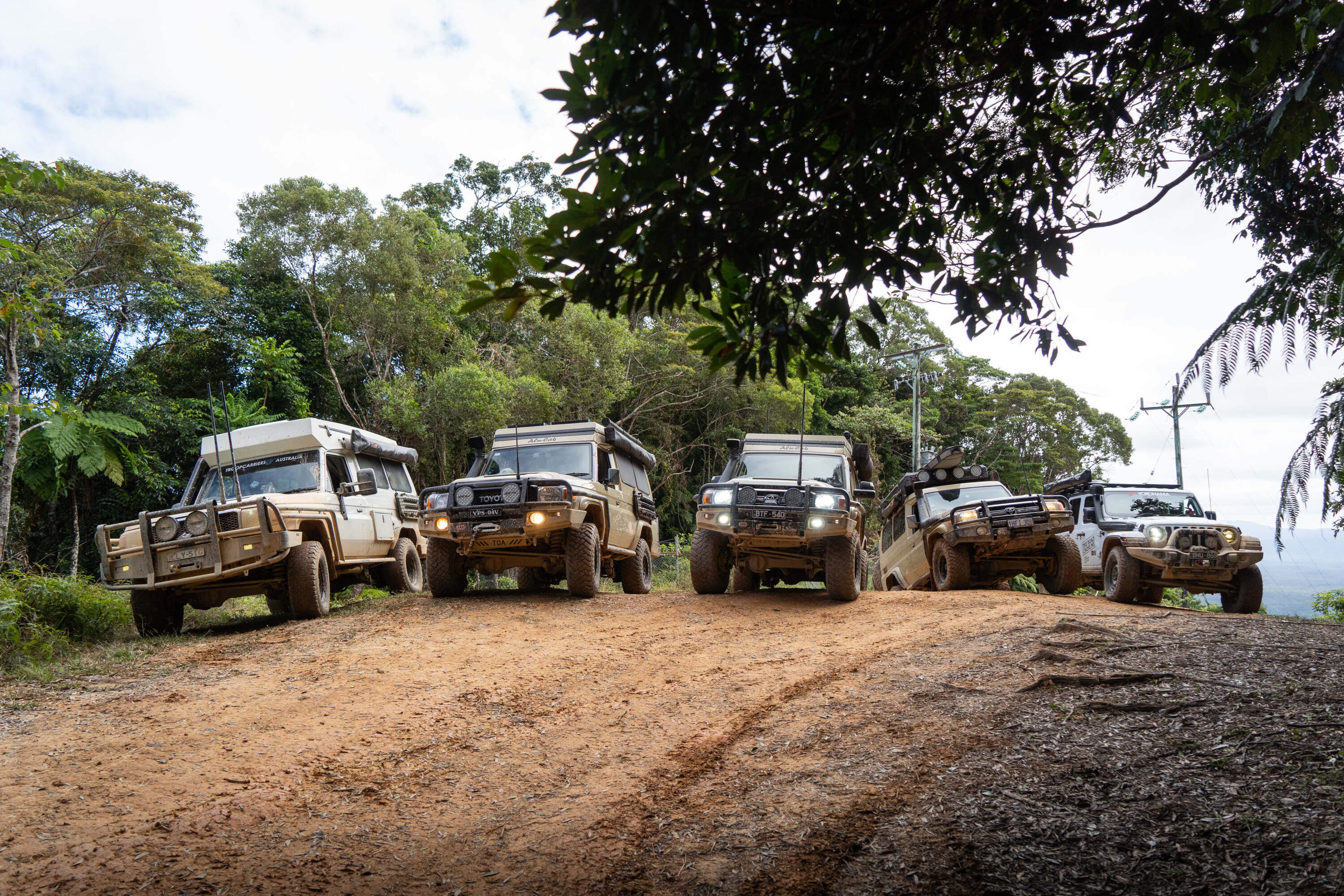
The Daintree is also home to thousands of animal species, including the majestic cassowary. Equally as flightless as emus but much more beautiful, cassowaries are typically wary of humans but can get very aggressive when provoked or while defending their young. Their three-towed feet have large claws that resemble a velociraptor, making me think we might actually see a dinosaur wander by. Cassowaries have on occasion killed people, leading to the label of ‘world’s most dangerous bird’.
The entire region has enormous cultural and spiritual significance to the local Aboriginal people, and in a historic deal made by the government of Queensland, the eastern Kuku Yalanji people took formal ownership of Daintree National Park in 2021.
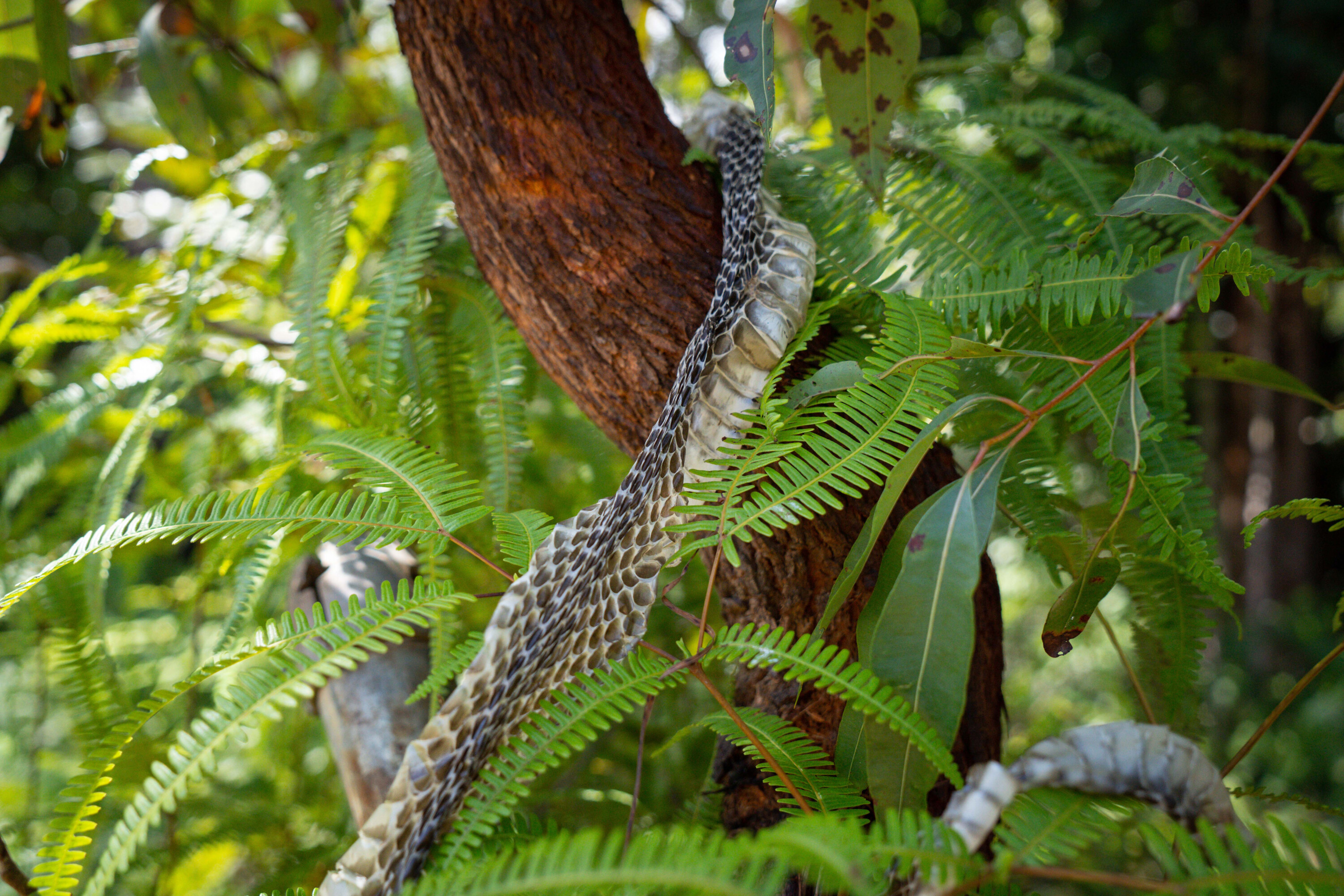
We cross a few small rivers and splash up some mud here and there, but don’t encounter anything to really slow our progress. As we arrive at a much bigger creek crossing, however, I sense things are about to get exciting.
There isn’t much water in the creek, though it’s obvious the bottom and far bank are pure thick mud. The bank on the far side is very steep, leading us to dig out winch controllers, shackles and tree protectors before even attempting it.
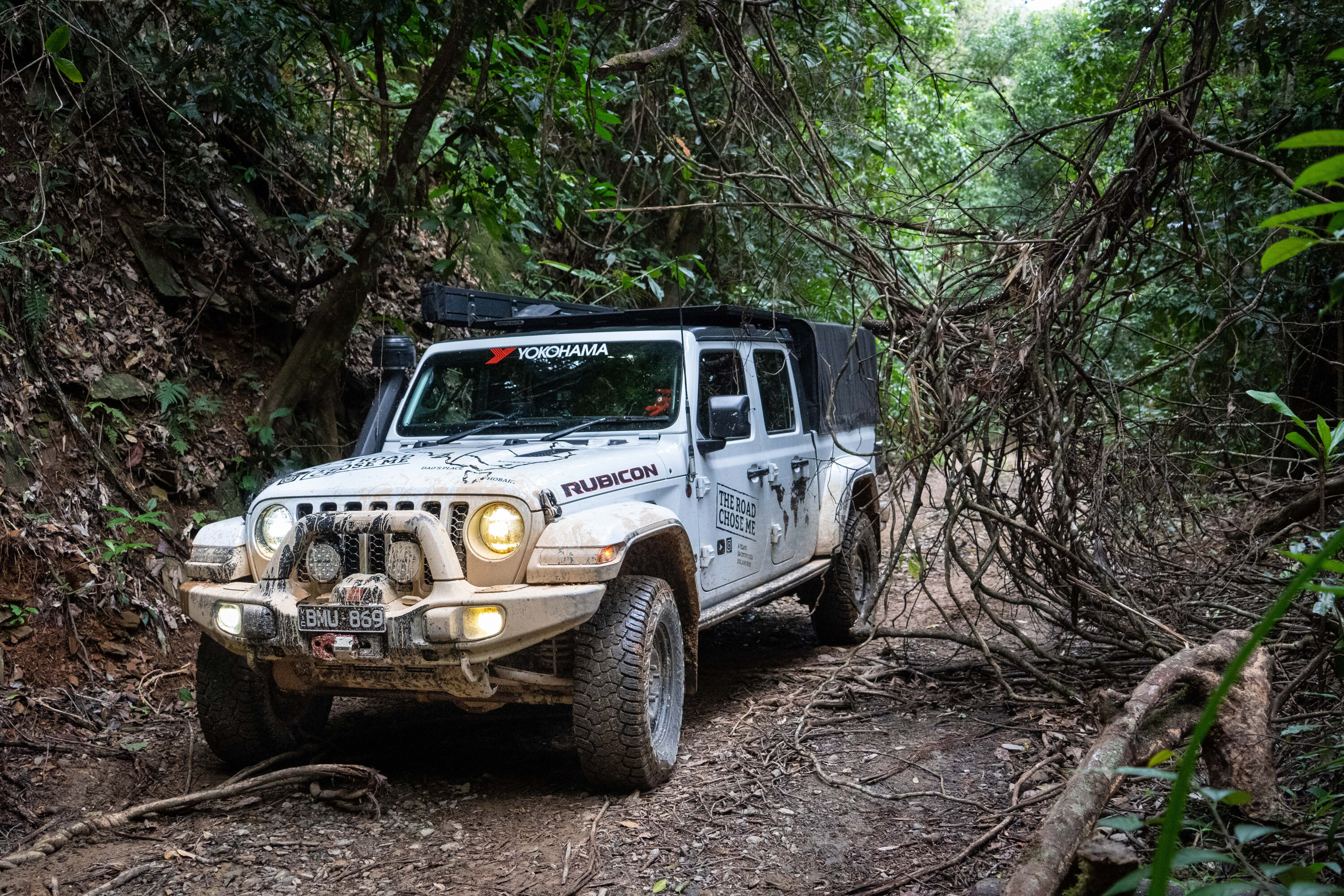
Even with the massive diesel engine bouncing off the rev limiter he just barely manages to claw up the bank and out of the pit, with mud spitting from the tyre tread blocks. Now the gauntlet has been thrown down, we all line up for an attempt at the sticky mud hole, and I’m well aware I need to carry the Jeep flag while deep in LandCruiser territory.
With a lot more wheel spin and engine revving, it becomes clear that ground clearance and traction are the limiting factors, and not a single vehicle on 33-inch tyres manages to complete the climb, and all eventually give up and resort to winching.
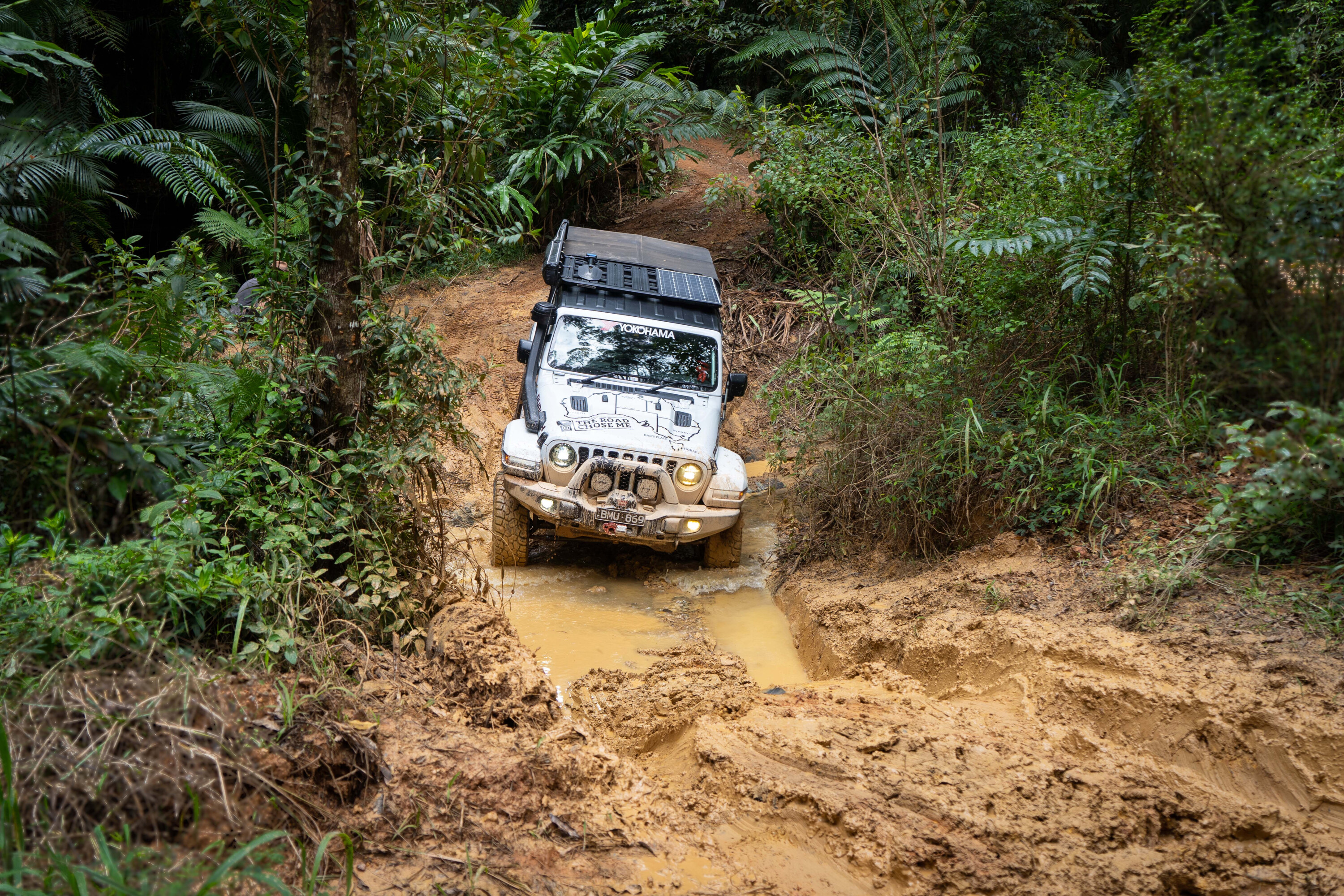
In low range 4×4 with both diff locks engaged and the front sway bar disconnected, the Jeep easily moves through the river and mud at the bottom, and the front tyres have no problem with grip as the front half of the Gladiator climbs up the bank.
With the rear tyres not yet on the climb, and the front tyres already levelling out, the extra long wheelbase of the Gladiator comes into play as the belly grounds out on the muddy breakover.
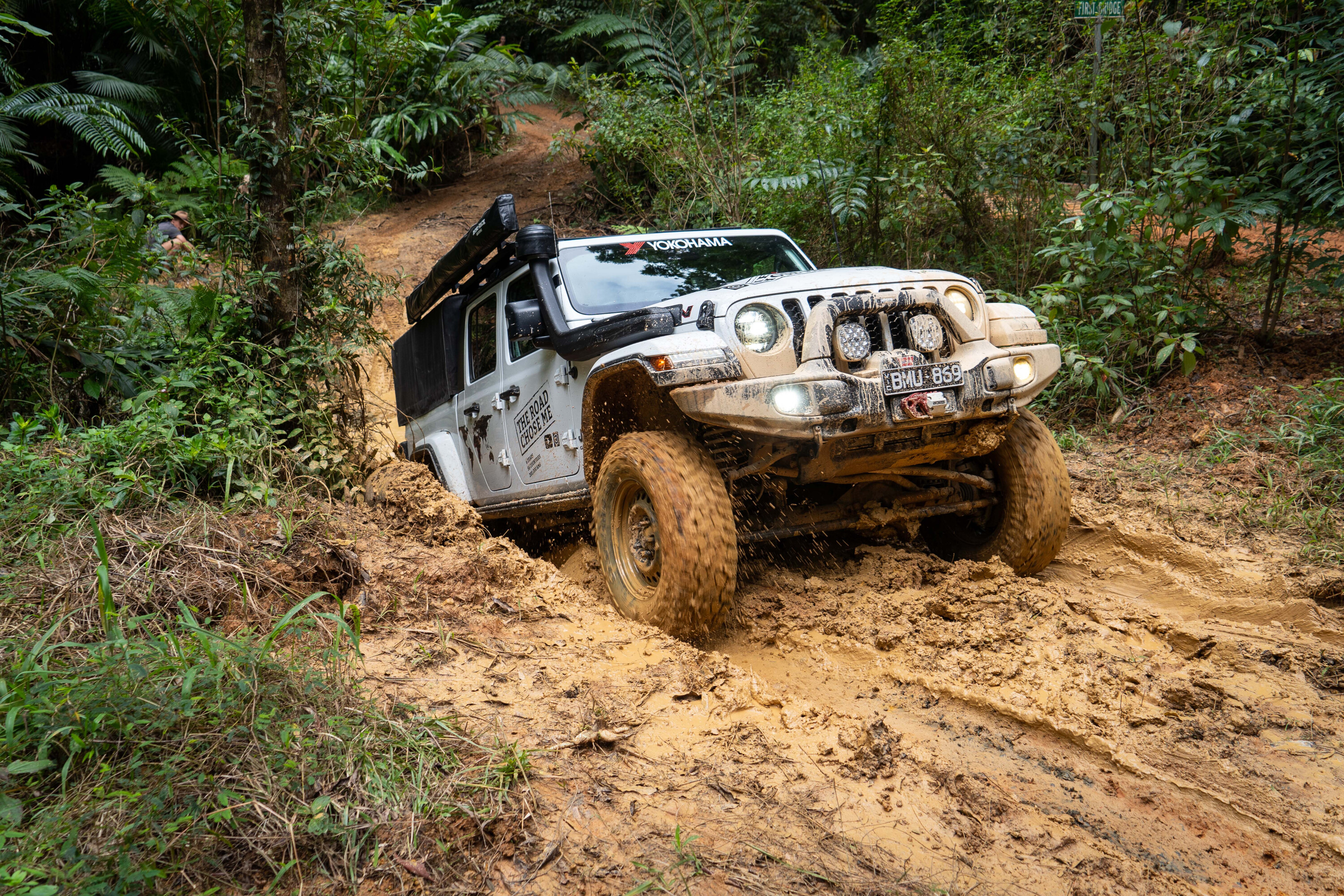
There is no doubt more ground clearance would have helped, and as I hand Katie the controller for her first time using the winch, I wonder if 35s would have been enough, or if the much more common North American choice of 37s on the Gladiator would have been needed. I always enjoy learning the limits of a vehicle, and this was the perfect opportunity to see exactly what would happen on a short and sharp climb.
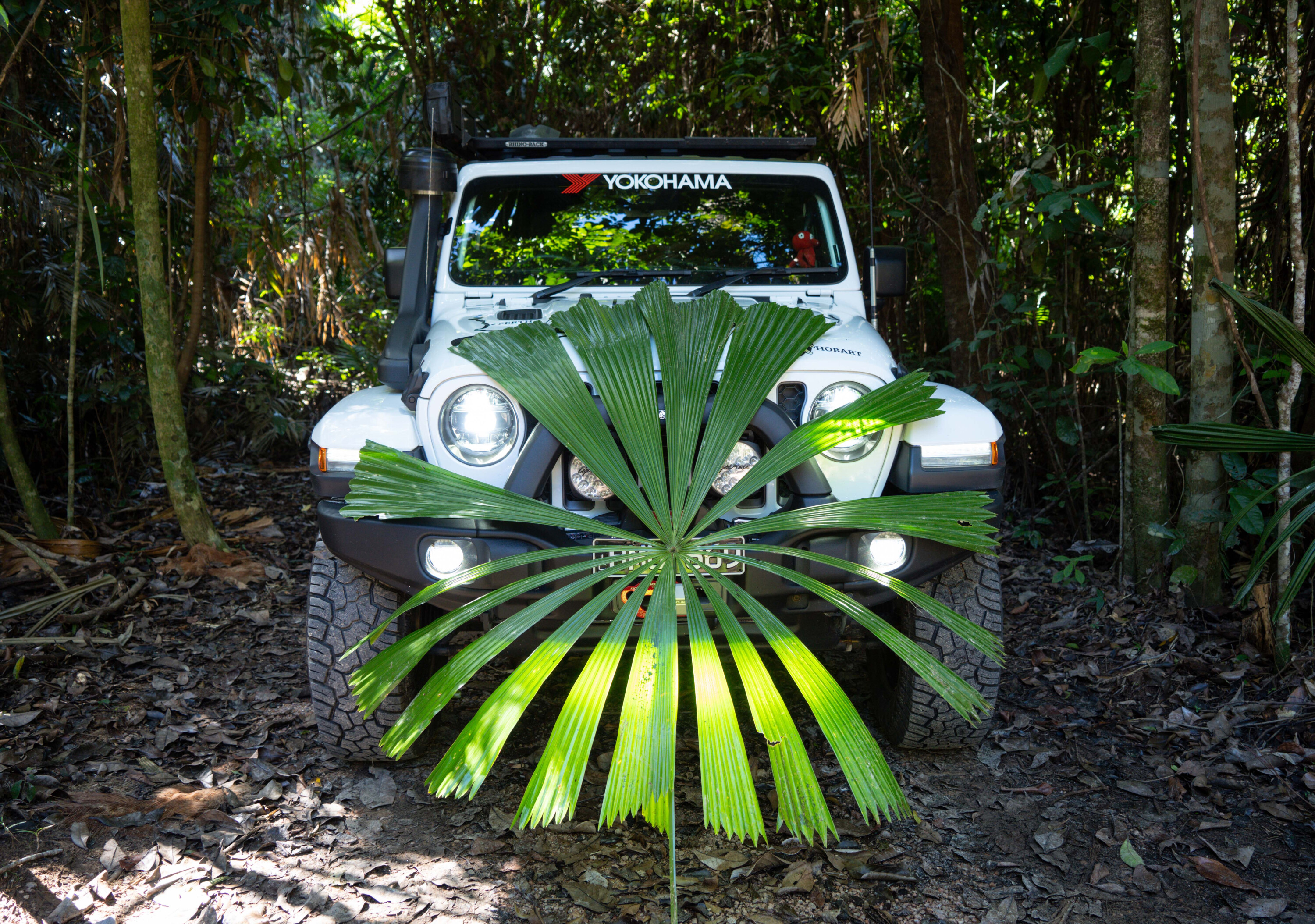
With all the whitewater and elevation it’s extremely unlikely there are any salties this far from the ocean, and while Katie stands lookout Josh and I brave a very quick dip to beat the relentless heat and humidity. The CREB Track has been a stunning introduction to 4×4 exploration in Far North Queensland, and teaming up with a convoy of great people made for a lot of laughs and good times.
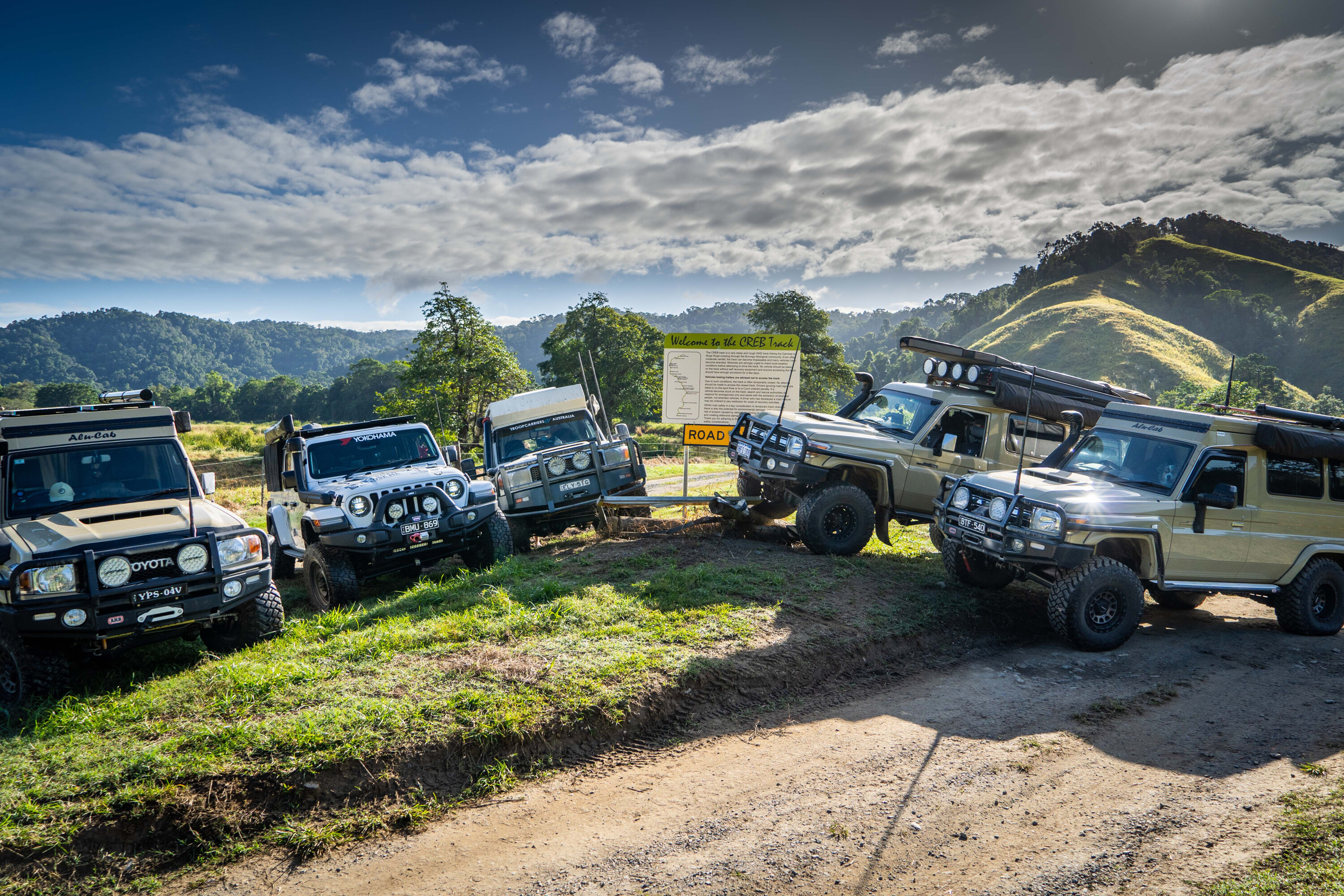
Late in the afternoon we roll into The Lion’s Den Hotel, one of Northern Australia’s famous outback pubs. Out the back is an enormous grassy camping area packed to the brim with 4x4s, camper vans, roof top tents and swags, and it’s clear everybody has decided an ice cold beer is in order. After a day like this, it’s hard to disagree.
Website: tropicalnorthqueensland.org.au/listing/itinerary/creb-track/ [↗️]
Map: Hema Cape York Atlas & Guide (hemamaps.com [↗️])
Pub: Lions Den Hotel (lionsdenhotel.net.au/ [↗️])
For us this always means carrying a car fridge of some sort, so a suitable mounting system was called for, along with a setup that would maximise the remaining available space.
Outfitting a wagon for such use isn’t as easy as fitting a slide within a service body or ute tub. You are limited not only by the smaller space but also the rear door opening that provides access to your fridge and gear. The shape and height of the Everest’s door stops you from fitting a fridge slide or a drop slide on top of a set of drawers, so we chose instead to fit an MSA straight slide on the nearside of the cargo area, and an MSA roller drawer on the other side.
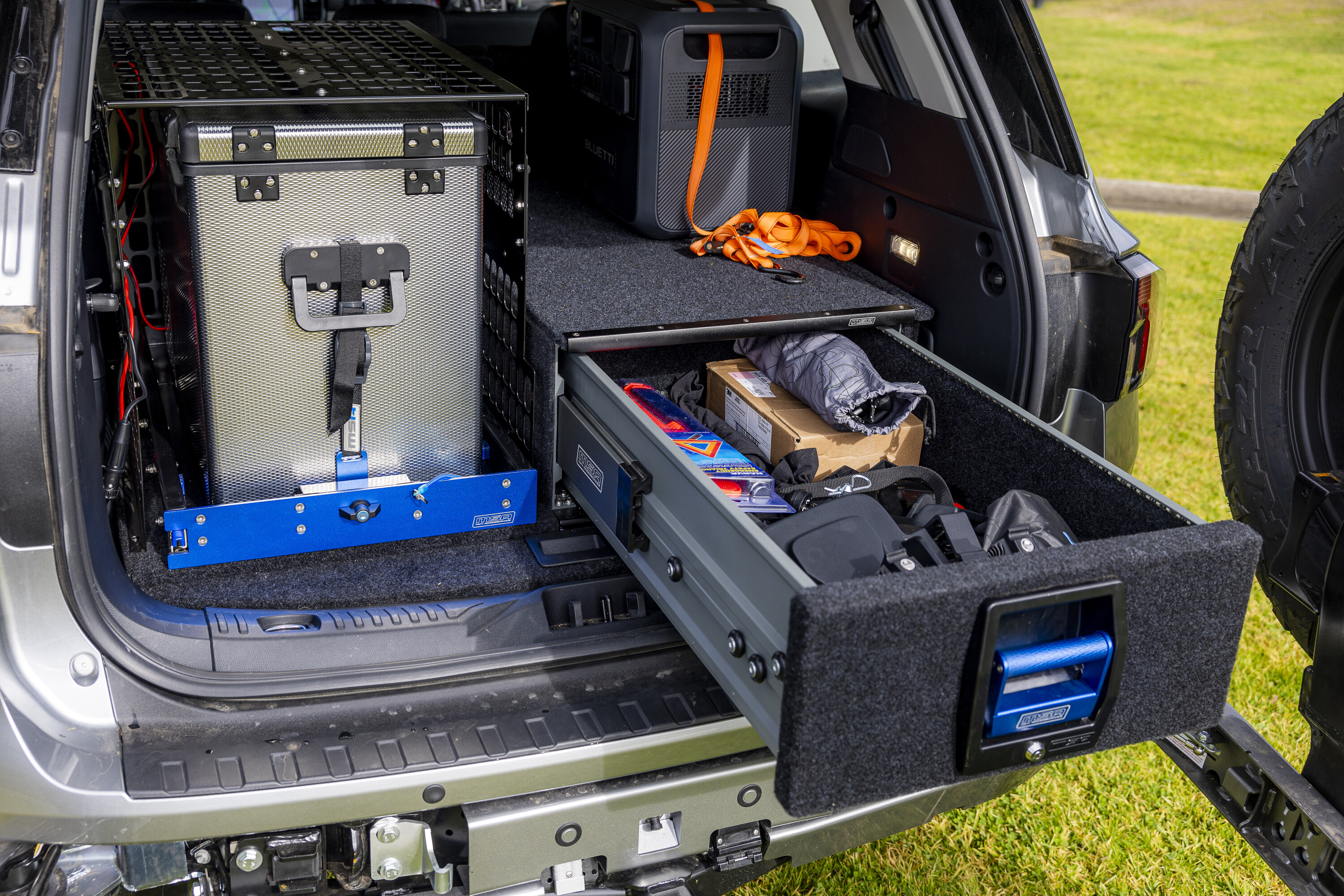
An MSA fridge barrier encloses the fridge and slide and allows us to use the space on top of it, where you can easily strap down camp chairs or soft bags in the available gap. Using the barrier not only protects the fridge from damage but also maintains a decent air gap around the unit for optimum fridge performance.
The fridge slide and barrier perfectly accommodate our National Luna Legacy stainless steel 50-litre dual-zone fridge/freezer and provide easy access to it whenever we need it.
At the time of fitting, MSA 4×4 didn’t have an off-the-shelf kit for mounting its gear in the back of the current-model Everest so a custom frame and false floor had to be fabricated, securing the hardware using the mounts where the third-row seat would have been. The MSA guys used our Everest to set it up with a double or single drawer and the required wing panels, and then removed the near-side drawer to allow room for the fridge slide and barrier. Paul and the team at Statewide 4×4 finished off the installation for us.
MSA’s drawers are a work of art and you can really see that a lot of thought and design work has gone into them. Straight away you can see and feel the quality of the product, with its anodised and knurled handles and catches, the smooth rolling fully enclosed stainless-steel rollers, and the detent that holds the drawer open even if your vehicle is parked nose down.
The quality continues inside with the fully lined drawer and LED light that comes on when you pull the drawer out. And best of all, the drawer pulls out its full length so you can access stuff stored right at the back of it without having to blindly reach in.
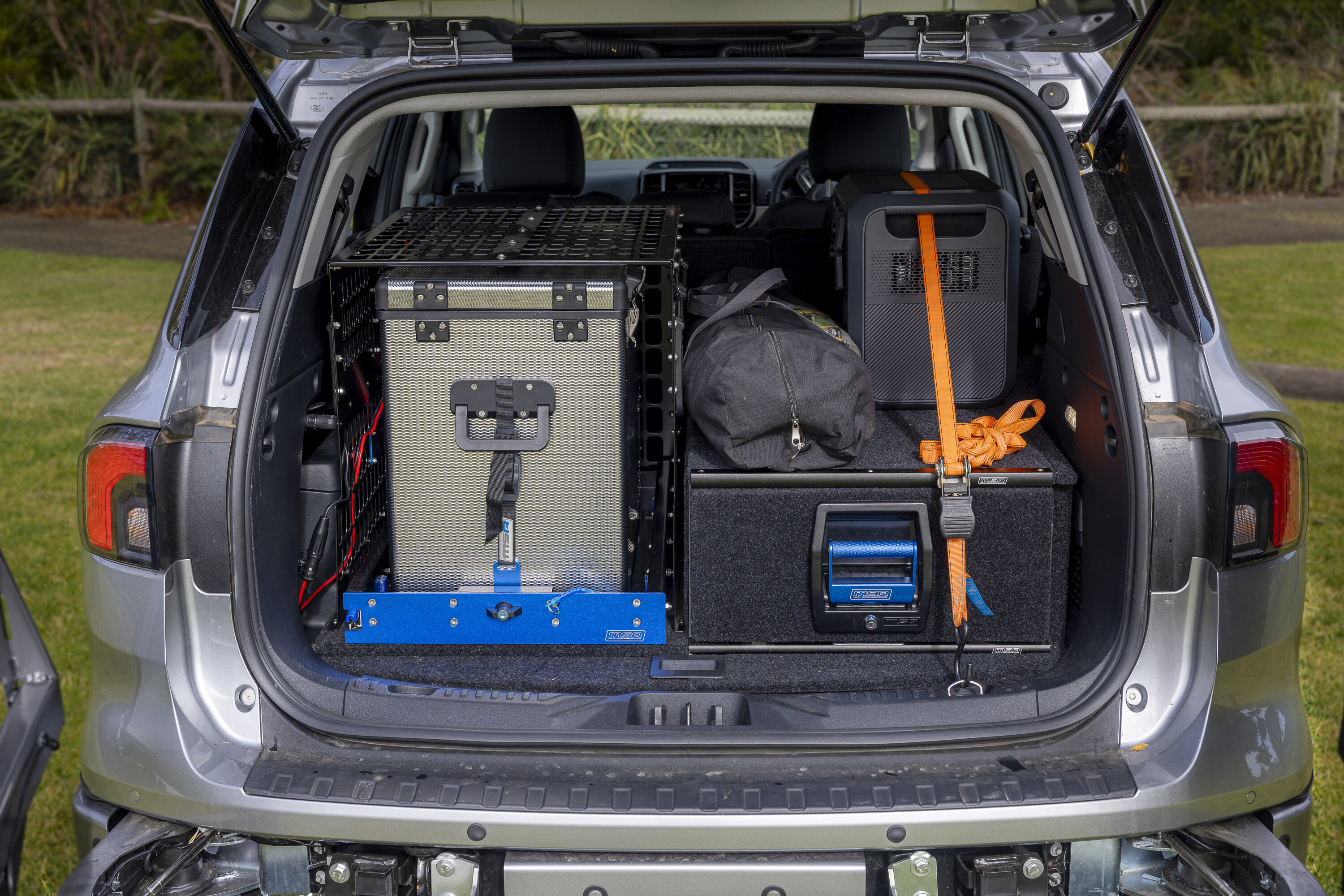
What you might not see in the drawers is the security built into them. MSA’s drawer systems, and the attachments that come with them (cargo barrier mount points and child restraint points), have been crash-tested and are fully ADR compliant; they are tested to ADR3/02, ADR34/01 and ADR42, and passed all the requirements prescribed by the ADRs and AS/NZS, without any structural weaknesses or degradation of the system. That’s something we are yet to see on other such storage systems and provides peace of mind for anyone driving a wagon loaded up with kit and passengers.
While we’ve sacrificed being able to carry bigger items inside the Everest, the MSA 4×4 fitout in the rear of the wagon certainly adds convenience for camping trips and carrying and accessing a fridge.
MSA 4×4: www.msa4x4.com.au [↗️]
National Luna: www.nationalluna.com.au [↗️]
Statewide 4×4: www.statewide4x4.com.au [↗️]
The news comes hot off the back of the revelation of the Ranger Tremor, with the dual-cab ute receiving similar treatment earlier this year.
Much like the Ranger Tremor, the Everest Tremor has received a premium suspension set-up consisting of Bilstein position-sensitive dampers and new springs. Also identical to the Ranger Tremor, the Everest will ride on General Grabber AT3 all-terrain tyres. This suspension and tyre package combines to provide an additional 26mm of ground clearance compared to a stock Everest.
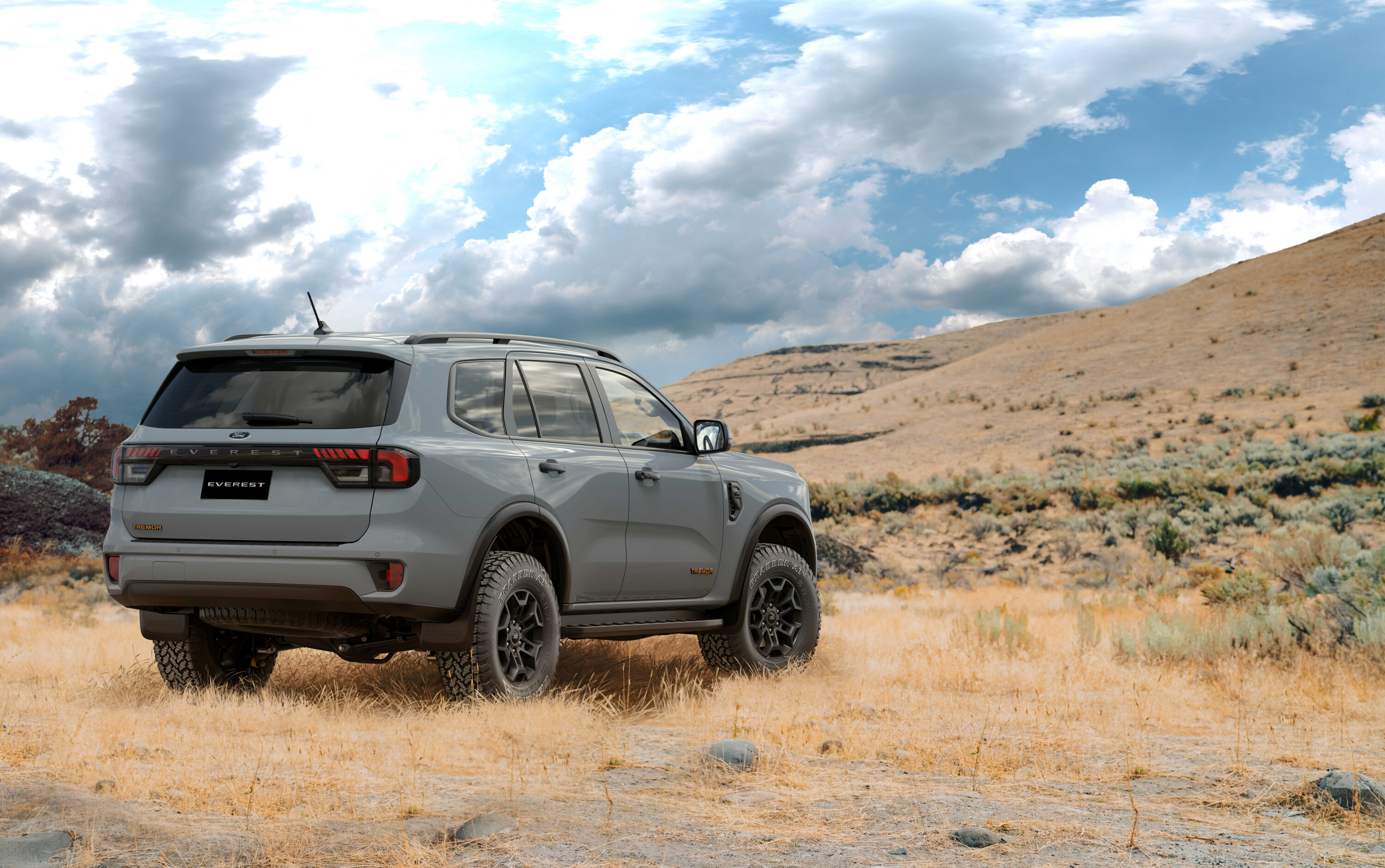
The Everest Tremor is powered by the same 3.0-litre V6 turbo-diesel engine found in Sport and Platinum variants in the regular Everest line-up. That powertrain generates 184kW and 600Nm and runs through a 10-speed automatic transmission. The Everest Tremor is unavailable with the 2.0-litre bi-turbo powertrain.
The Everest Tremor retains the standard vehicle’s maximum braked towing capacity of 3500kg; plus, it benefits from a Rock Crawl drive mode – just like the Ranger Tremor – which is essentially cruise control for off-roading.
“The Everest Tremor answers the call from passionate adventurers who demand even more capability and ruggedness from their SUVs,” said Ambrose Henderson, Marketing Director, Ford Australia.
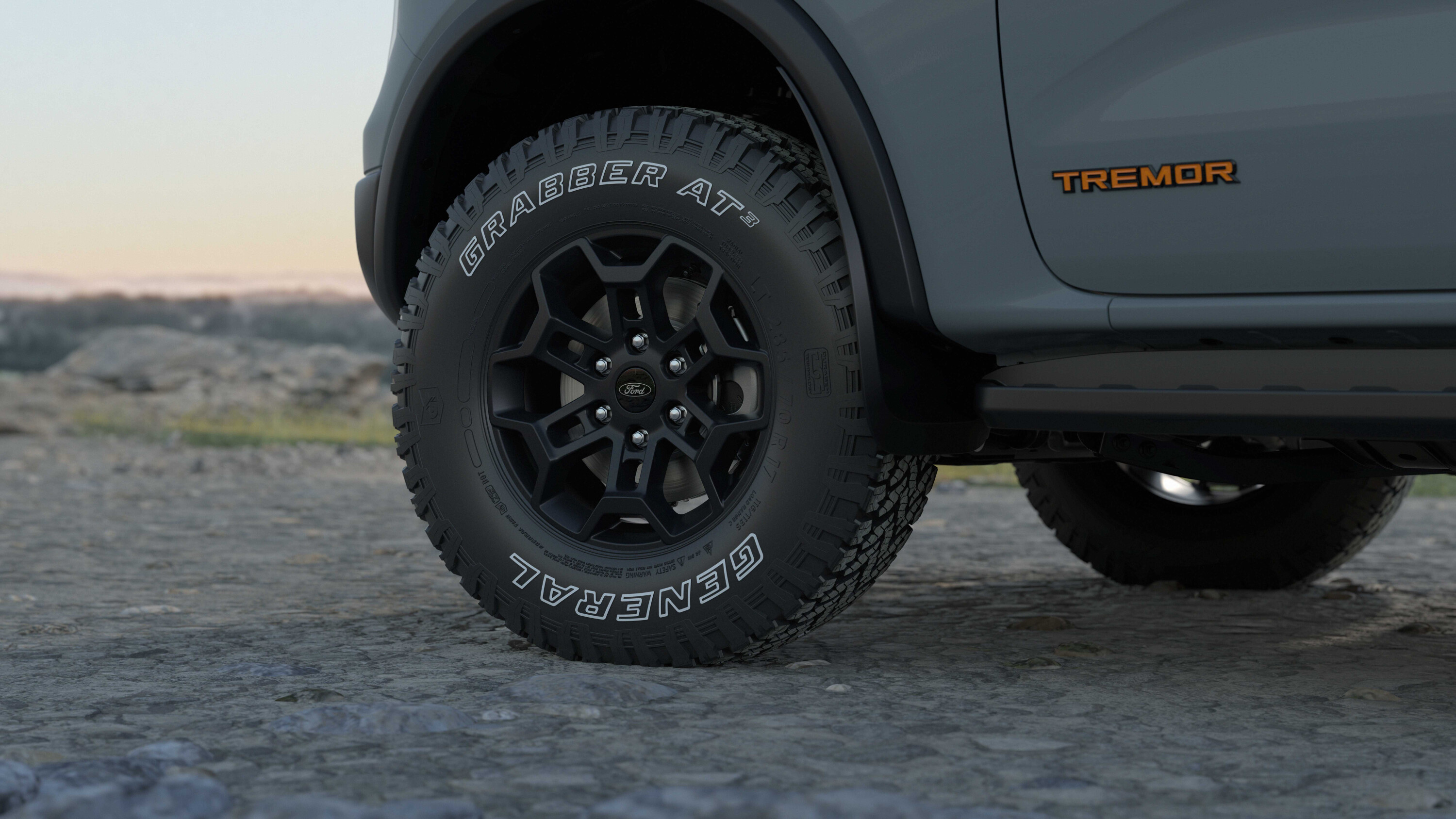
“With its unique combination of off-road effectiveness, towing capacity, and premium features, the Everest Tremor is ready to tackle any adventure, on or off Australia’s various terrains.”
Premium interior features include Tremor-embossed leather-accented seats; ebony-coloured interior accents; and all-weather floor mats. Tech consists of a selectable drive mode system; Ford’s SYNC4 infotainment system; and a comprehensive suite of safety technologies. Optional extras include ?
| Factory-fit options | Price |
|---|---|
| Rough Terrain pack | $3500 |
| Touring pack | $2500 |
| Premium Seat pack | $1100 |
| Towing pack | $1900 |
| Premium paint | $700 |
By signing up, not only will you receive a high-quality magazine packed with off-road goodness – quality car reviews, travel stories, custom builds, product evaluations and more – you’ll also receive a stack of benefits on top.
You’ll get huge savings on the regular cover price of the mag; enjoy free delivery to your doorstep; reap exclusive benefits and discounts; and gain access to a massive digital archive of content.
Yep, by signing up to 4X4 Australia magazine, subscribers get full access to our digital magazine archive which dates back to 2015 – that’s more than eight years of content at your fingertips!
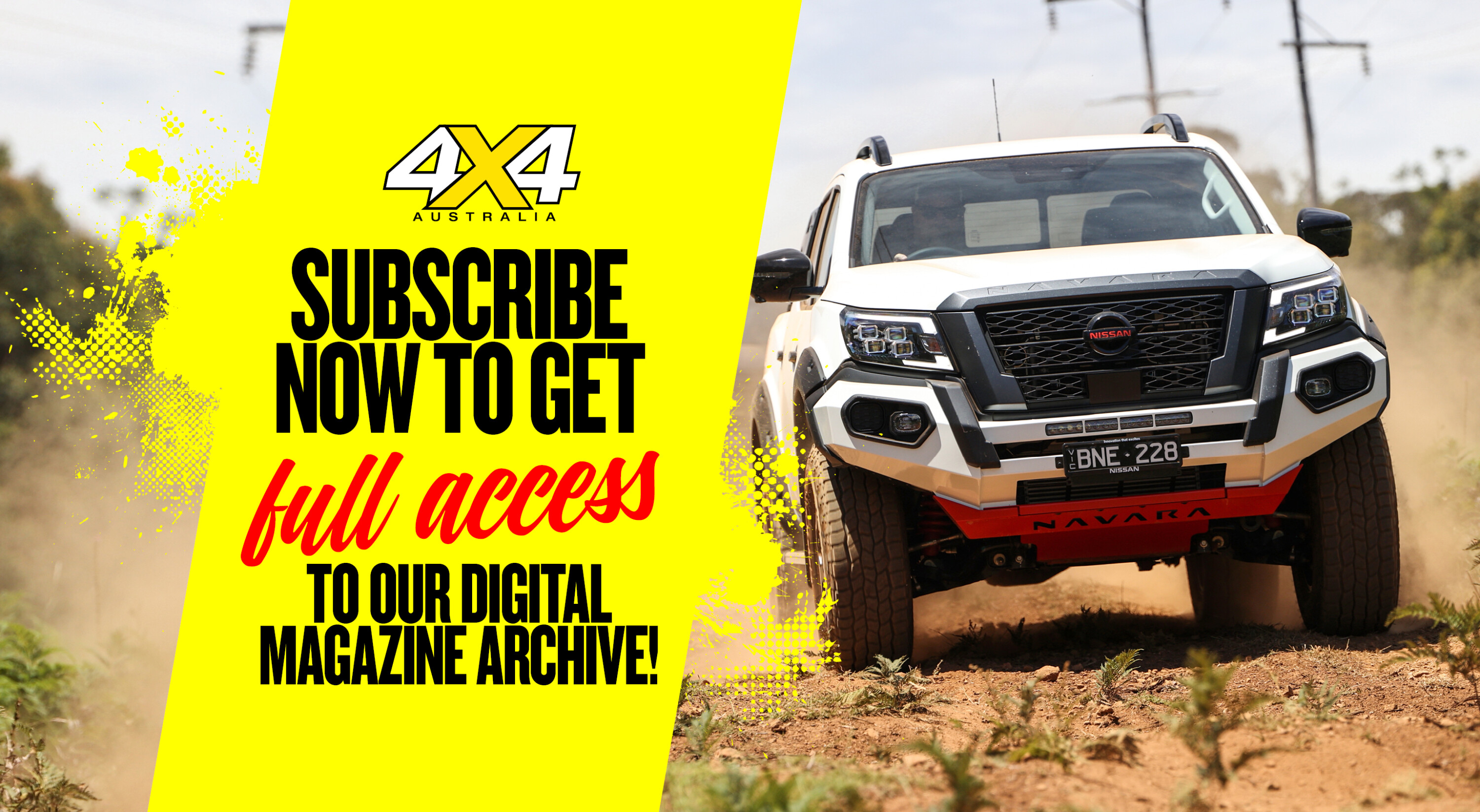
However, despite long waiting lists for premium variants, many manufacturers often have stock sitting in showrooms for lower-spec dual-cab variants. In some cases you could even save yourself up to $30,000 by opting for a base-spec model – giving you plenty of change to splurge on aftermarket accessories and make your vehicle fit for purpose.
Below that sits the Rogue at $70,200 (before on-road costs) and the SR5 at $61,930 (before on-road costs), both in dual-cab pick-up guise. They’re both powered by the same 2.8-litre turbo-diesel engine, but it generates less power and torque than the GR Sport, 150kW and 500Nm in auto form, as the ECU remains unfettled.
There are other dual-cab pick-up models scattered throughout the range – SR5+, WorkMate, and of course the range of V-Active 48V variants – but one of the cheapest ways to land a HiLux dual-cab pick-up is with an SR 4×4 dual-cab pick-up. Sure, a host of cab-chassis and 4×2 models are more budget-friendly, but 4×4 dual-cab pick-ups are generally considered the most versatile.
The SR 4×4 dual-cab pick-up is powered by the same 2.8-litre turbo-diesel that powers the SR5. It runs through either a five-speed manual or six-speed automatic transmission, and both cost closer to $50K before on-road costs are included. The manual fetches $51,895 and the auto $54,045.
The difference of close to $20,000 between the SR and top-spec GR Sport model does mean the lower-spec SR is packed with thriftier (and less) equipment.
| 2024 Toyota HiLux SR features | |
|---|---|
| 17-inch alloy wheels | Higher-grade front bucket seats |
| 4- or 6-speaker sound system | Premium seat upholstery fabric |
| Body-coloured front bumper and door handles | Rear differential lock |
| Drive mode selector | Side steps |
| Front air-conditioned cooler box | Variable intermittent windscreen wipers |
| 2024 Toyota HiLux GR Sport standard features | |
|---|---|
| GR Sport front bumper and fascia | Front underbody skid plate |
| GR sport mesh grille with TOYOTA badge | Red rear recovery points |
| Gloss black exterior treatment | Heavy-duty steel rock rails |
| 17-inch gloss black alloy wheels with 265/65R17 Bridgestone Dueler AT tyres | Five-piece moulded tub-liner with GR branded headboard and anti-slip floor |
ARB has a catalogue brimming with equipment ready to secure to most HiLux models – old and new. Here we’ve narrowed down five ARB items you can install on your brand-new SR HiLux before you take it on its next adventure ?
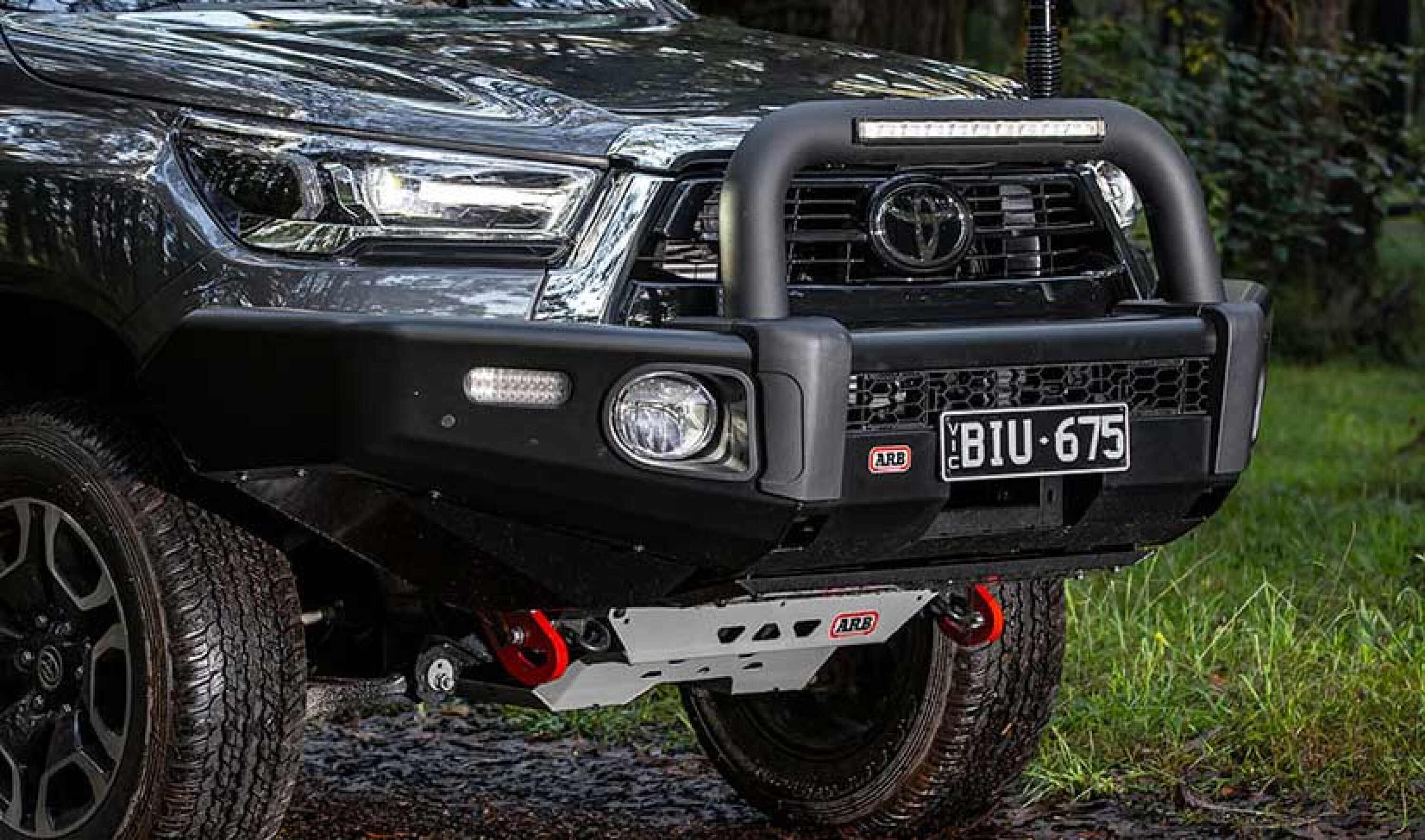
Protect the front end of your HiLux with an ARB Summit MKII bull bar, which fully integrates with the vehicle’s suite of technology and safety systems. The steel bar is robust, designed to comprehensively protect vital components. The Summit bar features a multi-fold upswept and tapered wing design, for optimum strength and approach angle; a 30mm radius on wings and centre section; 60.3mm outer frames and centre cross tube; twin ARB Jack or Hi-Lift jack points; two aerial brackets; winch compatibility; and provisions to add LED lighting.
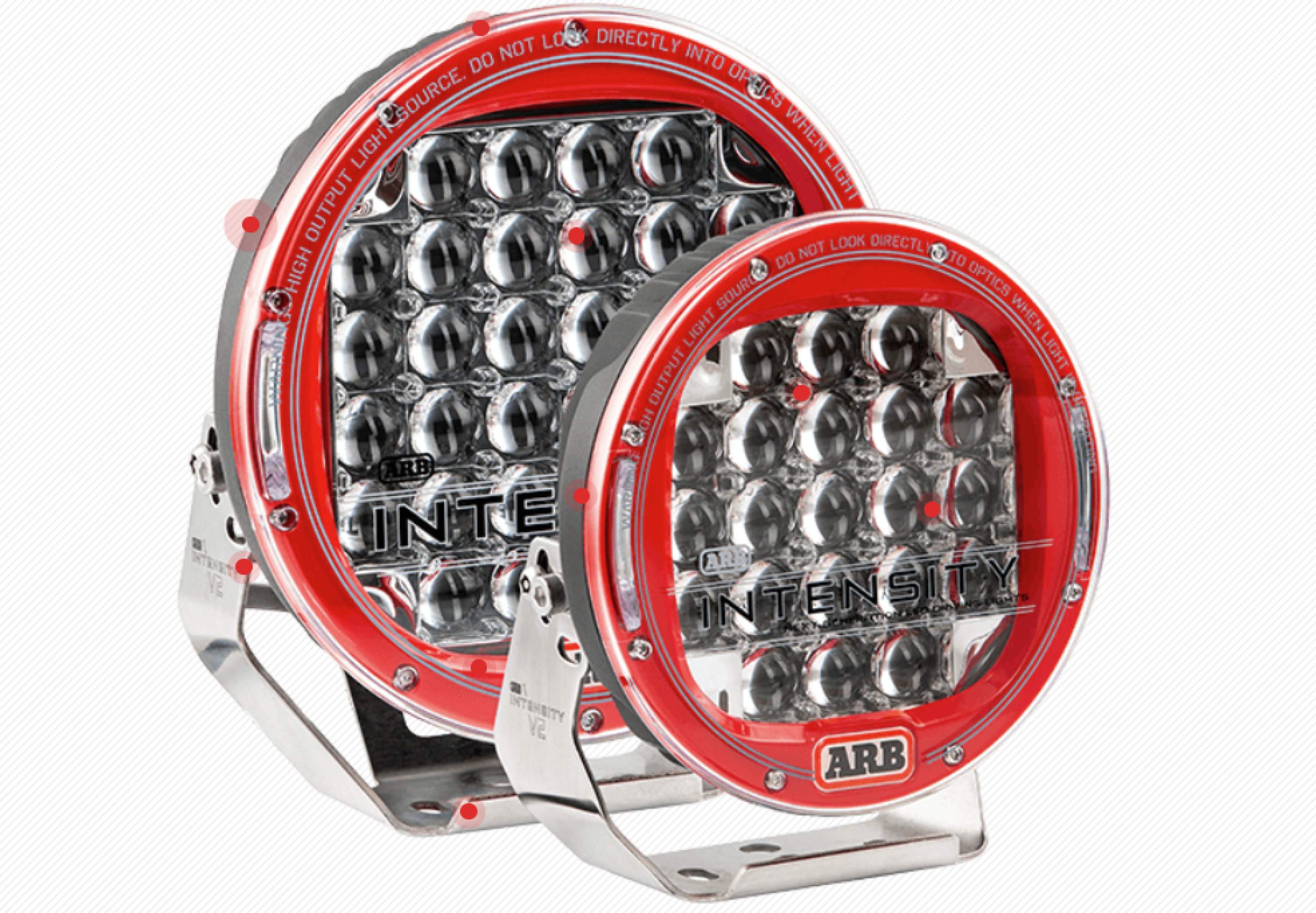
ARB’s range of Intensity LED driving lights consists of round and light bars. The Intensity V2 round driving lights feature high-wattage OSRAM Giant LEDs and are available in larger (AR32) and smaller (AR21) sizes. The AR32 V2 in particular is available in spot and flood beams, and features 32 LEDs with a lifespan of more than 50,000 hours. One AR32 light provides 20,000 lumens, so a pair at the front of your HiLux will provide 40,000 lumens.
The AR40 Intensity V2 LED light bar features 40 also utilises OSRAM Giant LEDs, producing up to 25,080 lumens of raw light output. All LEDS are encased in a polycarbonate lens and powder-coated, extruded aluminium body with high-pressure die-cast end caps. Bull bar mounting brackets are available for quick installation.
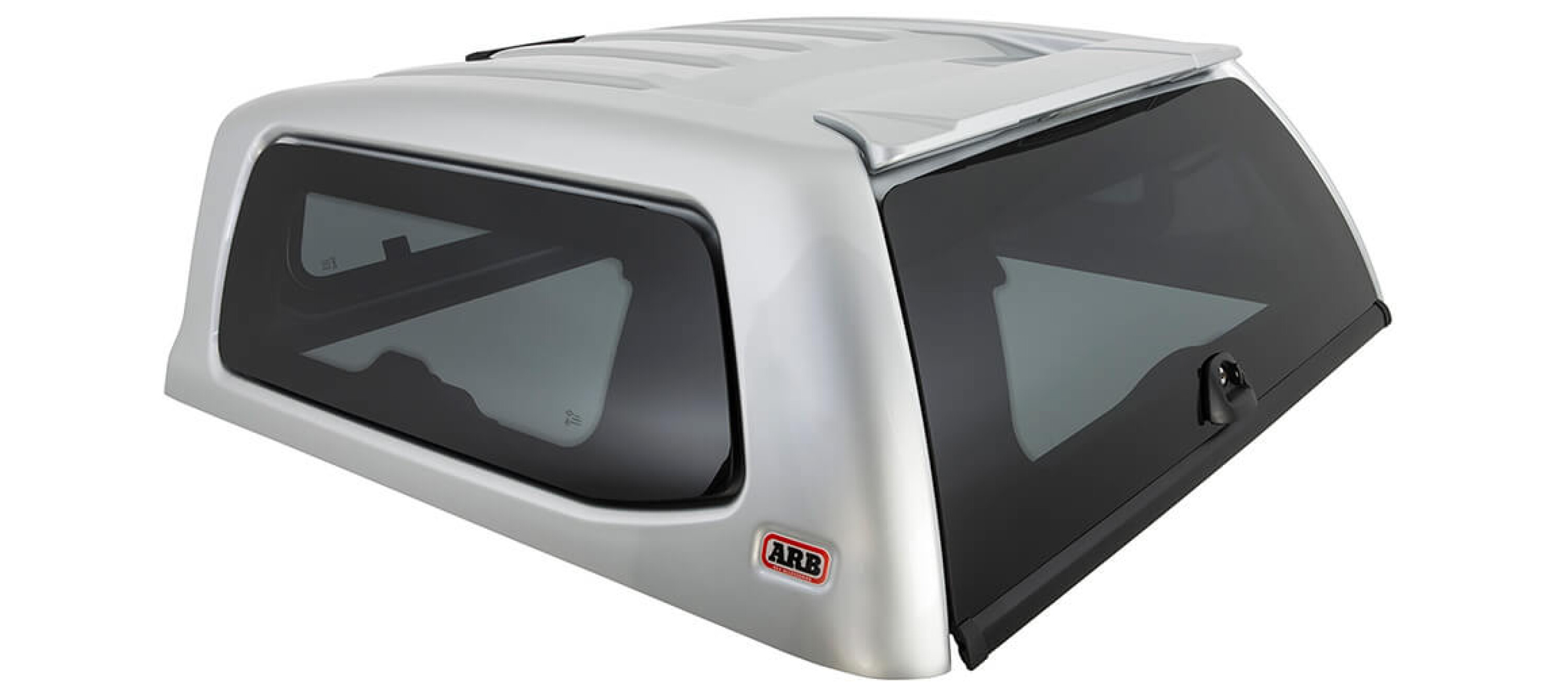
Made from specially formulated, heavy-duty ABS plastic, ARB’s flagship Ascent canopy is designed to integrate seamlessly atop the tray of HiLux SR and SR5 models. Features include remote central locking, premium windows with tinted safety glass; lift-up windows; a high-flow canopy vent; rear-mounted spoiler with LED brake light; push-button opening; an LED interior light; and a vanishing edge design. A host of accessories can further enhance the canopy including an Ascent Window Vent Catch; a roof rack support system; and high-strength ute lines such as Sportguard.
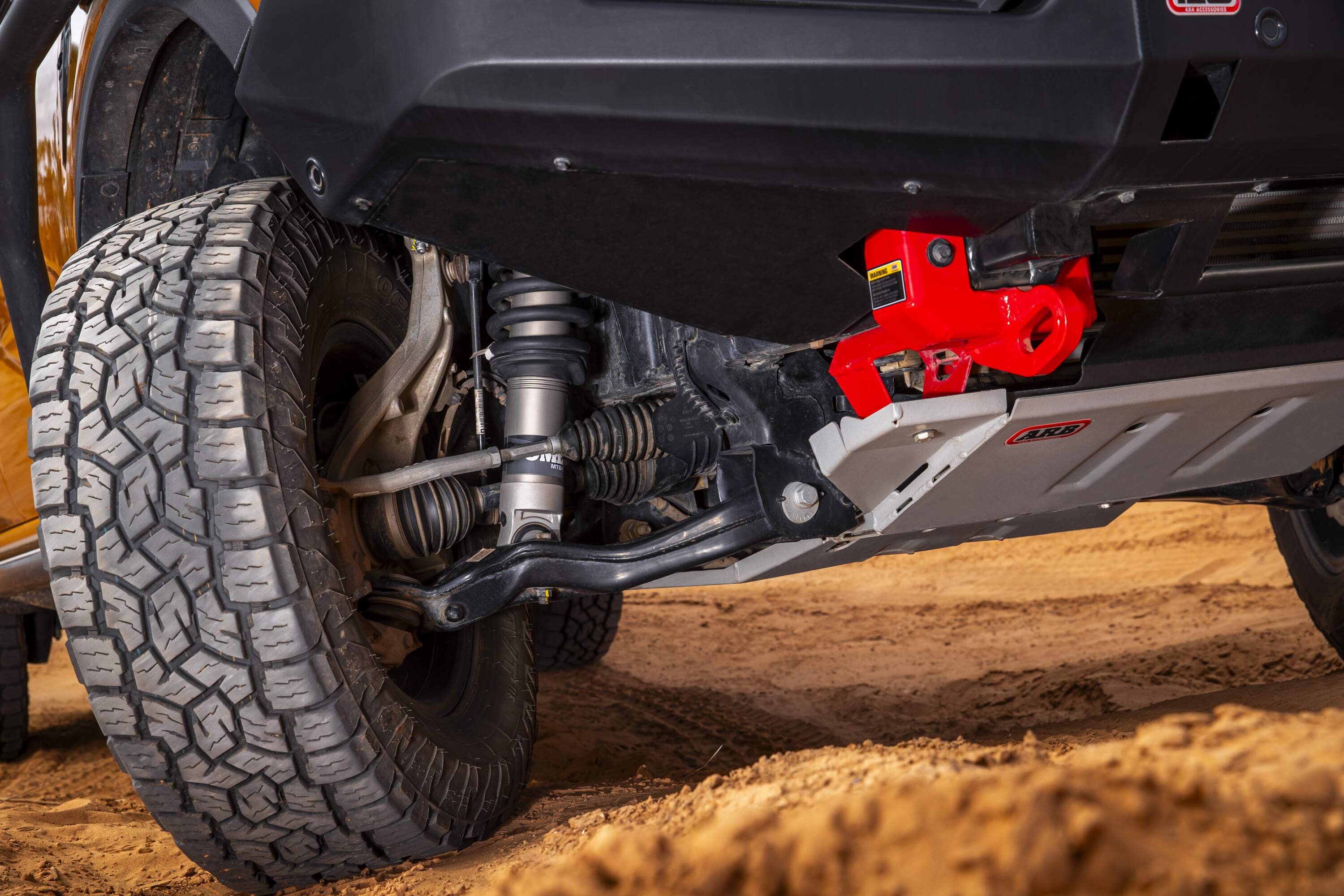
Overhaul the vehicle’s stock suspension with a kit from Old Man Emu (OME), with the brand having a huge selection of springs, shocks and accessories that will transform a vehicle into a tourer or even a hardcore off-roader. The shock absorber range includes Nitrocharger, MT64 and BP-51, and there’ll be a system suited to your needs. OME also offers GVM upgrades in line with ADR requirements.
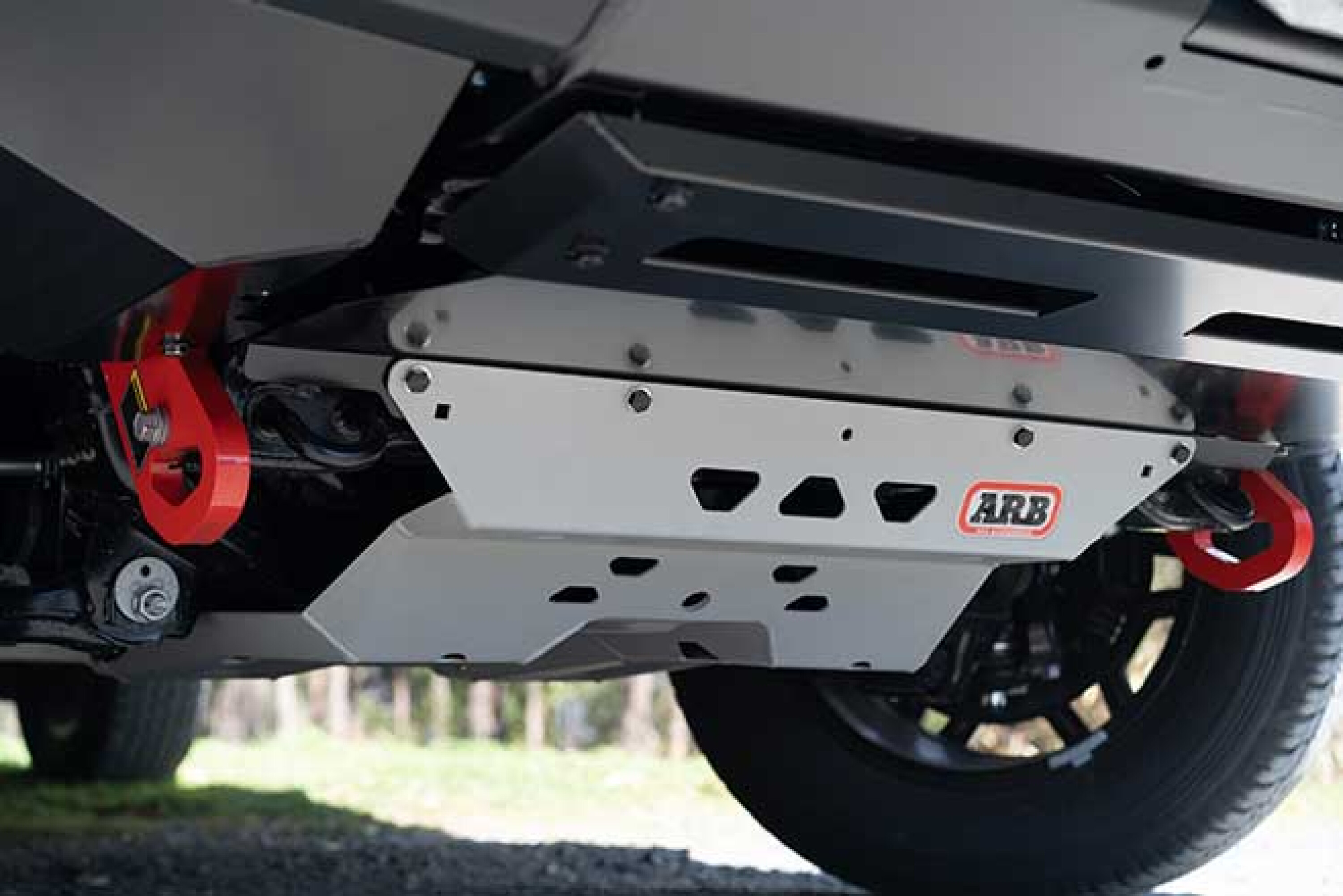
Protecting the vulnerable essentials of a vehicle is paramount if off-roading is on the agenda. ARB under vehicle protection is manufactured from laser cut, pressed and folded 3mm steel (with all steel components protected with zinc plating), so it will protect components such as steering, engine sump, transmission and transfer case. The plate is finished in a hard-wearing silver-textured powder coat, and recessed mounting bolts are easy to remove.
The previous BT-50 shared a majority of its mechanicals with the relentlessly popular and high-achieving Ford Ranger, while this new generation – first introduced in 2020 – stepped away from that Ford collaboration as Mazda paired up with Isuzu to create a BT-50 that is technologically twinned with the D-MAX.
Available in a slightly different combination of powertrain and body configurations to the Isuzu, this generation of BT-50 offers the same basic solid package of the D-MAX with a lick of Mazda style on top.
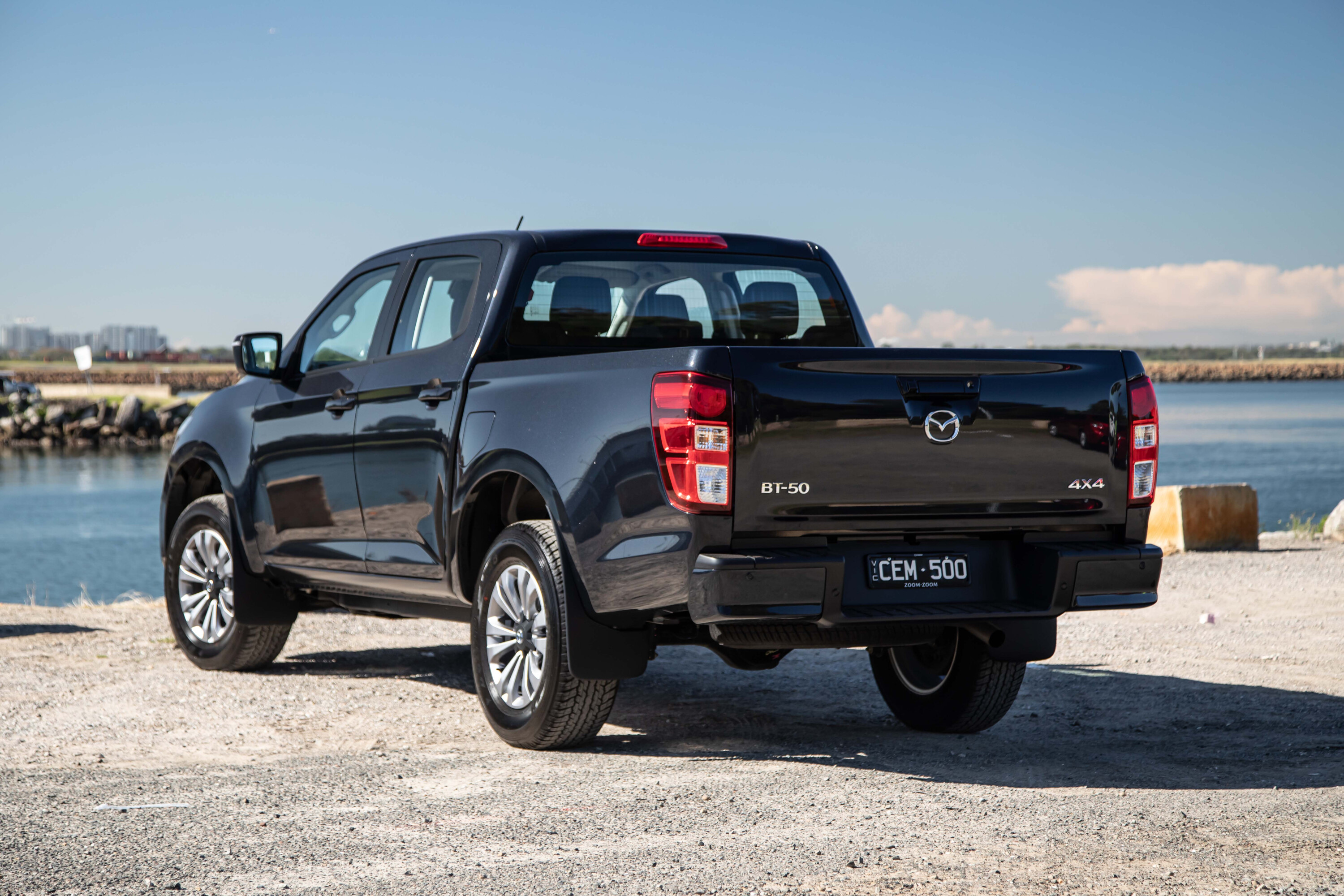
| Model | MLP |
|---|---|
| 1.9L Single Chassis XS 4×2 | $ 35,520 |
| 3.0L Single Chassis XT 4×2 | $ 38,520 |
| 3.0L Freestyle Chassis XT 4×2 | $ 42,020 |
| 3.0L Dual Cab Chassis XT 4×2 | $ 46,060 |
| 3.0L Dual Cab Pickup XT 4×2 | $ 47,460 |
| 3.0L Dual Cab Pickup XTR 4×2 | $ 51,540 |
| 3.0L Single Chassis XT 4×4 | $ 43,520 |
| 3.0L Single Chassis XT 4×4 | $ 46,020 |
| 3.0L Freestyle Chassis XT 4×4 | $ 47,020 |
| 3.0L Freestyle Chassis XT 4×4 | $ 49,520 |
| 3.0L Dual Cab Chassis XT 4×4 | $ 51,330 |
| 3.0L Dual Cab Chassis XT 4×4 | $ 53,830 |
| 3.0L Dual Cab Chassis XTR 4×4 | $ 57,880 |
| 3.0L Dual Cab Chassis GT 4×4 | $ 61,260 |
| 3.0L Dual Cab Pickup XT 4×4 | $ 52,730 |
| 3.0L Dual Cab Pickup XT 4×4 | $ 55,230 |
| 3.0L Dual Cab Pickup XTR 4×4 | $ 56,780 |
| 3.0L Dual Cab Pickup XTR 4×4 | $ 59,280 |
| 3.0L Dual Cab Pickup GT 4×4 | $ 62,660 |
| 3.0L Dual Cab Pickup SP 4×4 | $ 68,690 |
| 3.0L Dual Cab Pickup Thunder 4×4 | $ 74,095 |
It is classed as a light commercial vehicle. Cab-chassis models allow buyers to fit the tray of their choice, including designs tailor-made for specific applications. Single-cab or ‘Freestyle’ cab models come only in this form but you can have the dual cab either as a cab chassis or with a factory tub at the back.
Single-cab models only have room for two passengers, while Freestyle cab versions add two extra rear ‘jump seats’ accessed through shorter, rear-hinged back doors and can seat four. Dual-cab models have larger, more conventional rear doors and can seat five.
A dual-cab chassis GT variant was introduced to range in 2024, with the GT badge formerly only reserved for dual-cab pick-up variants.
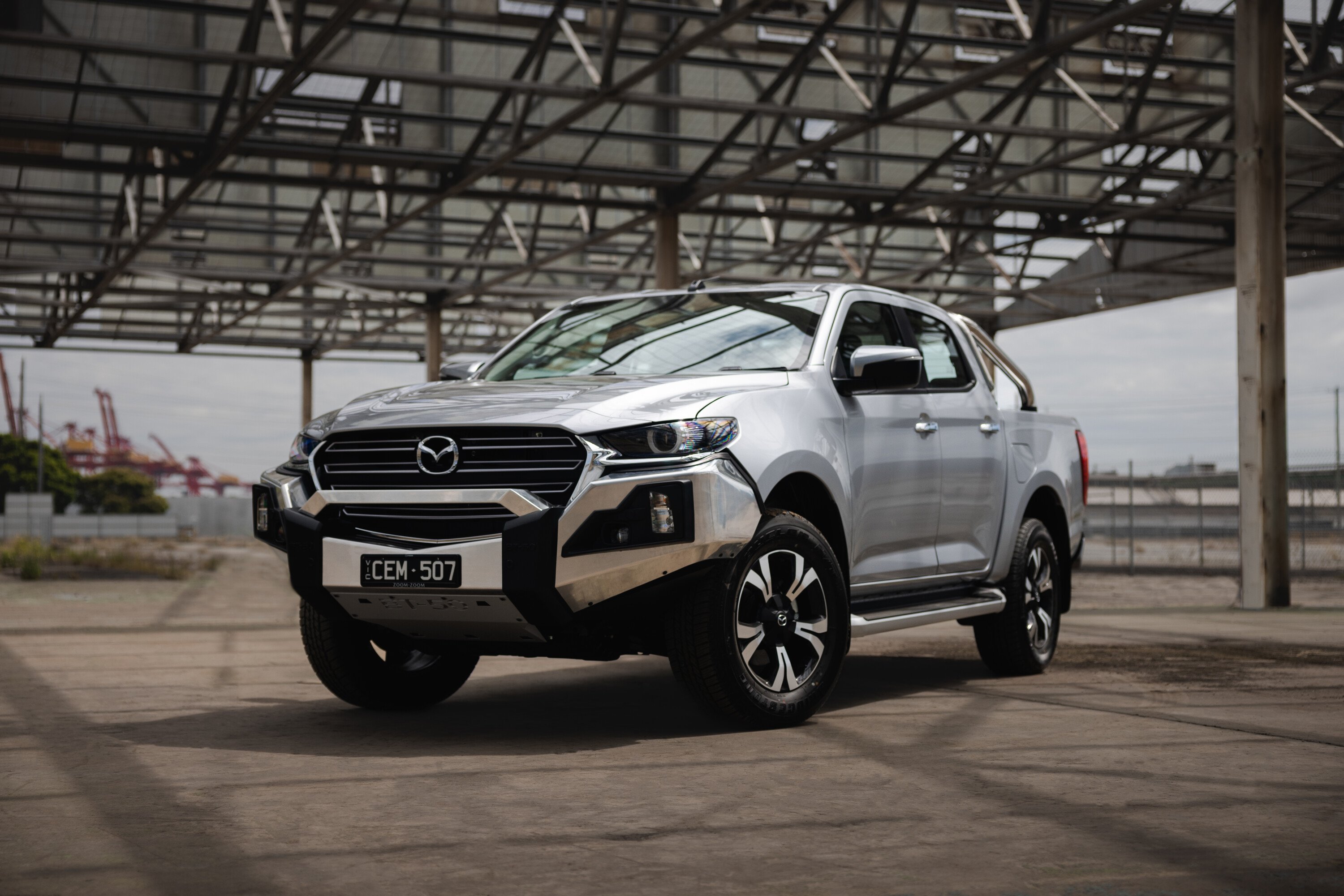
In May 2024, Mazda added a Rough Terrain Mode on all 4×4 models. Mazda also introduced the ability for accessories to remain powered after the engine has been shut-off, on XTR models and above. Lower-spec XS and XT variants also gained an auto relock functionality, which was already standard on XTR models and above.
A premium infotainment upgrade accessory package was released in 2024 to suit the XTR cab chassis and pick-up; XTR LE pick-up; GT pick-up; SP pick-up; and Thunder pick-up. It’s unavailable for all lower-spec XS and XT variants, but it can be retro-fitted to suitable model grades.
The package replaces the standard nine-inch display with a new, larger 11-inch WXGA high-definition laminated touchscreen head unit developed by Alpine Electronics. The head unit is embedded with wireless Apple CarPlay and Android Auto; TIDAL high-res audio streaming app; HEMA off-road navigation; and it offers dual USB-C, HDMI and AUX interfaces. Plus, an in-built Class D audio amplifier channels sound to a crossover unit that is specifically tuned for the BT-50’s cabin.
| 2024 Mazda BT-50 standard features | |
|---|---|
| Colour seven-inch touchscreen, one 12v auxiliary and two USB input sockets. | Wheels (17-inch) made from steel, and a full-size steel spare wheel. |
| Android Auto (wired) and Apple CarPlay (wired or wireless | AM/FM and DAB+ radio |
| Bluetooth connectivity for phone calls and audio streaming. | Hill-assist control, which operates the brakes automatically to make take-offs on hills easier. |
| Reversing camera. | Downhill brake control, which can regulate speed automatically on steep downslopes when driving off-road. |
| Sound system with at least four speakers. | Eight airbags, including driver knee airbags |
| Single-zone climate control. | Electronic stability control |
| Driver seat height adjustment. | autonomous emergency braking |
| Vinyl floor covering. | brake assist |
| Adaptive cruise control (auto models only). | high beam control |
| Halogen daytime running lights and LED headlights. | forward collision warning |
| Auto-on headlights. | lane departure warning |
| Rain-sensing windscreen wipers. | traffic sign recognition |
| Active safety features including autonomous emergency braking, forward collision warning, and lane-keeping assist. | driver attention warning |
| Controls on the steering wheel for operating the cruise control, the sound system and Bluetooth. | blind-spot monitor system including rear-cross traffic |
| An automatic transmission (standard on 4×2, optional on some 4×4 models). | Locking rear differential which ensures the rear wheels turn at similar speeds to improve traction and handling (standard on 4×4). |
| A trip computer that presents fuel use and distance information. | |
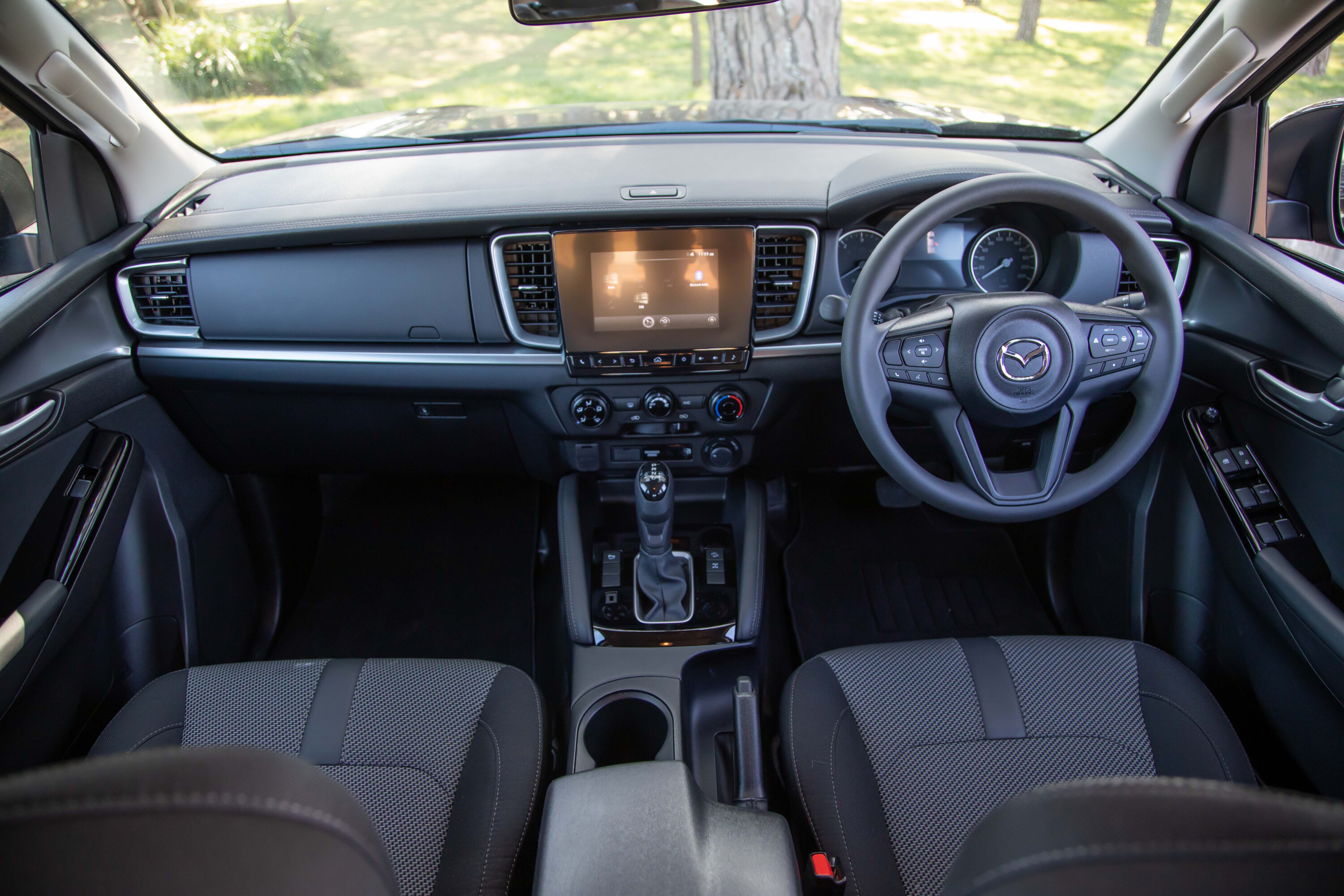
The starting point in dual-cab form is the XS pick-up, available in 4×2 or 4×4 configuration with the 1.9-litre 110kW and 350Nm four-cylinder turbo-diesel engine and six-speed automatic transmission combination.
Upgrading to XT specification (also available in 4×2 or 4×4) offers a bigger 140kW/450Nm 3.0L diesel engine with a six-speed auto only in 4×2 guise and with a six-speed manual (with six-speed auto option) as a 4×4.
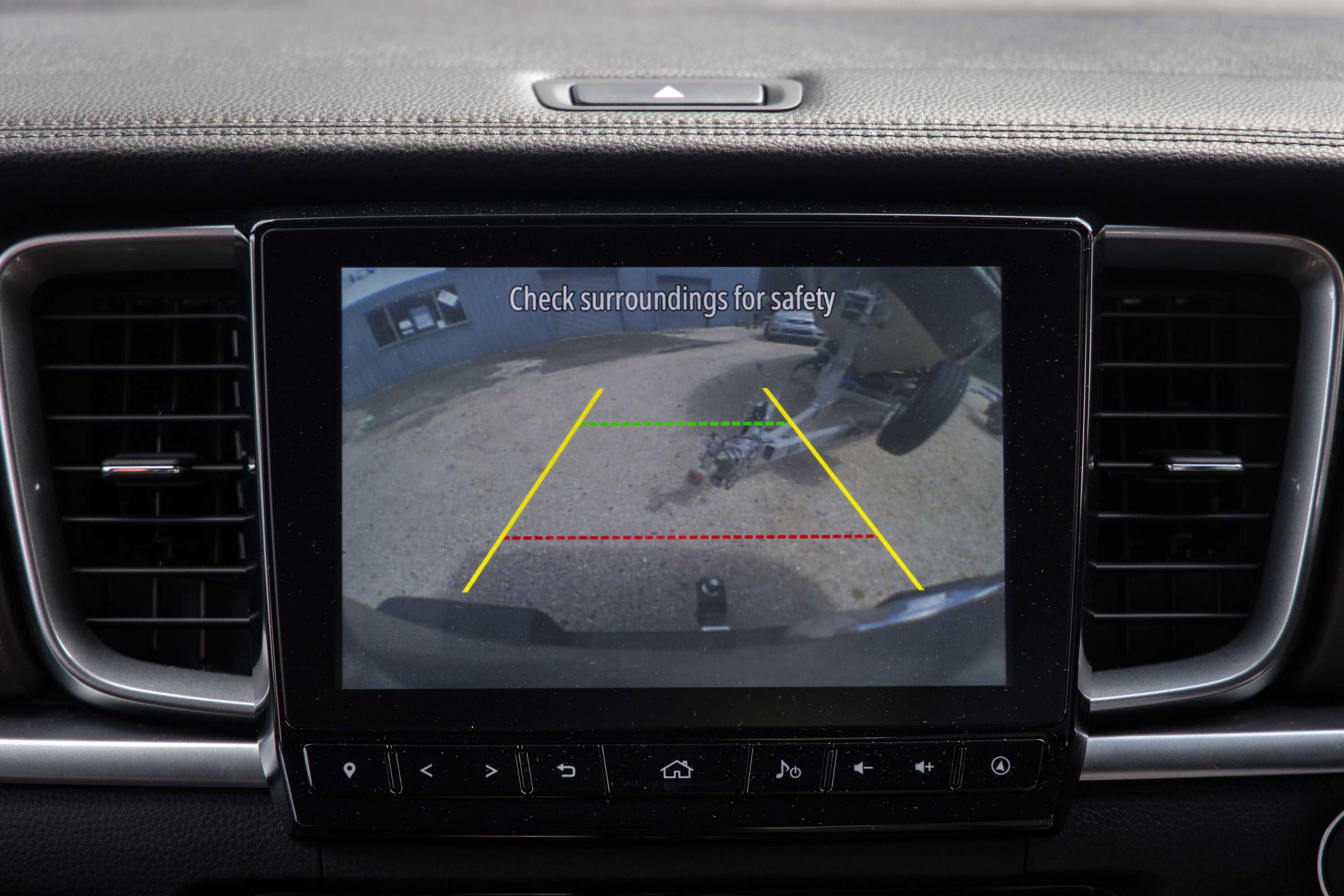
For extra features, you could spend more for a BT-50 XTR, which like the XT is available with the manual or auto 3.0-litre diesel with rear-wheel drive 4×2 or part-time 4×4.
| 2024 Mazda BT-50 XTR features | |
|---|---|
| Auto-dimming rear-view mirror. | Six speakers. |
| Leather steering wheel. | Smart Keyless entry and start that doesn’t require you remove your keyfob from your pocket or bag. |
| Driver seat lumbar adjustment | LED front fog lights. |
| Dual-zone climate control. | Power folding side mirrors. |
| Nine-inch infotainment screen. | 18-inch alloy wheels |
| Satellite navigation | Silver side steps. |
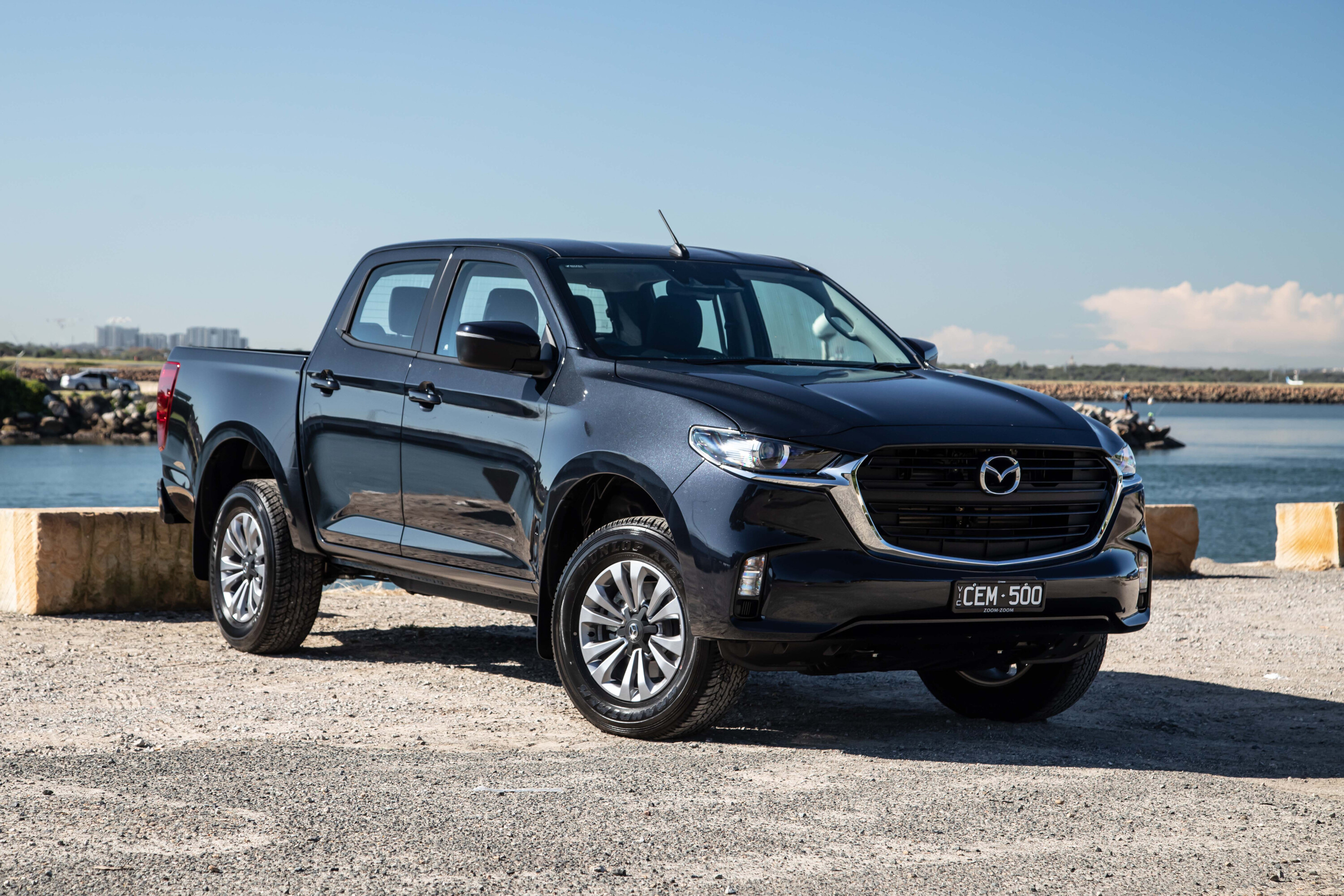
| 2024 Mazda BT-50 GT features | |
|---|---|
| Standard 3.0L, 6 Sp Automatic 4×4 powertrain. | Heated front seats. |
| Remote engine start. | Chrome, heated side mirrors. |
| Leather seat trim. | Front parking sensors. |
| Driver seat cushion height and tilt adjustment, powered. | |
| 2024 Mazda BT-50 SP features | |
|---|---|
| Leather and synthetic suede seat material | Lower front bumper garnish. |
| Fender flares in gloss black. | Tub liner, to protect the painted finish of the inner tub area. |
| Sail plane in gloss black | Manual aluminium roller tonneau cover. |
| Gloss black painted wheels, side mirror caps, grille. | |
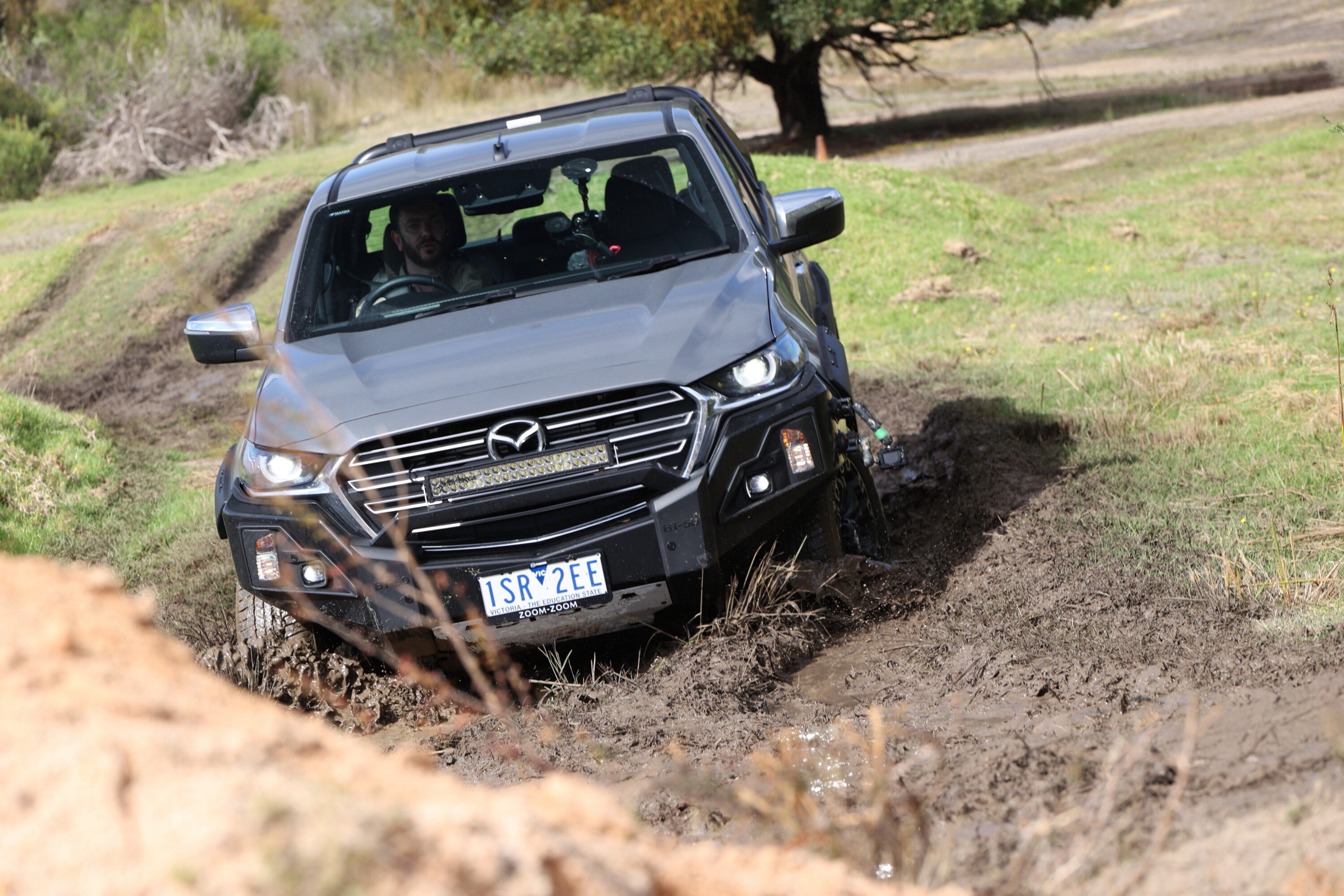
| 2024 Mazda BT-50 Thunder features | |
|---|---|
| Leather seats. | Premium black steel rear hoop bar. |
| Single hoop bull bar in matt black. | Black side steps. |
| Lightforce 20-inch dual-row LED lightbar. | Fender flares in matt black. |
| Powered aluminium roller tonneau cover. | Chrome, powered, folding side mirrors. |
Accordingly, the Australasian New Car Assessment Program (ANCAP) awarded the BT-50 with its full five-star rating in 2020.
The model scored well in child occupant protection as well as safety assistance systems thanks in part to the inclusion of standard auto emergency braking (AEB) and lane-keep technology.
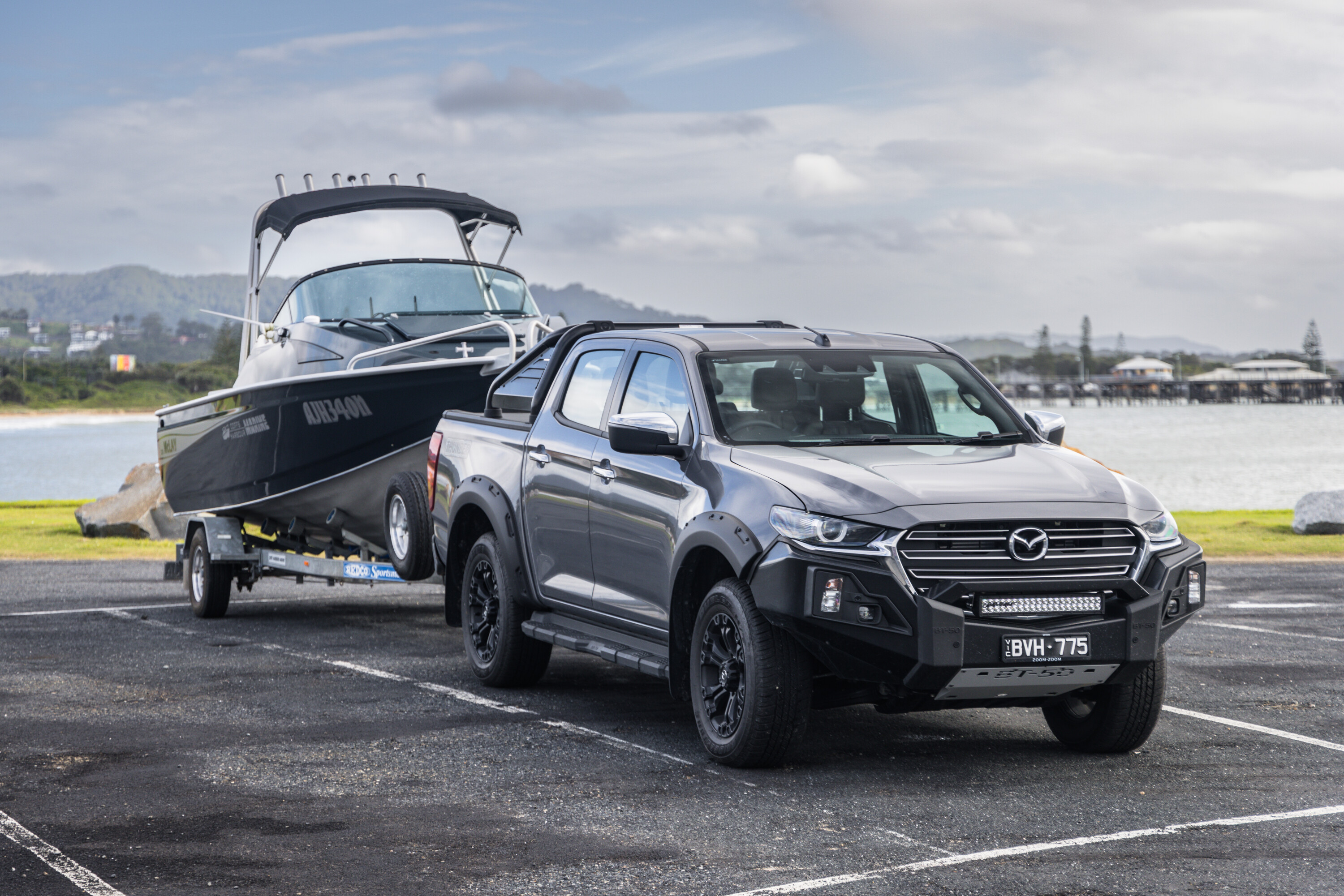
Other standard safety features include eight airbags, ISOFIX and top tether anchors for two child seats in the second row, blind-spot monitoring, speed sign recognition, driver fatigue monitoring, adaptive cruise control, rear cross-traffic alert and a reversing camera.
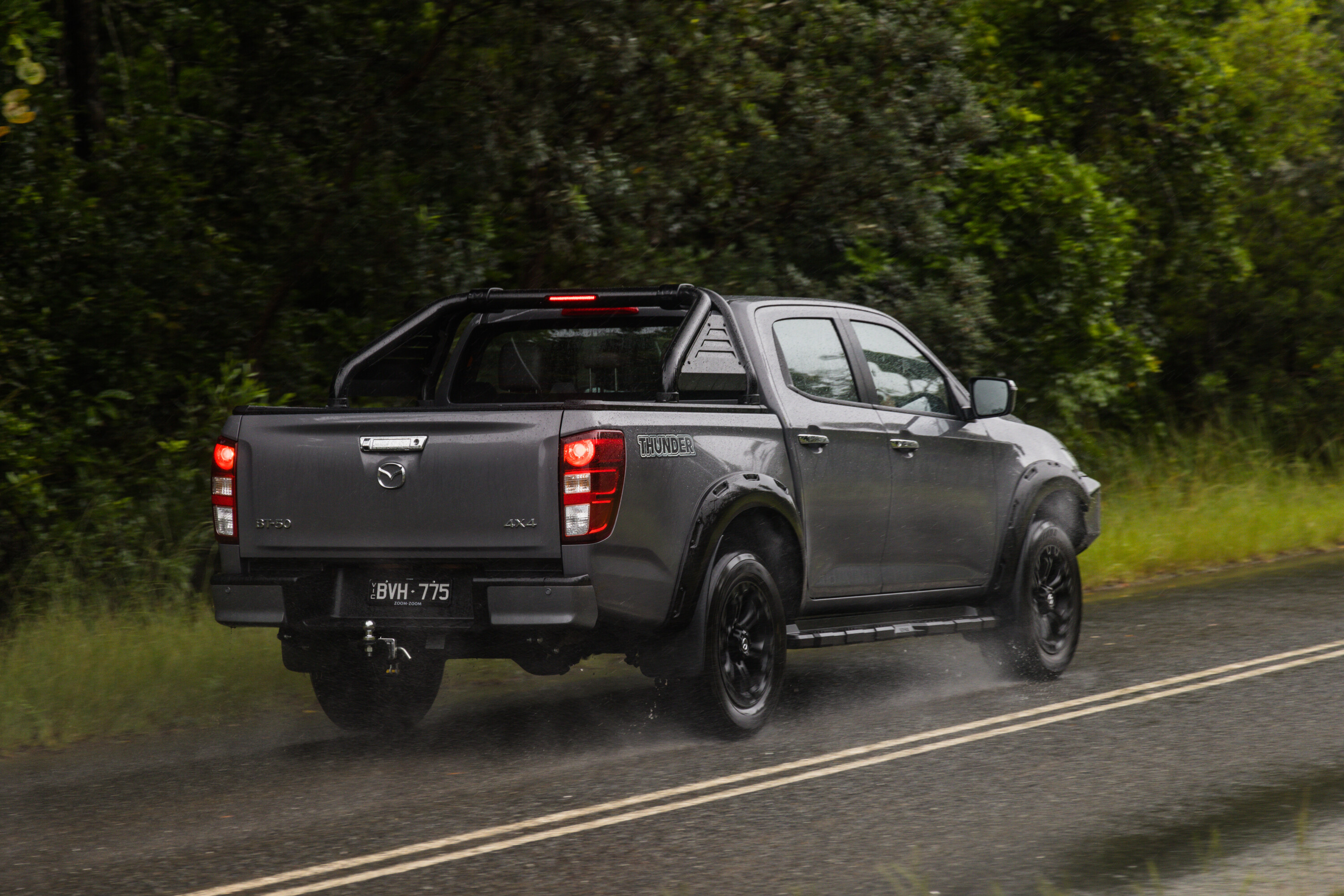
The Mazda shares much of its underpinnings with the Isuzu D-Max but manages to introduce some differentiation including its more luxurious cabin finish, and in upper-spec models, electric driver’s seat adjustment, a classier black roof lining and heated front seats.
Its front seats are as comfortable as they look and offer a generous 90mm of headroom for the driver. The impressive 9.0-inch central touchscreen is one interior item that the BT-50 does have in common with the Isuzu and while it has sharp graphics and decent features, the system takes more than 20 seconds to boot up after the engine is started.
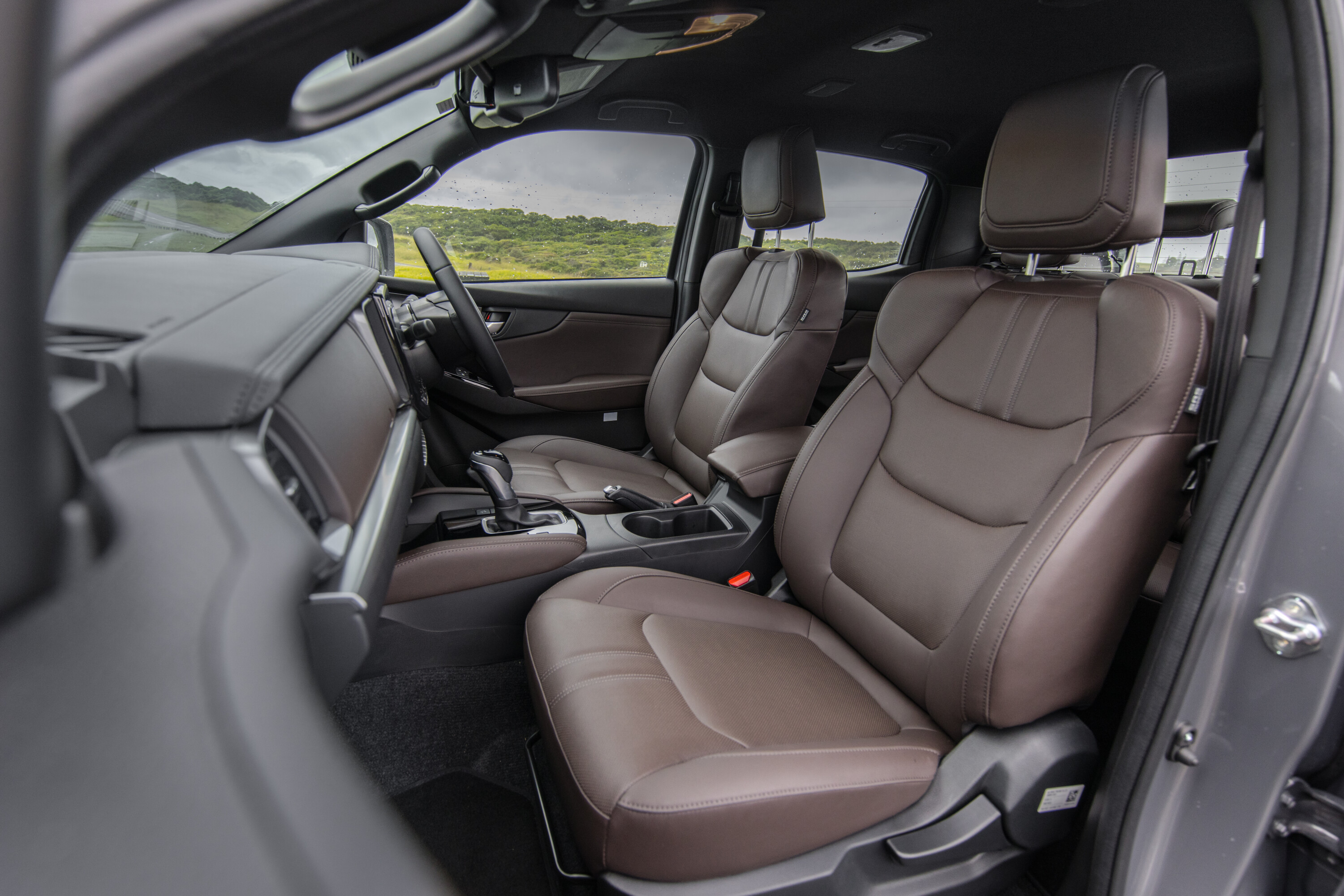
There’s also a neat double glove box that boosts interior stowage capacity and options.
Unlike some others, the information and entertainment system does not incorporate the climate control functions, instead relegating them to a specific panel below with a clean digital display and physical switches.
Also common to both Isuzu and Mazda are a small, sporty and ergonomic steering wheel covered in top-quality leather with two-way adjustment, an upholstered dashboard with real stitching, a big phone storage tray, and USB-A and 12-volt power for the front row.
There’s also a neat double glove box that boosts interior stowage capacity and options. Second-row passengers are also well looked after with a whopping 100mm of knee room, another USB socket, ample toe room, and great visibility even for smaller occupants.
Headroom is limited in the second row with just 40mm of space and the rear doors don’t open as wide as some other utes, which could make loading people and things a little trickier.
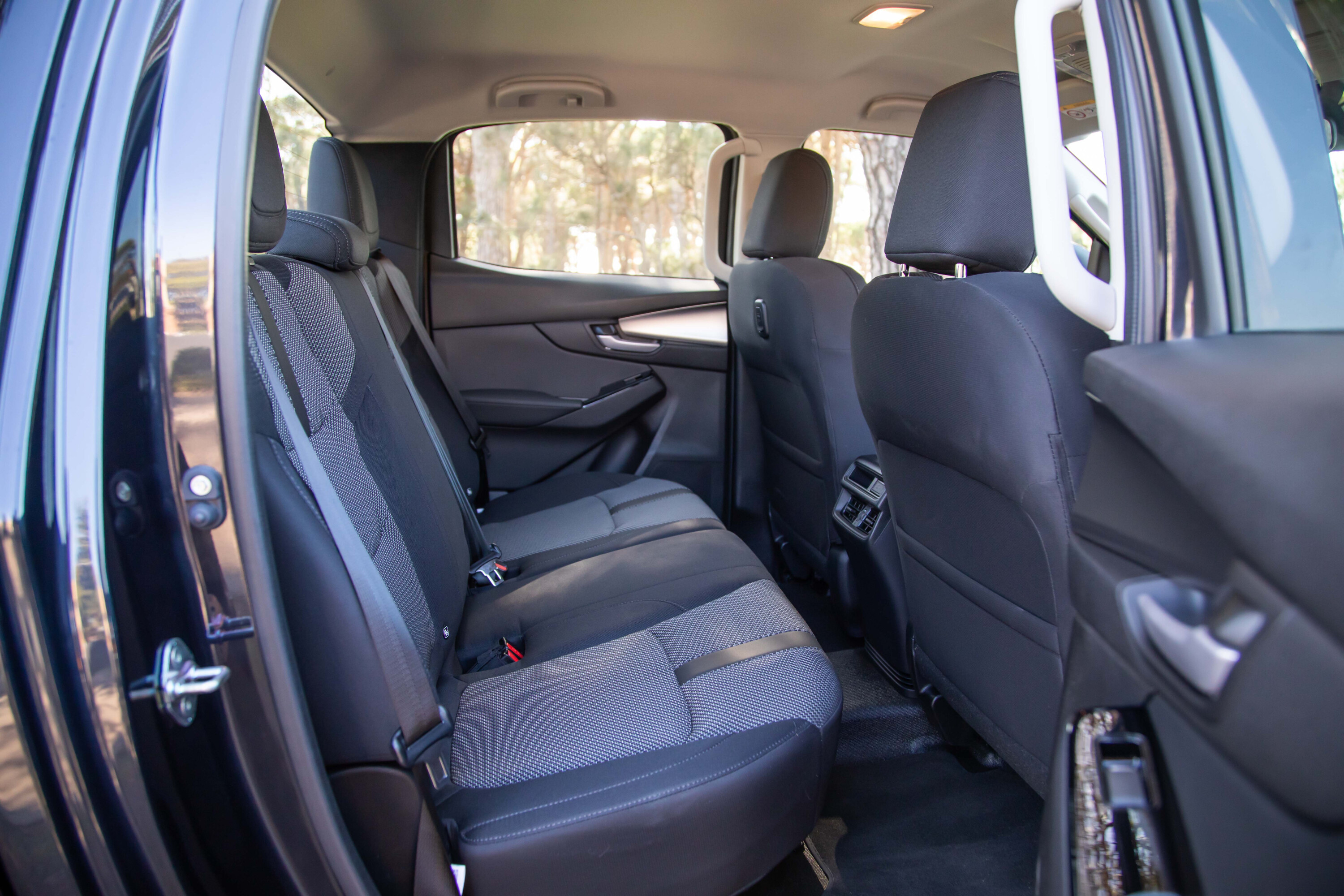
The BT-50 tray measures 1571mm long by 1530mm wide and features just two tie-down points, towards the rear of the tray.
With a payload of up to 1065kg, the BT-50 is a true one-tonner and, with the 3.0L engine, it has a 3500kg braked towing capacity.
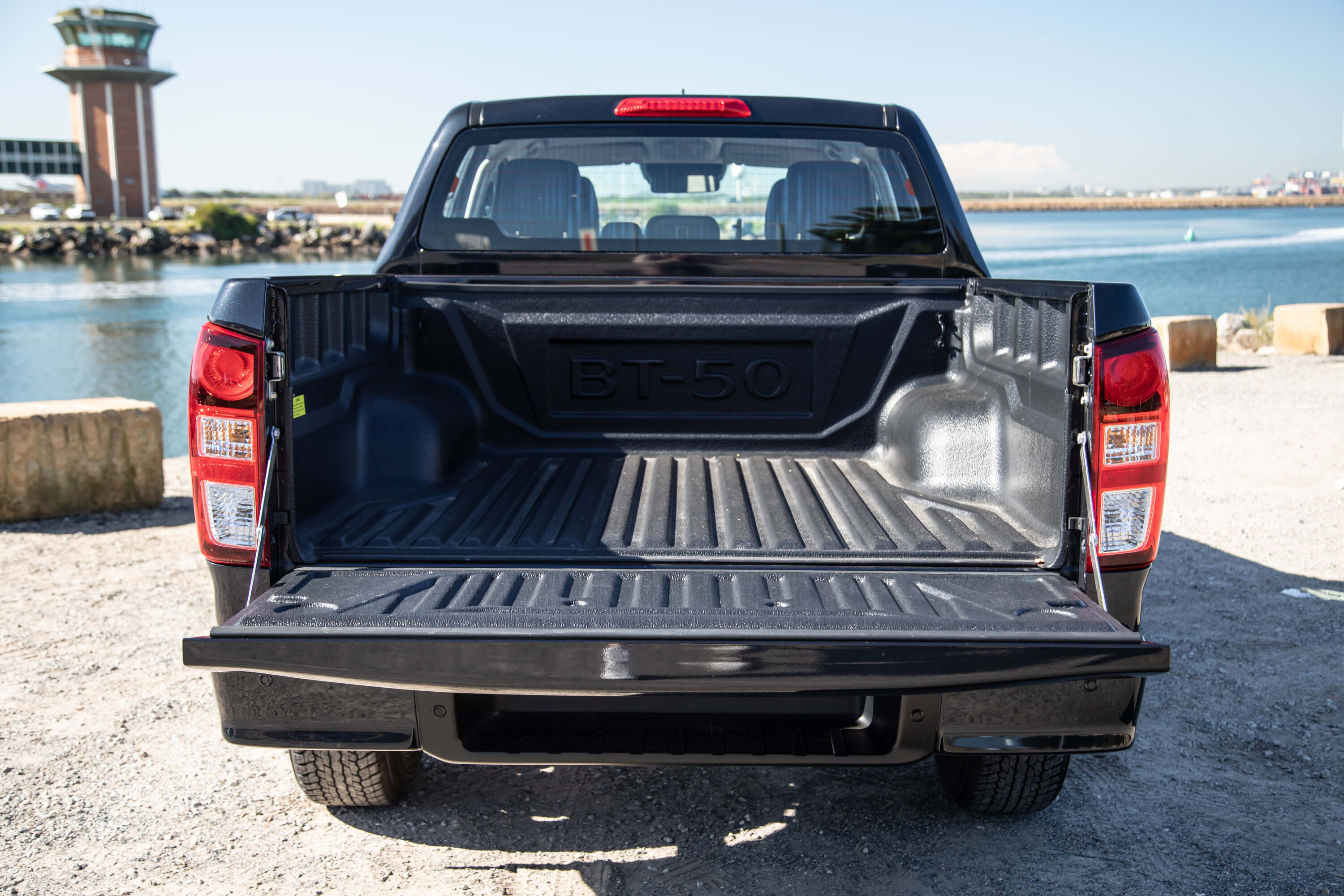
With its D-Max shared underpinnings, the BT-50 offers the same sweet steering that is direct and mechanical but not rough, as well as handling that makes the Mazda very easy to position on the road.
Driving dynamics are generally similar but the BT-50 chassis tune has been softened off slightly for a more comfortable ride while maintaining enough entertainment and involvement for the driver. The result is a level of dynamics and comfort that manages to keep all occupants happy.
It’s also one of the best to live with in tighter spots thanks to overall proportions that feel smaller (in the right way) and good outward visibility. This nicely pairs with the parking radar and reversing camera.
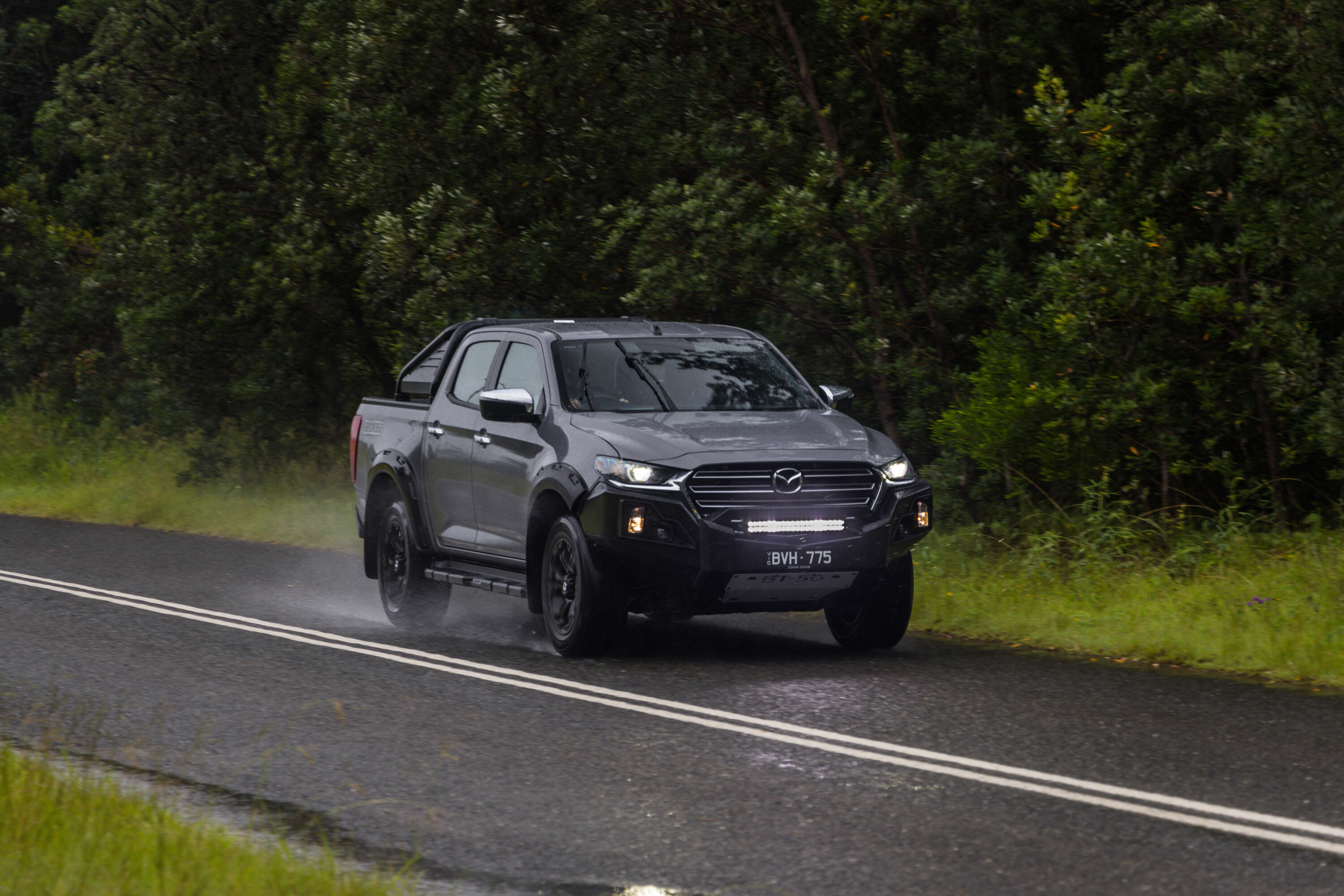
Power and torque delivery from the 3.0L engine does not stand out from the ute pack, with a similar functional nature that’s found in virtually all vehicles of this class. There’s a little more noise and clatter from the 3.0-litre turbo-diesel four-cylinder than the 1.9L but nothing unacceptable, while the automatic transmission is largely benign and smooth.
But with only six speeds, the auto is feeling its age among some rivals that are now bragging about seven, eight and even 10-speed offerings.
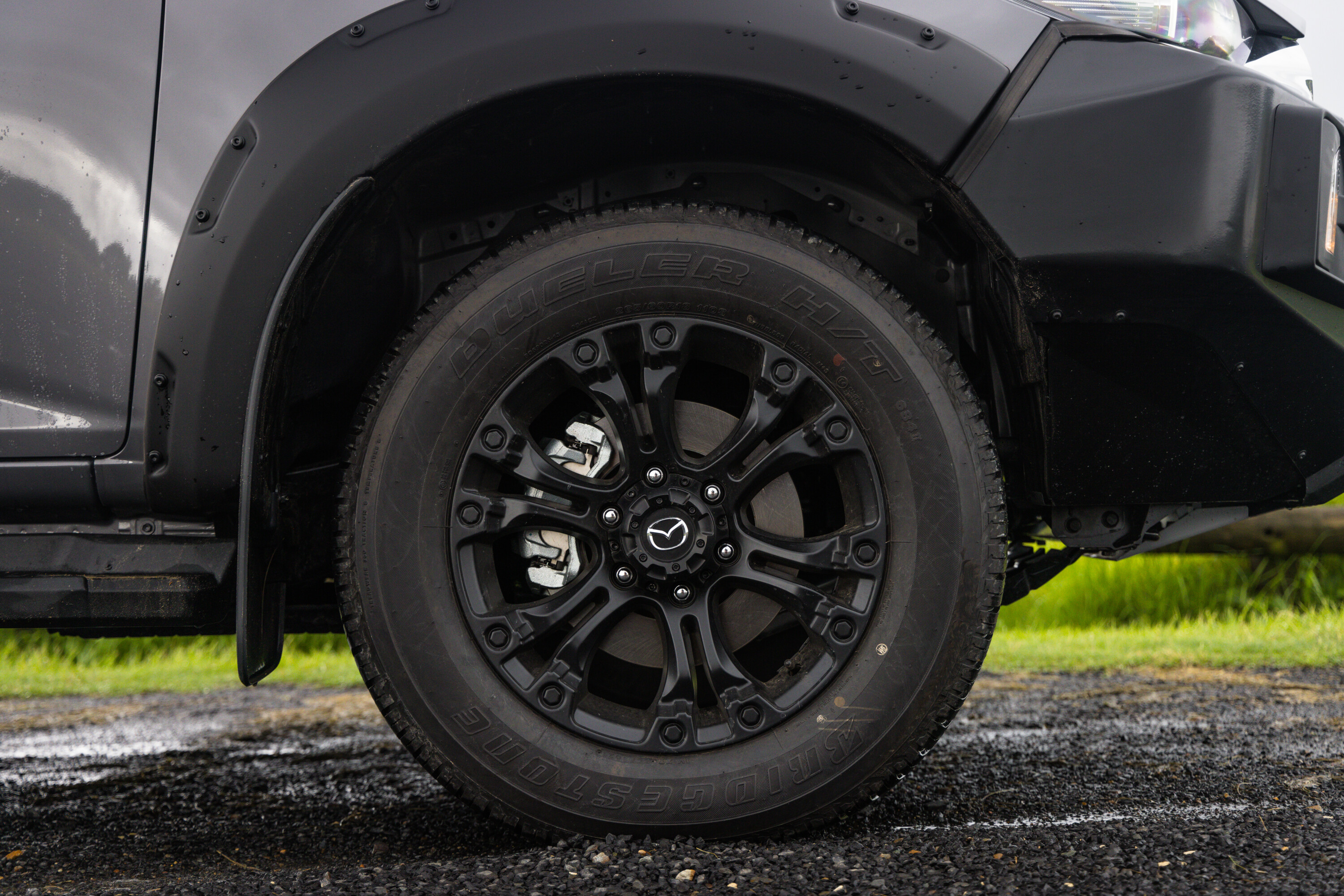
Automatic 3.0L versions have claimed fuel consumption of 8.0L/100km, while all dual-cab BT-50 models have a 76-litre fuel tank.
While the smaller-displacement 1.9L engine has better fuel economy, it does lack the bigger engine’s power and torque (by 30kW and 100Nm) as well as towing capacity (by 500kg). While it would only matter to a very small percentage of buyers, the 1.9L, in 4×2 or 4×4, is only available with an automatic transmission.
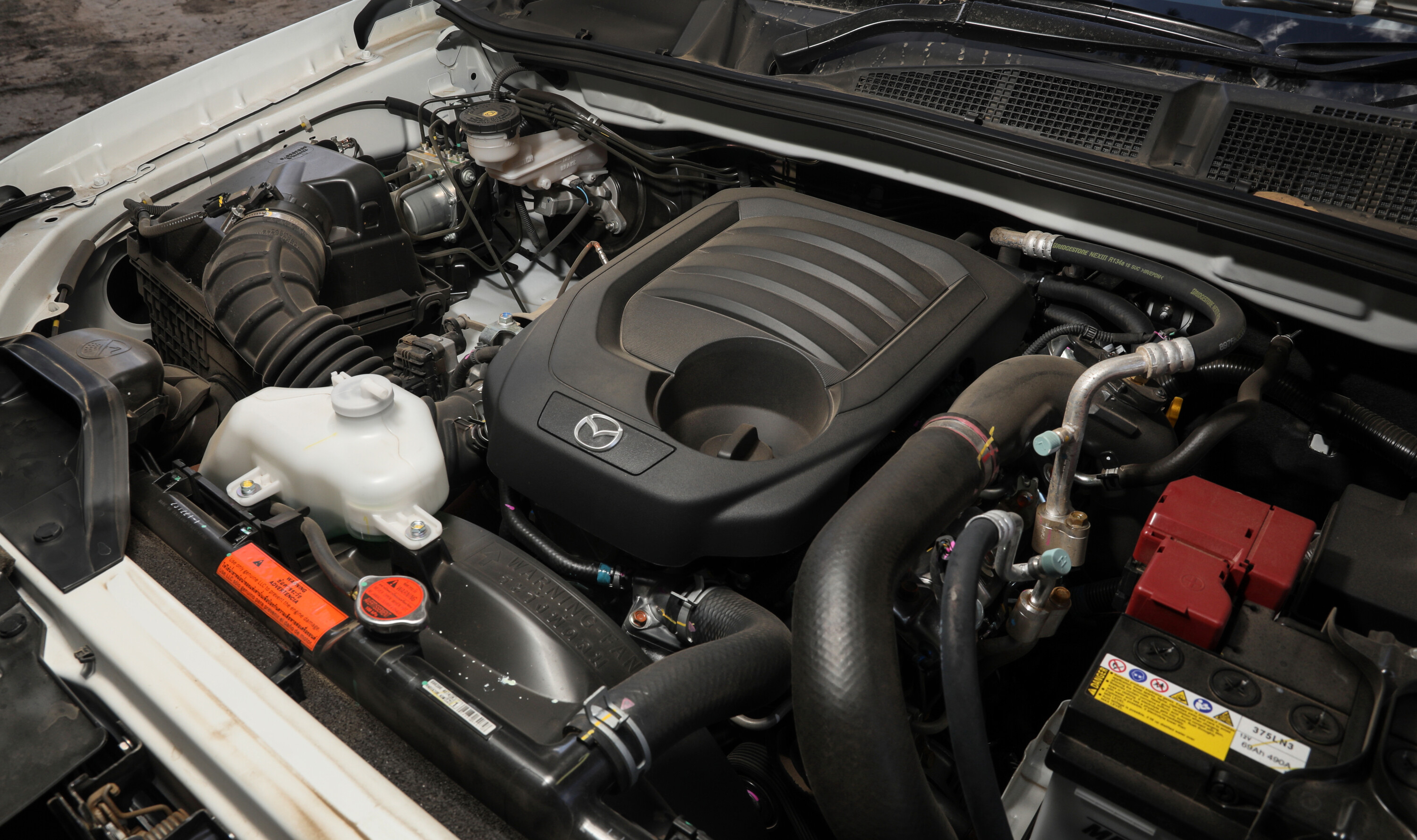
Payload ranges from 887kg in the Thunder to 1135kg for the XS 4×2 pick-up.
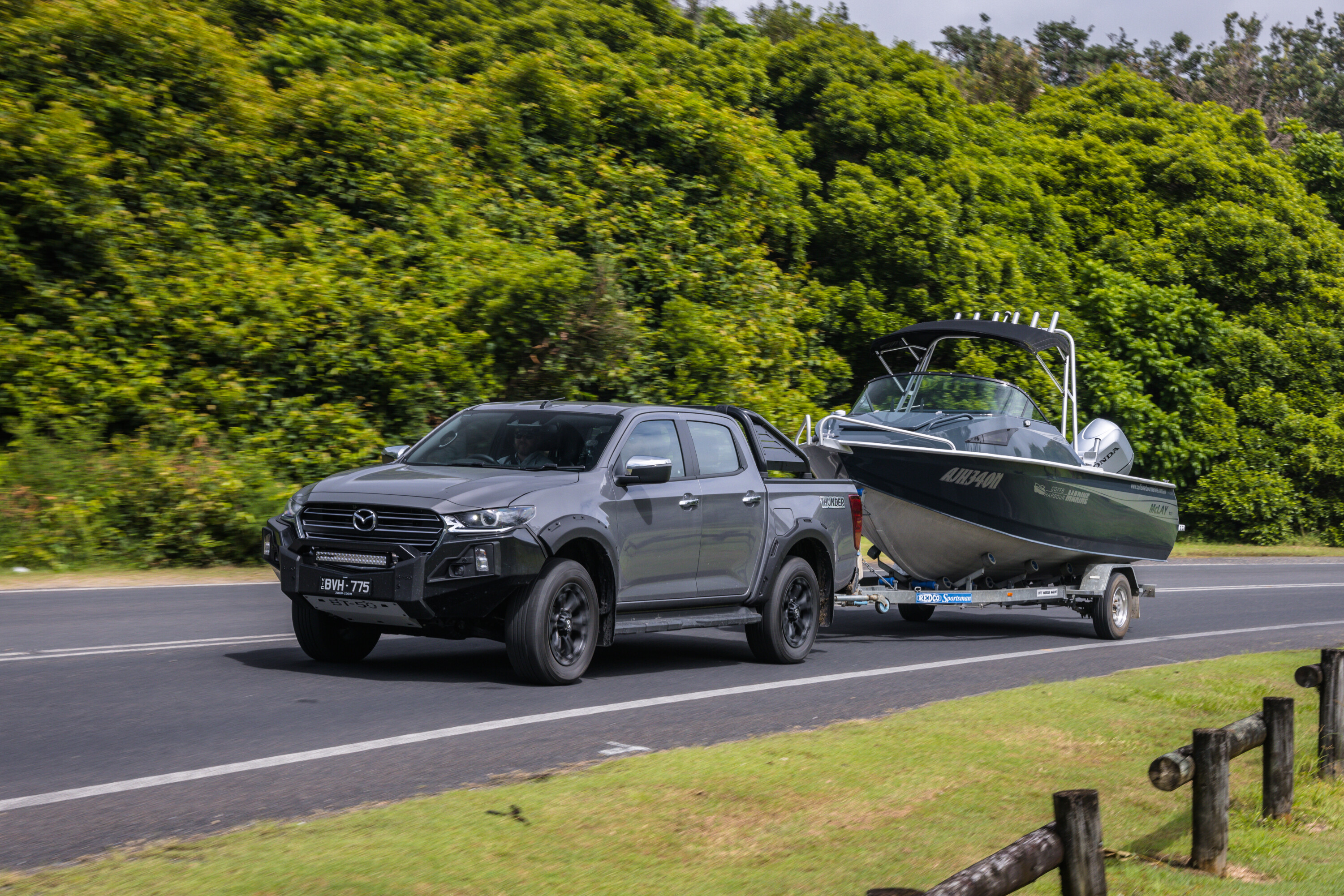
The BT-50 requires scheduled servicing every 15,000km or 12 months, whichever comes first, and the cost of each service ranges between about $330 to $700 depending on the scheduled requirements.
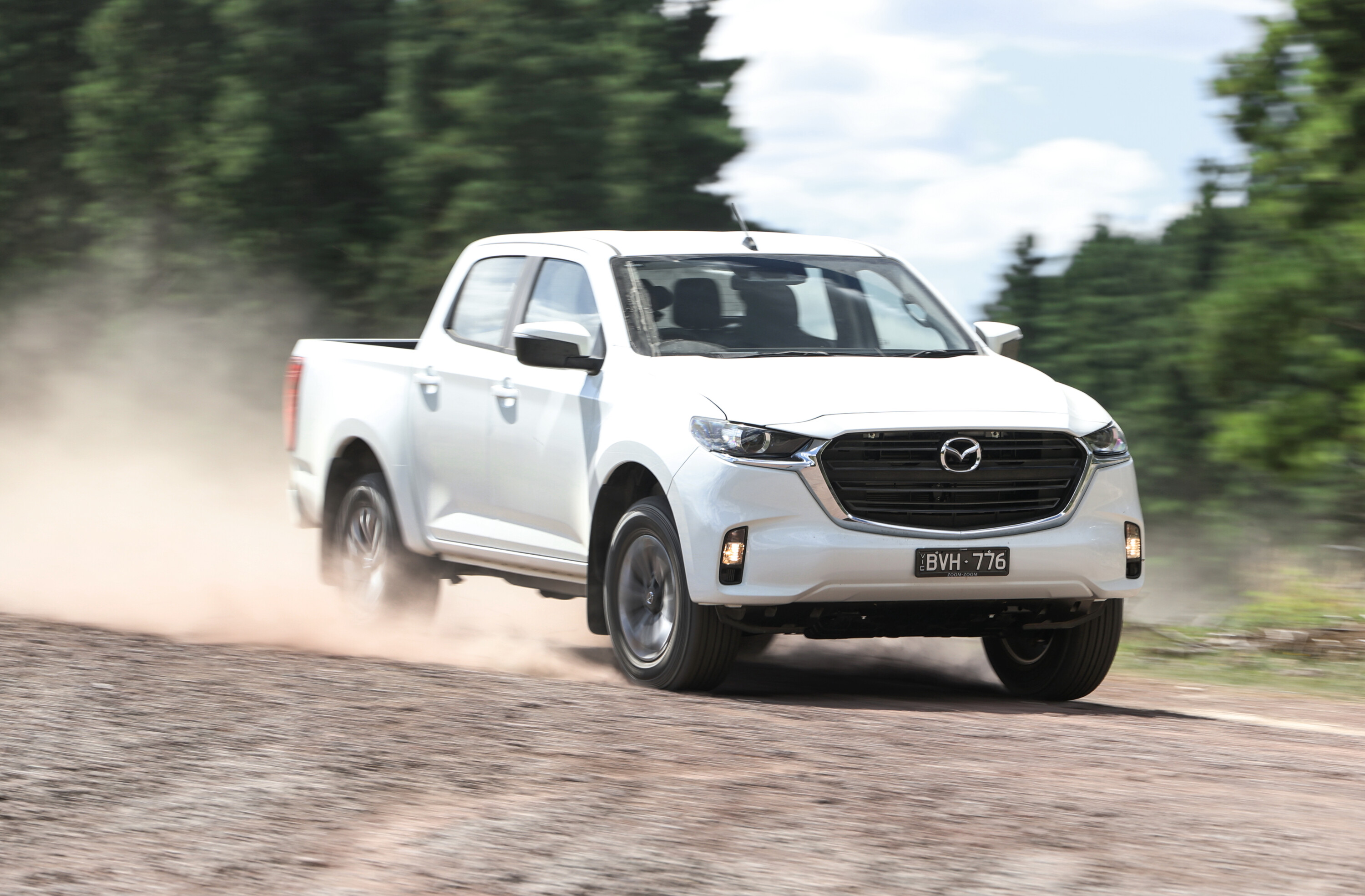
But once you add the 4×4 and automatic transmission options into the mix, it doesn’t appear to be as good value as the BT-50 GT, which costs barely more than $3000 extra and gives the best features per dollar spent as well as the highest-spec powertrain.
You don’t pay extra for 4×4, or the automatic transmission, and get added safety with front parking sensors as well as the nice-to-have heated front seats, (plus power adjustment for the driver’s side) and leather upholstery.
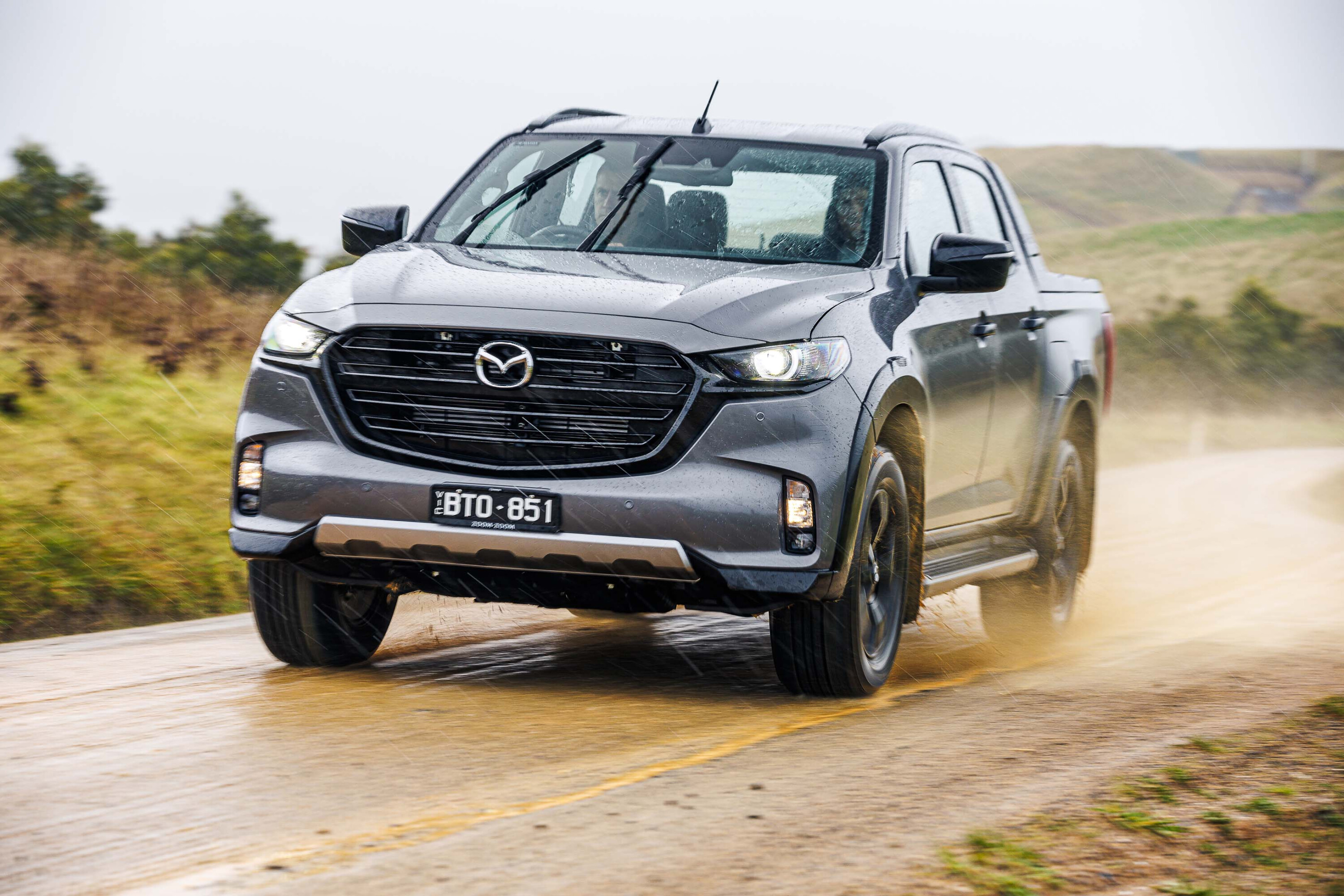

It will be squarely aimed at drivers wanting an unpretentious, capable and tech-filled wagon. And its 6.2-litre V8 is certain to appeal to those looking to tow across the great southern land.
Set to arrive in 2025, the introduction of the GMC Yukon is the brand’s attempt to expand outside of North America, where the Yukon has seen success as the best-selling full-size SUV, snaring 38.4 per cent of the market in Canada.
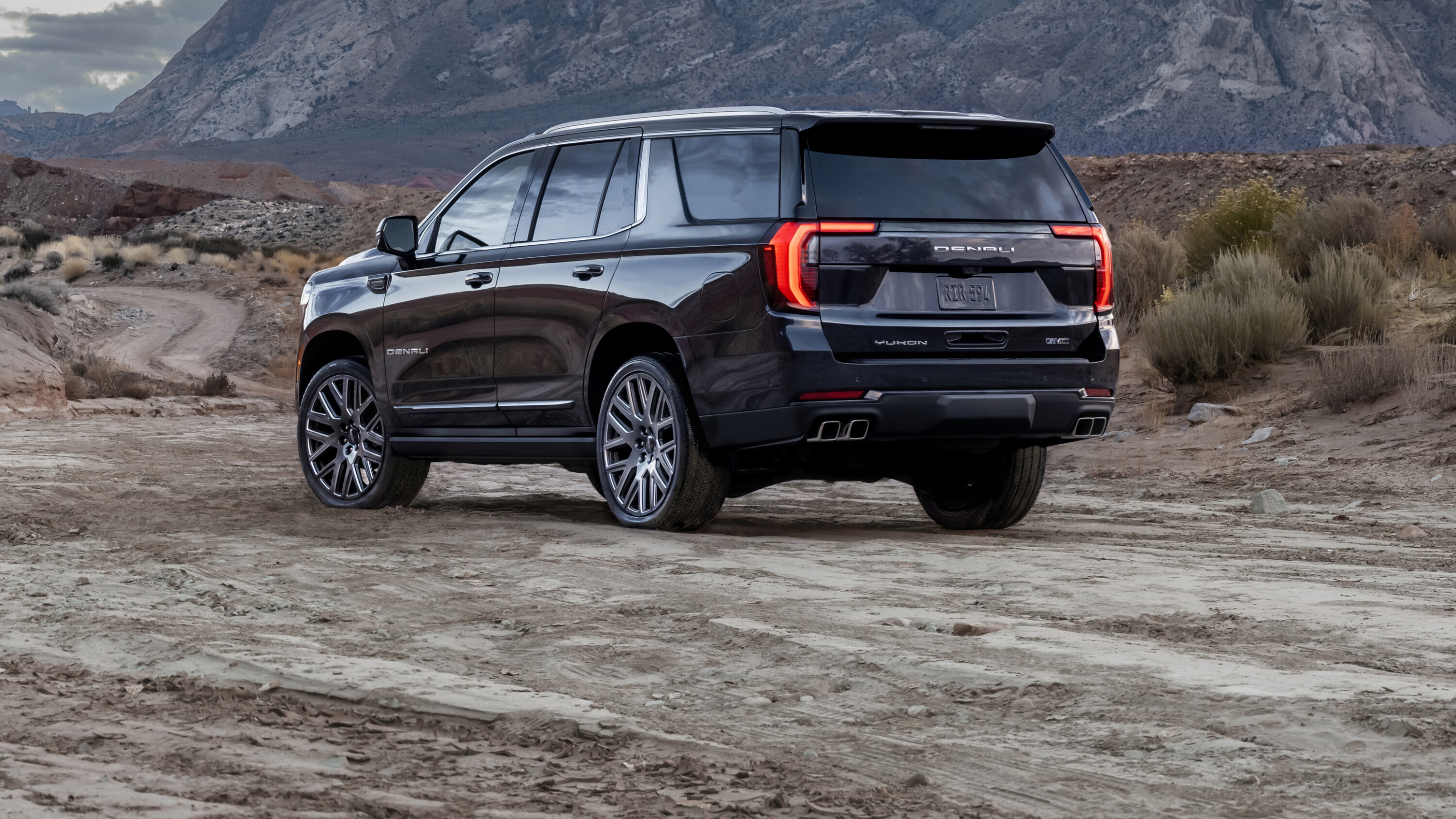
This is on top of recent achievements, with the model seeing record sales in the first half of 2024, and its best June sales since 2005. As a result, GMC considers the time right to grow the brand and aims to introduce the large SUV to Australia, New Zealand and China.
Riding on enormous 24-inch wheels, GMC highlights that the design of the Yukon is aimed to enhance its presence on the road, horizontally stretching a lot of the elements such as the grille and lights across the car to accentuate the car’s muscular stance.
An extra detail, and keeping with the regional naming theme, the GMC badging on the grille and the interior dash features the embossing of a topographical map of the Denali range that borders the Yukon in Canada.
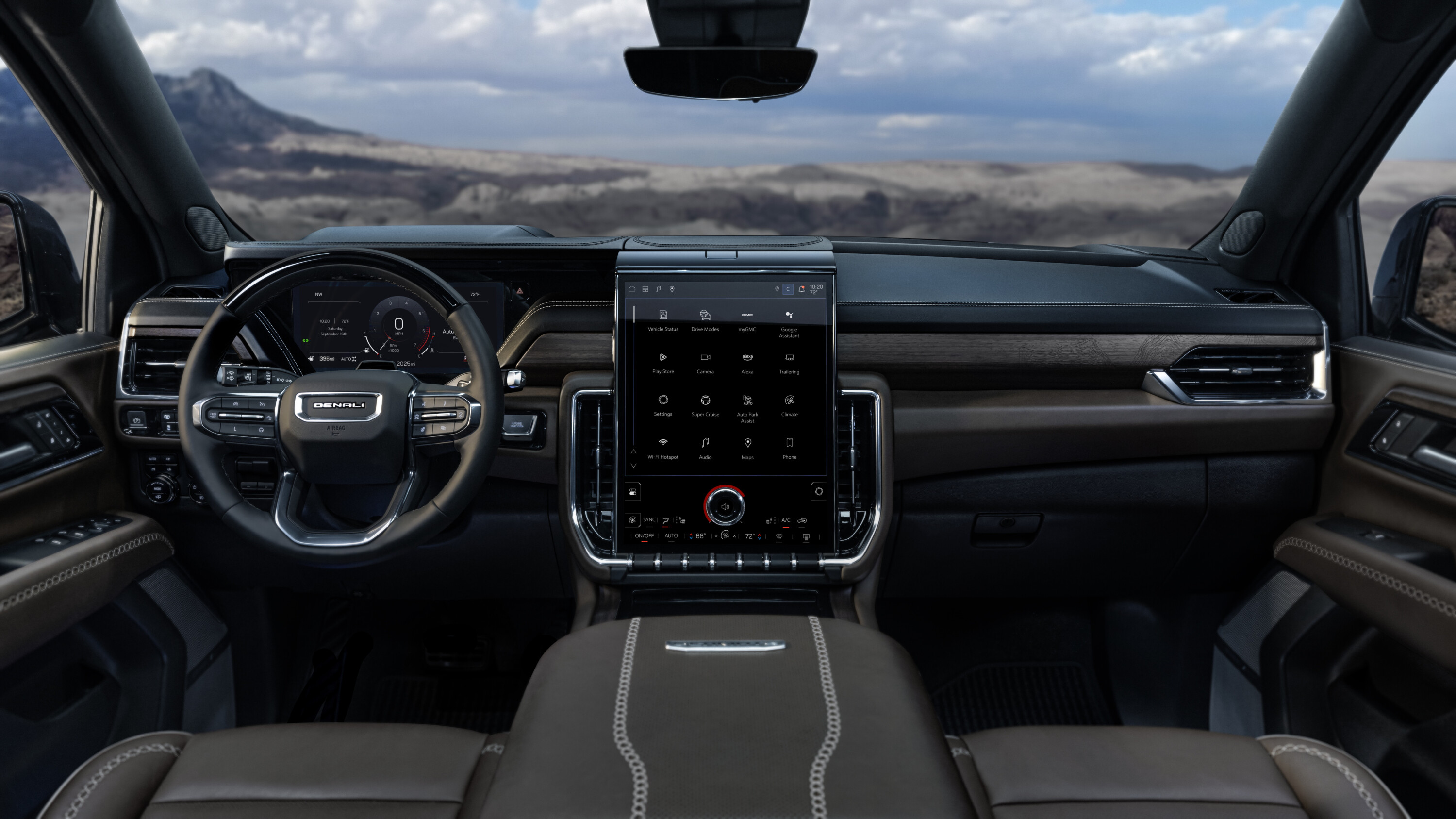
The Yukon’s premium interior includes leather throughout, a large 16.8-inch infotainment touchscreen, panoramic sunroof, head-up display and Bose speakers in the headrests. Ensuring that the rear seating is equally as luxurious as the front, the second row includes captain’s chairs with the same leather seating and Bose speakers in the headrest.
Conversion to right-hand-drive is said to be handled by the Walkinshaw Group, capitalising on its extensive experience with other large vehicles such as the Chevrolet Silverado as well as the sportier Camaro.
The offer only applies to private and business (Bronze and Silver fleet) customers, and all finance applications must be lodged and received by September 30, 2024, and settled by December 31, 2024.
The deal is limited to one offer per finance contract, and the minimum finance amount is $10,000.
The Toyota HiLux was the third best-selling vehicle in Australia in July, behind only the Toyota RAV4 and Ford Ranger. A total of 4747 sales were registered for the month, 168 shy of the Ranger which ended with 4915 sales.
The lion’s share of those sales are 4×4 variants (4125), with only 622 buyers opting for the 4×2 models.
As of the end of July, a total of 29,105 HiLux 4x4s have been sold so far this year, making it the second best-selling 4×4 vehicle behind only the Ford Ranger (35,230 sales).
They created incredible undercover art galleries of their world including games, animals and dreamtime gods, and left behind the handprints of bored children in cave shelters when the rains tumbled down and the storm gods roamed the skies with displays of lighting and thunder that struck fear in the hearts of humans.
It’s all recorded in the art friezes, including one that I came across in western Arnhem Land depicting a lightning strike that killed a woman. But many are of hunters spearing animals, warriors engaged in battle with crocodiles, snakes and fish.
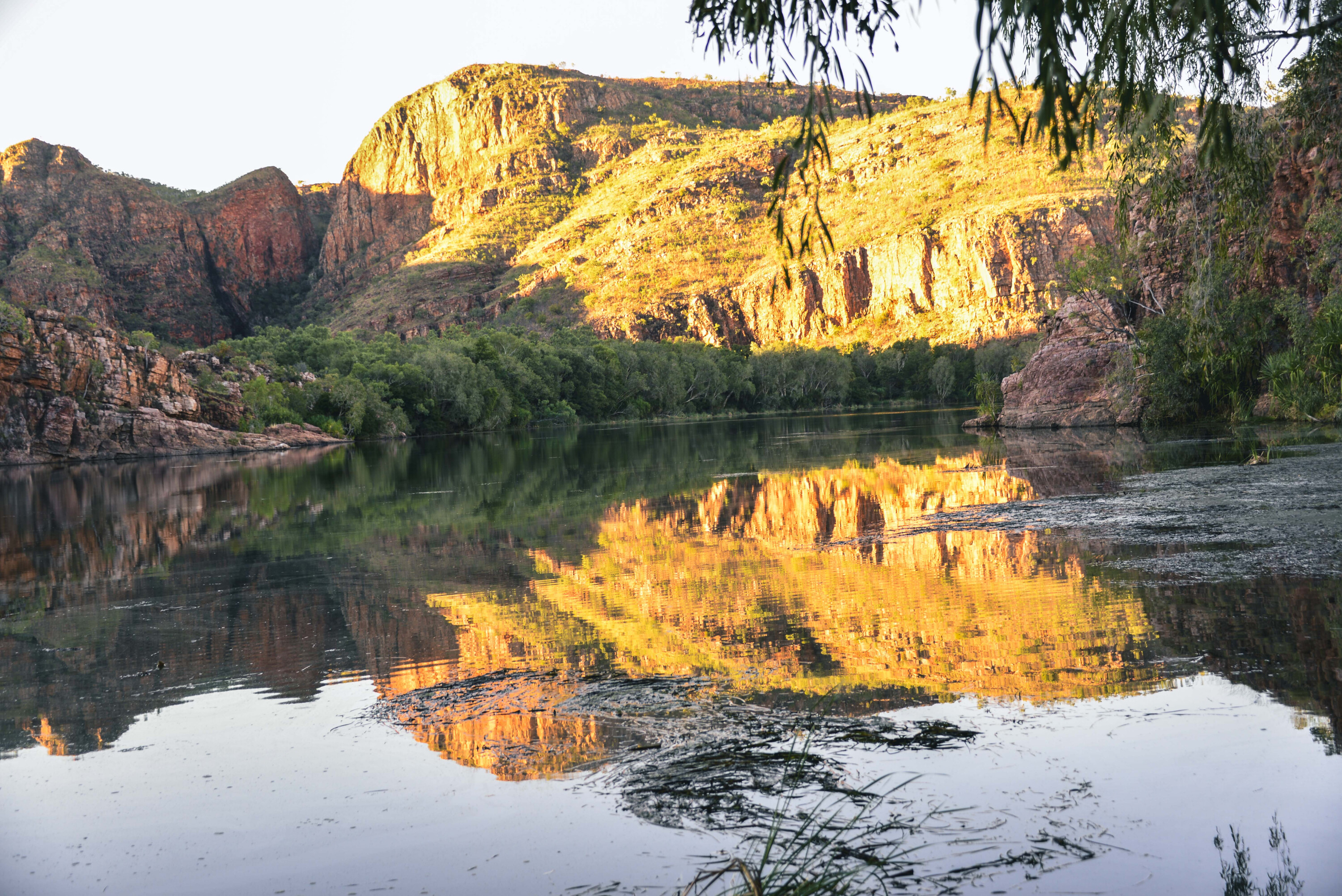
The discovery led to others nearby and elsewhere in the ancient spinifex-clad ranges of the Cloncurry-Mount Isa mineral field, a region of sandstone ranges dating back to the Precambrian period that stretches into the western Gulf country and continues into the NT.
I lived in Kakadu for a decade, a place of legendary dreamtime beings that are well documented in hundreds of rock art galleries where the monsoon woodlands fringe the Arnhem Land Escarpment and its many outliers. None were open to the public in the early days, there was no policing with people exploring the region at will.
We respected the art of the ancients and none of it was damaged when Kakadu National Park was declared in 1979, which also signalled the go-ahead for the Ranger Uranium Mine where I was employed first as the Information and Housing Officer, and later in the emergency services section.
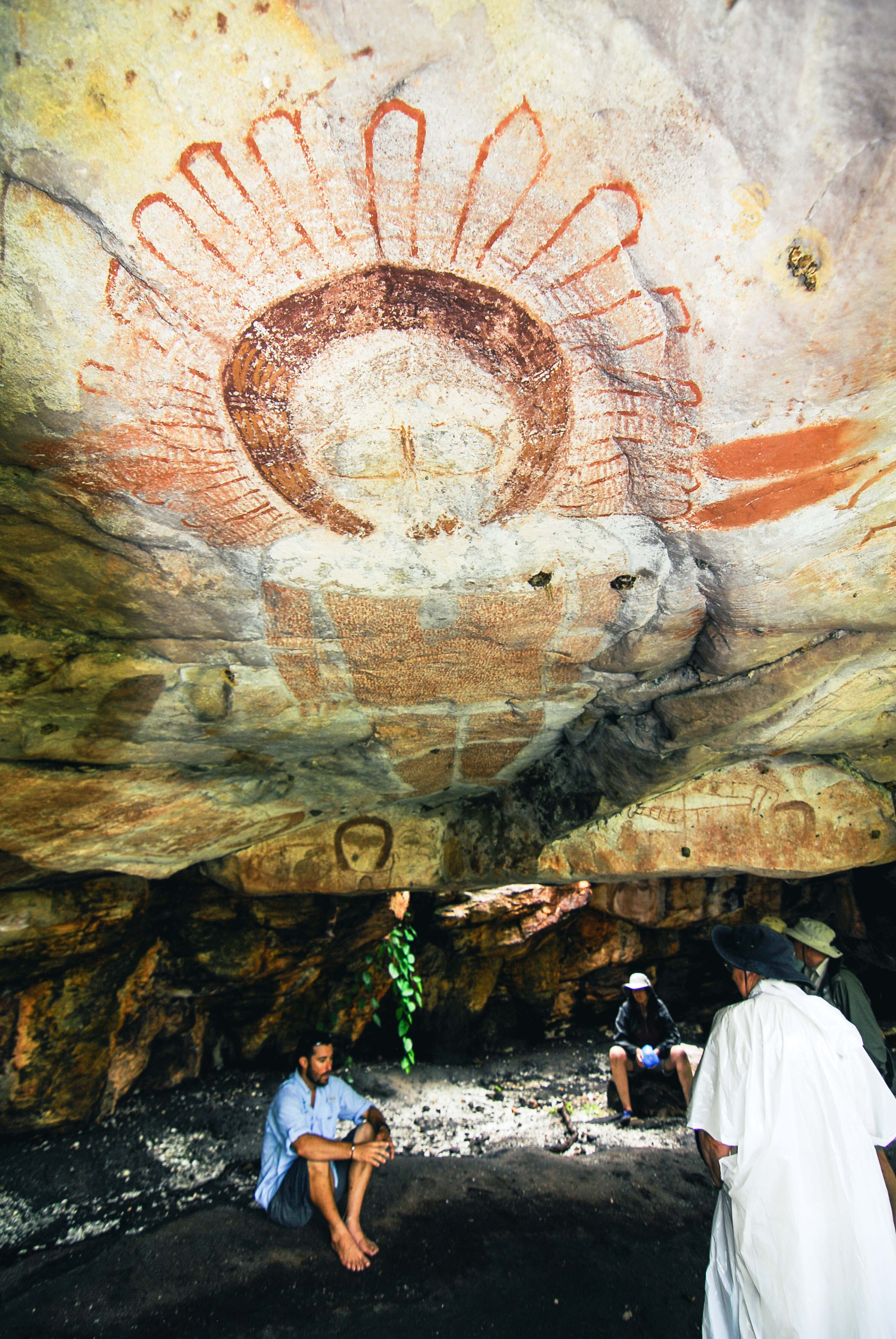
I moved to the Daintree Rainforest in 1989 and operated my own tour operation out of Port Douglas before selling up and heading into semi-retirement, but when the chance came to conduct bird-watching operations for the Arnhem Land Barramundi Nature Lodge, south of Maningrida, I spent many dry seasons there taking birders into the monsoon woodlands and on the vast tidal rivers enjoying nature like nowhere else.
Conditions were such that a native guide would always accompany us to ensure we did not intrude into sacred places and other areas of significance. They were good years and under the guidance of my Indigenous brother, Stuart Aiken, I saw country that was out of bounds to others.
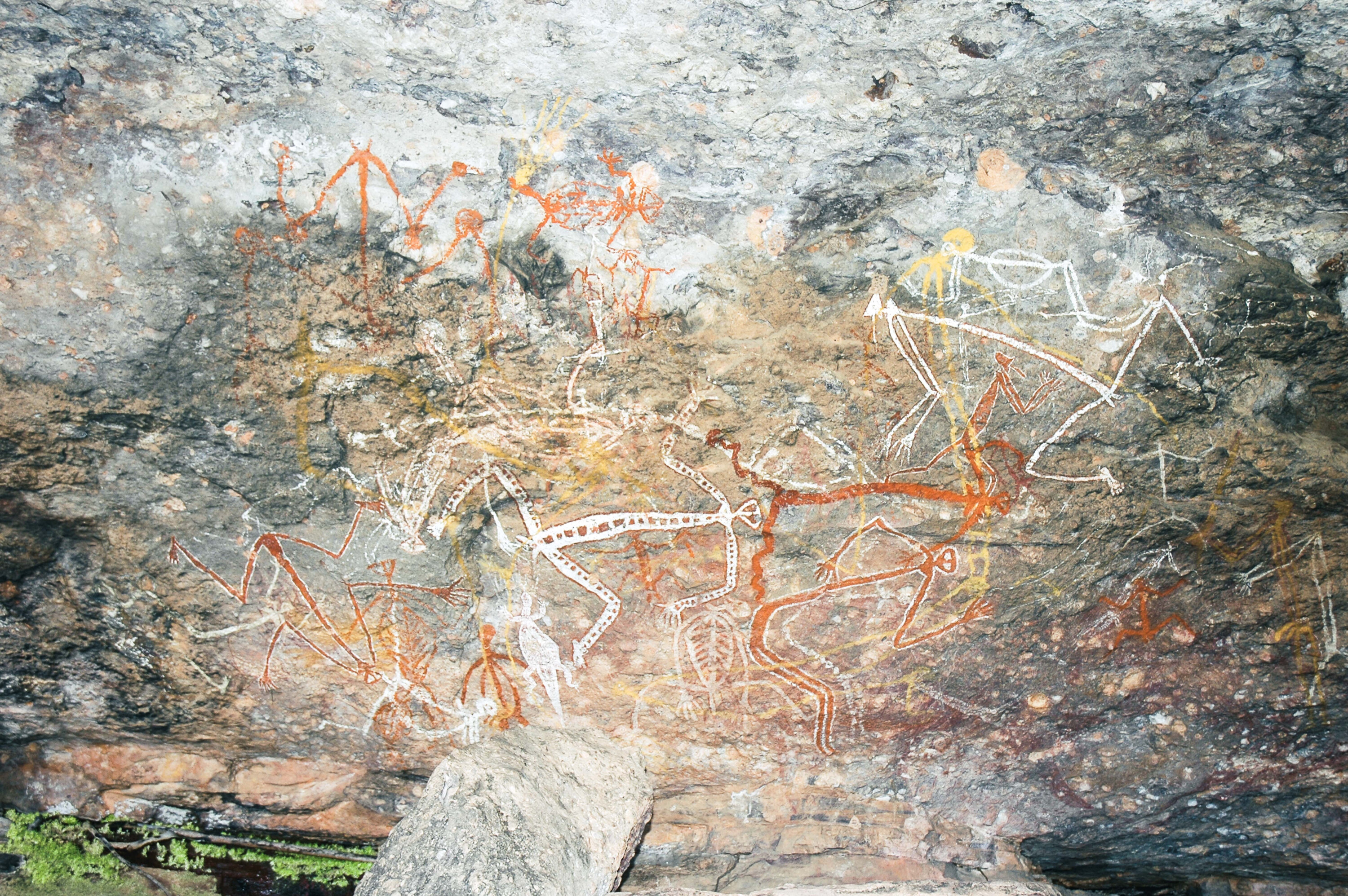
The sandstone massif has thousands of rock art sites, many that have never been seen by living humans because the natives moved away into missions from the 1900s onwards.
Few tracks turn onto the plateau and there is only one semi-permanent settlement on it. Like elsewhere in Arnhem Land, homelands, or outstations, are abandoned at the start of the wet season, and dogs and animals are left behind when people head to the permanent villages to outsit the tempest.
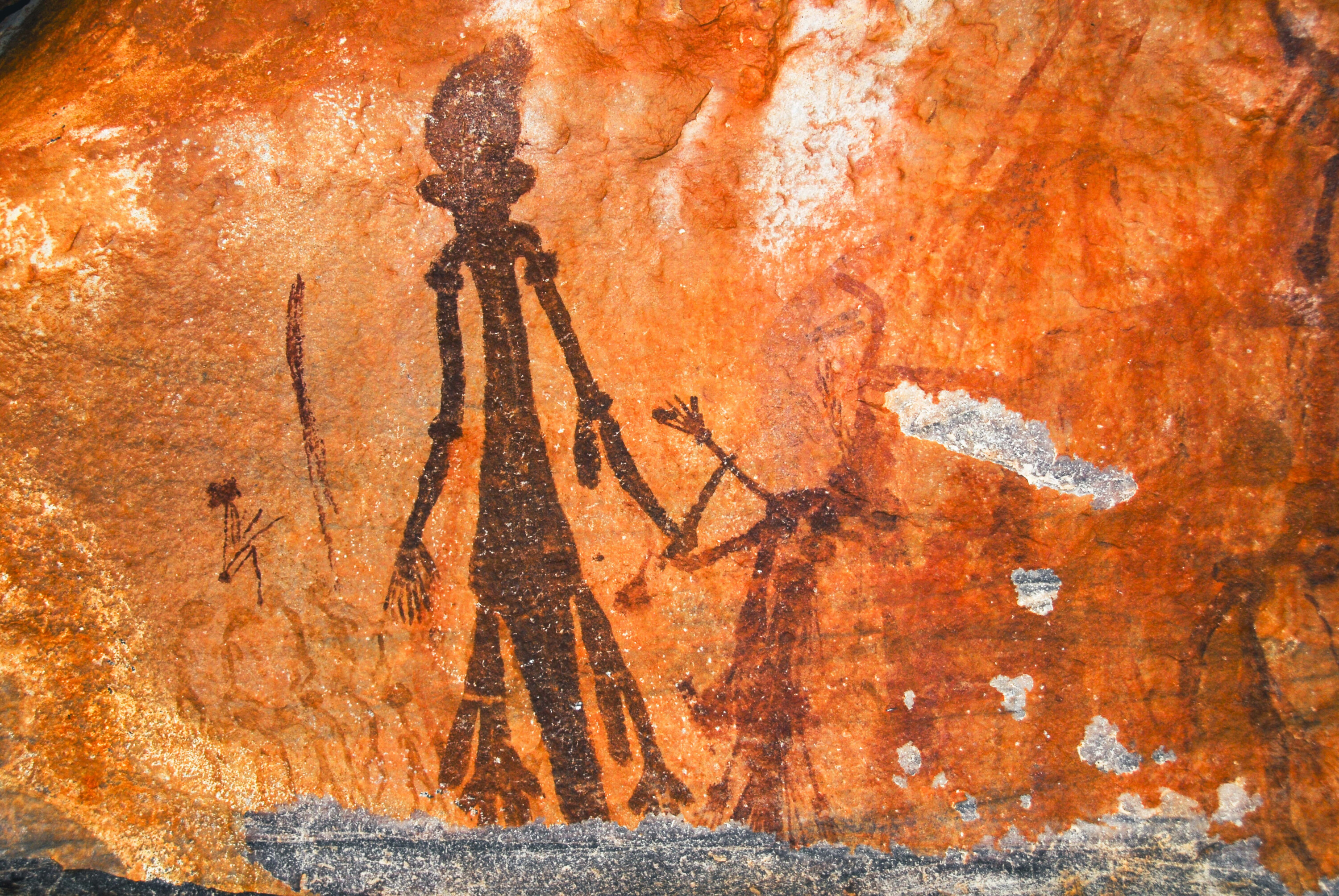
I had a scientist on one trip who was so impressed that he organised his own expedition to study the paintings.
Our early season tours were the best, when tracks were still damp and no one lived at the outstations where dozens of howling kelpie/dingo cross dogs would welcome us as we drove en route to the distant red-brown bastions of the stone country looking for rare birds. It beats me how the dogs survive months of abandonment.
Birdwatchers are interested in all things nature, thus the paintings that were under the overhangs and shelters of the sandstone outliers below the 80m high escarpment were often of more interest than the birds themselves. I had a scientist on one trip who was so impressed that he organised his own expedition to study the paintings. Typically, he claimed that he had discovered them in an article in the Bulletin magazine.
There were also burial caves where the bones of the deceased were stored in paperbark wraps and in hollow logs, and elsewhere the bones littered the cave floors.
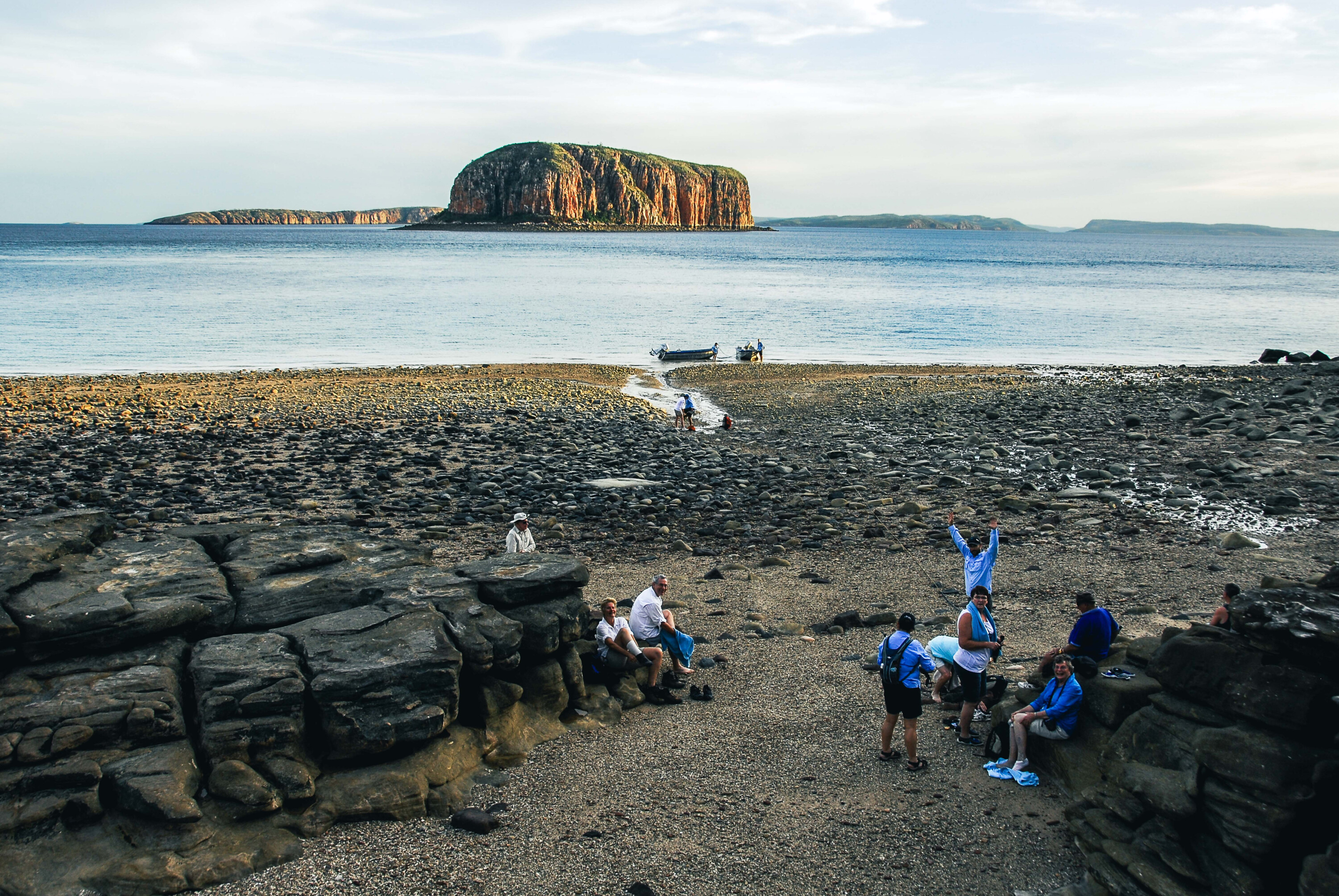
I have seen similar sites on the Victoria River and in the Kimberley, some marked at the entrance by paintings of death adders in striking positions; those were out of bounds to all and required a special dance song for entrance. In Arnhem Land we were told to talk loudly when nearing some sites so as not to startle the spirits by our sudden appearance.
The Stone Country rock art is amazing and depicts animals, fish and reptiles that are of significance to the local clan or as a food source. Various ochre colours are used; the ochre is crushed and ground from rocks and mixed with water, fish and animal oils.
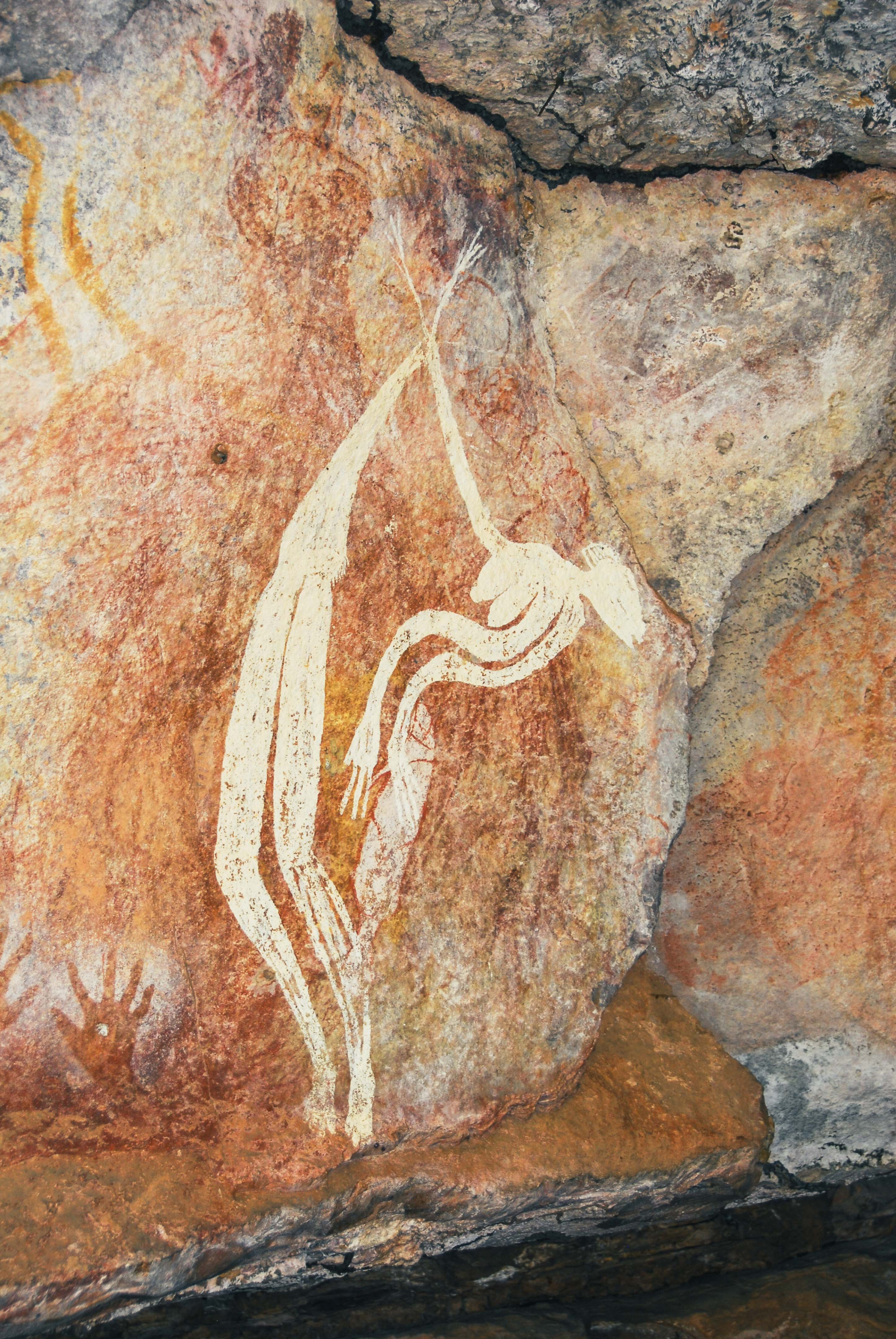
It’s the fish oil that permeates into the porous sandstones and drags the ochre colours with it enabling the paintings to last for thousands of years.
The are few paintings in basalt country because it is continuously breaking down and peeling, while limestone shelters have few smooth surfaces and it is too hard for fish oil to penetrate. This is why sandstone hills have the best and most durable paintings.
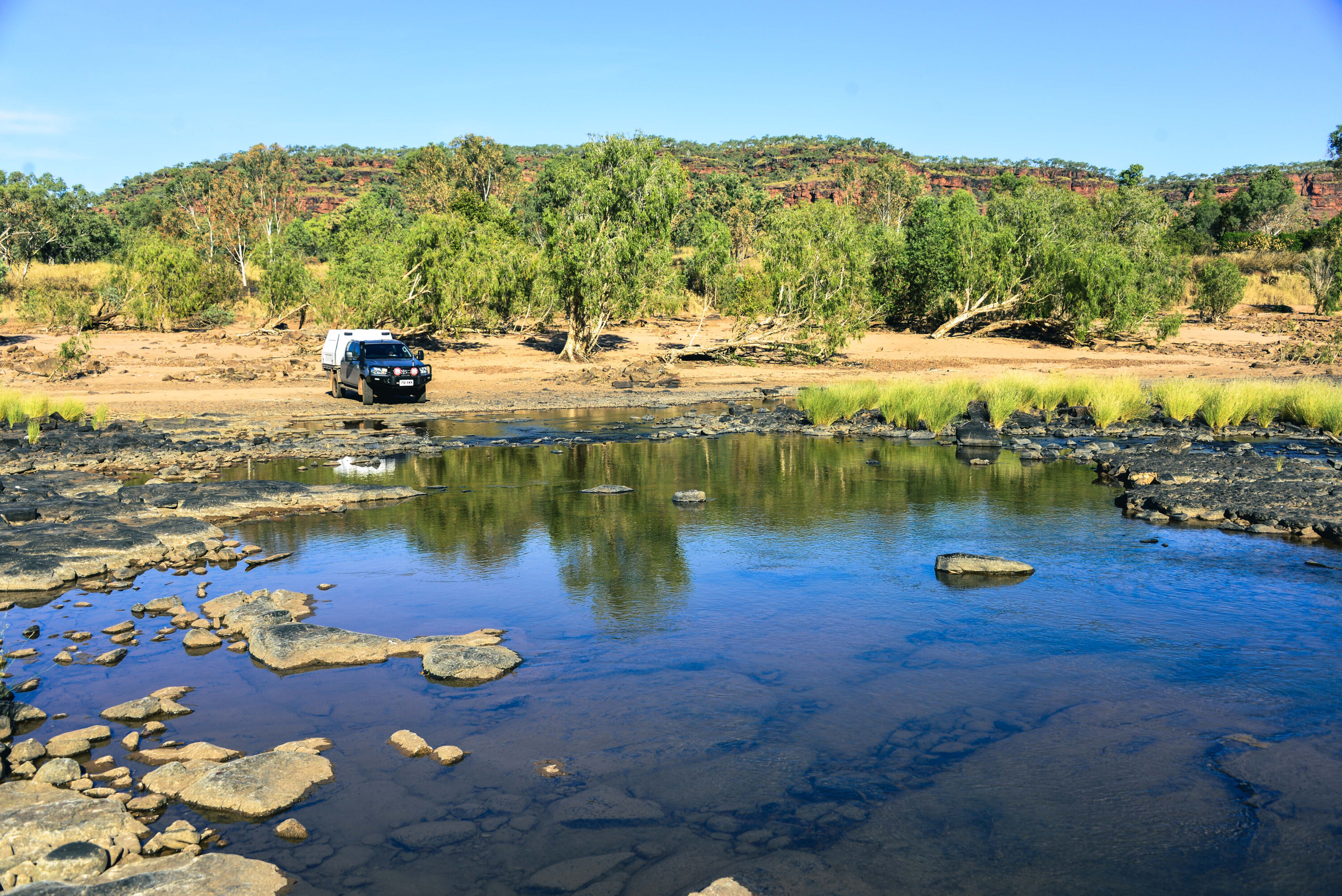
Several Laura Quinkan rock art galleries are open to self-guided tours, while others require the services of a local Indigenous guide. The galleries are amazing in their variety of subjects, size and locations. Elsewhere on the Cape you may find isolated sites in the sandstone ranges, but few have been registered.
The Cloncurry-Mount Isa region has many sites that are reached on rough bush tracks, while to the ancient sandstone ranges run northwest to Arnhem Land with Constance Range on Lawn Hill Station having wonderful art sites and burial caves, including the Lawn Hill NP, which includes Riversleigh Station.
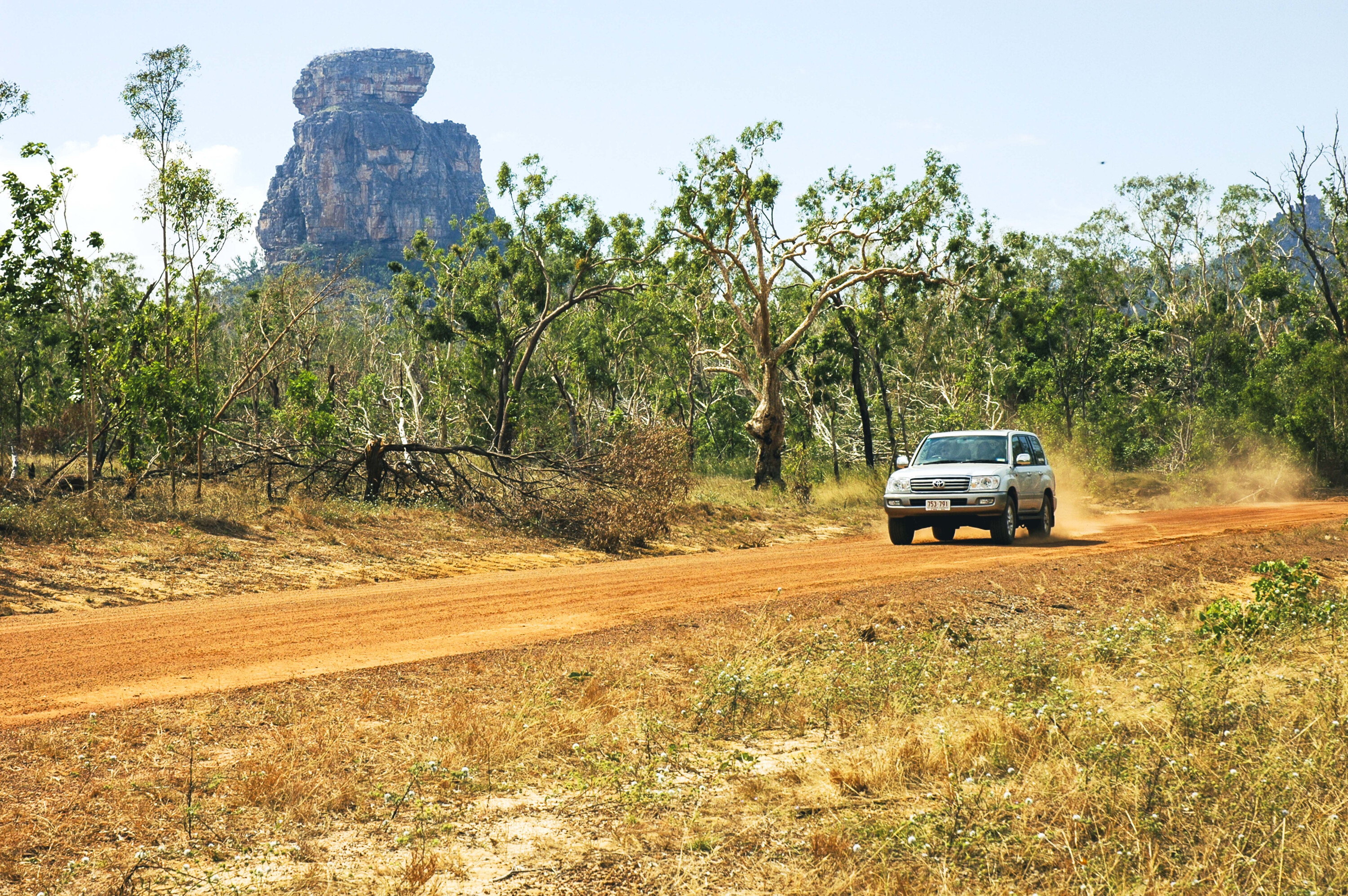
There is ‘lost’ art in the ‘Lost Cities’ south of Borroloola, and those in the Limmen Bight NP. In fact, most cave shelters here and to the north have art of some description, proof that the region had an abundance of food and water that once supported many people.
Arnhem Land is a pure wilderness and almost every rock overhang and every cave have paintings, including the southern outliers along the Roper River Highway and the roads leading into Arnhem Land proper. I have stopped near small rocky outcrops and found shelters that people once lived in, the walls blackened by smoke from campfires, others adorned with paintings and sketches.
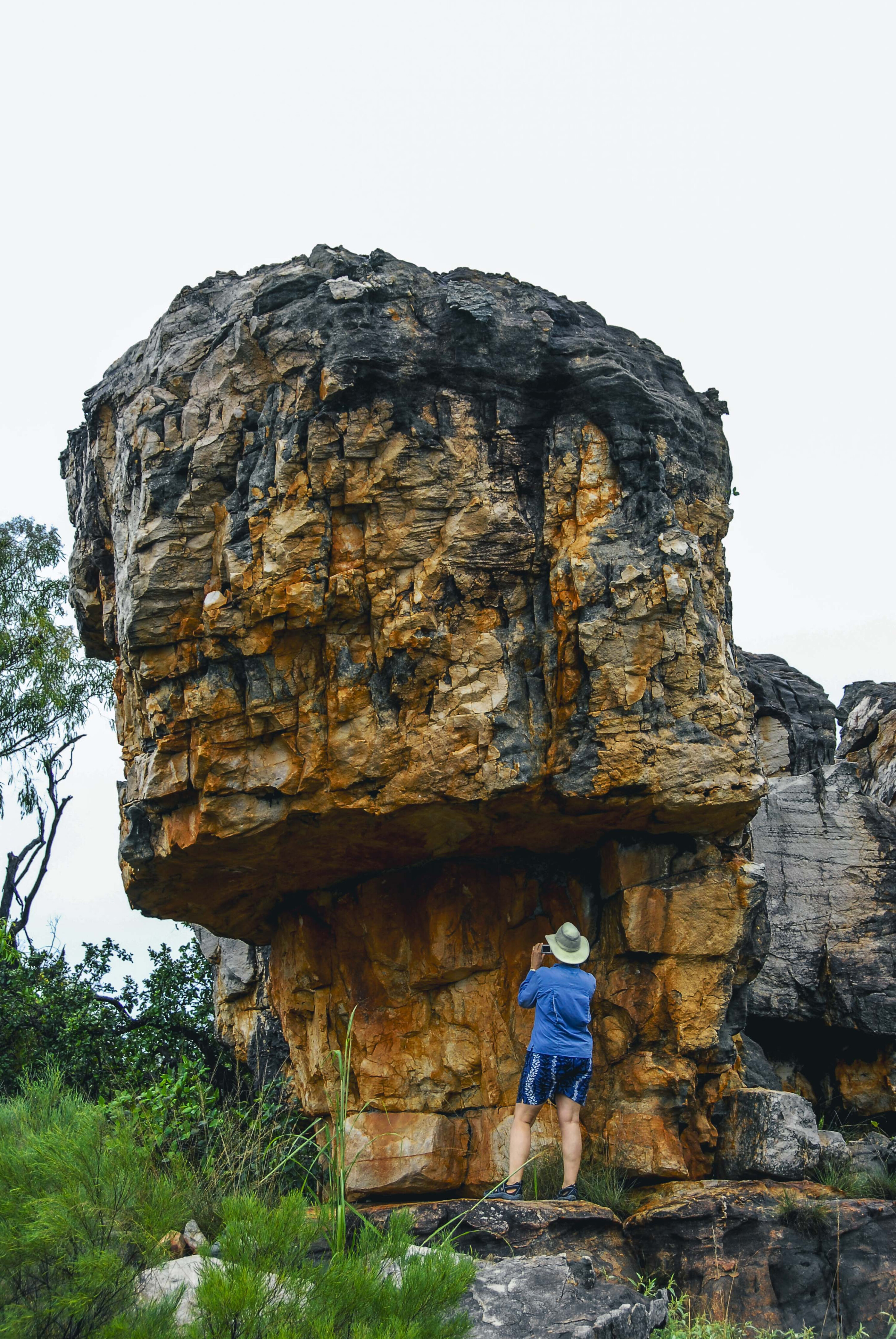
Kakadu is arguably the best place to see cave art as many galleries are open to the public including the magnificent Ubirr and Nourlangie sites, while others require a guide.
En route to the Kimberley, the Victoria River region has a huge sandstone escarpment where the history of the people is well displayed in numerous galleries that spill all the way to Derby, but the best art is on the Kimberley Coast and can only be reached with a sea-going vessel.
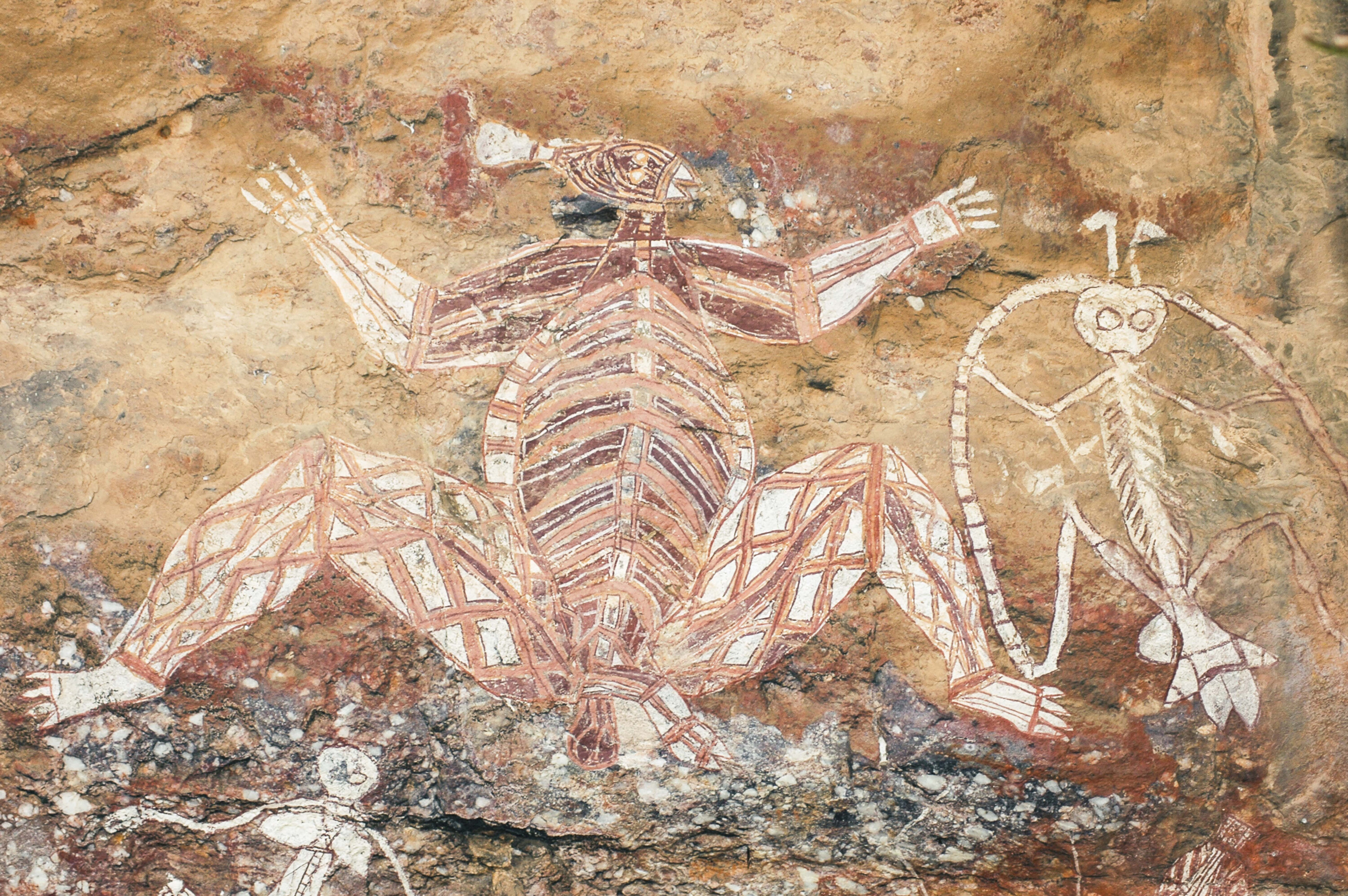
The Kimberly art is different from others and includes both Wandjina and Bradshaw styles, the latter spirit stick figurines somewhat similar to the Mimi stick spirit beings of Arnhem Land.
Some sources claim that the rock art of the Kimberley and Kakadu is over 65,000 years old, but this is not backed by academics, so don’t get carried away by the nonsense talk of some guides and other information sources when viewing art sites.
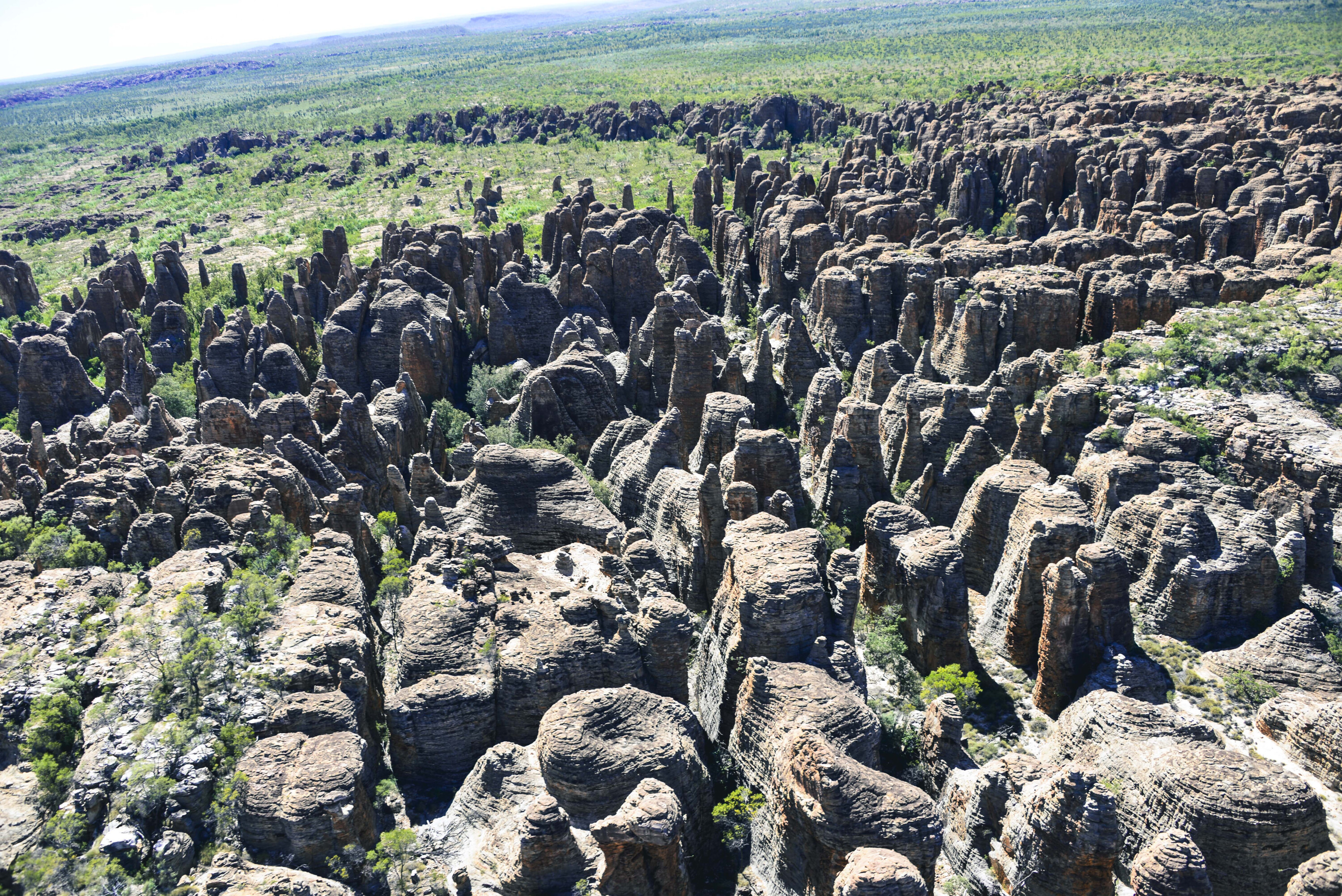
I guess us laymen and lovers of all things nature will never know. Personally, I ignore the scientific data and just enjoy the moment and the artistic skills of an ancient people who lived in rock shelters and caves during the wet seasons, and who were bored to tears with little to do, so they painted to pass the time.
And that, my friends, is the gospel as told to me by several Indigenous mates.
A reliable 4×4 is needed to reach most rock art sites, although some involve hiking long distances. Sites are generally located near permanent and semi-permanent waterholes. Some sites have extensive middens comprised of bones and shellfish, and are an indicator that people lived well.
Quadbikes and trailbikes are a good way to get about the rugged sandstone ranges that art sites are located in, with most under the lee of escarpment walls and in wild gorges. In many areas permission and permits must be sought from traditional owners and landholders, though rarely in national parks.